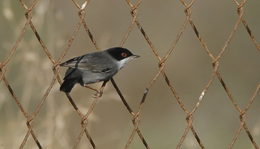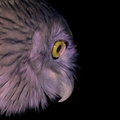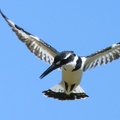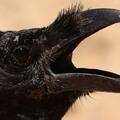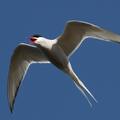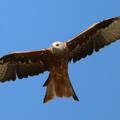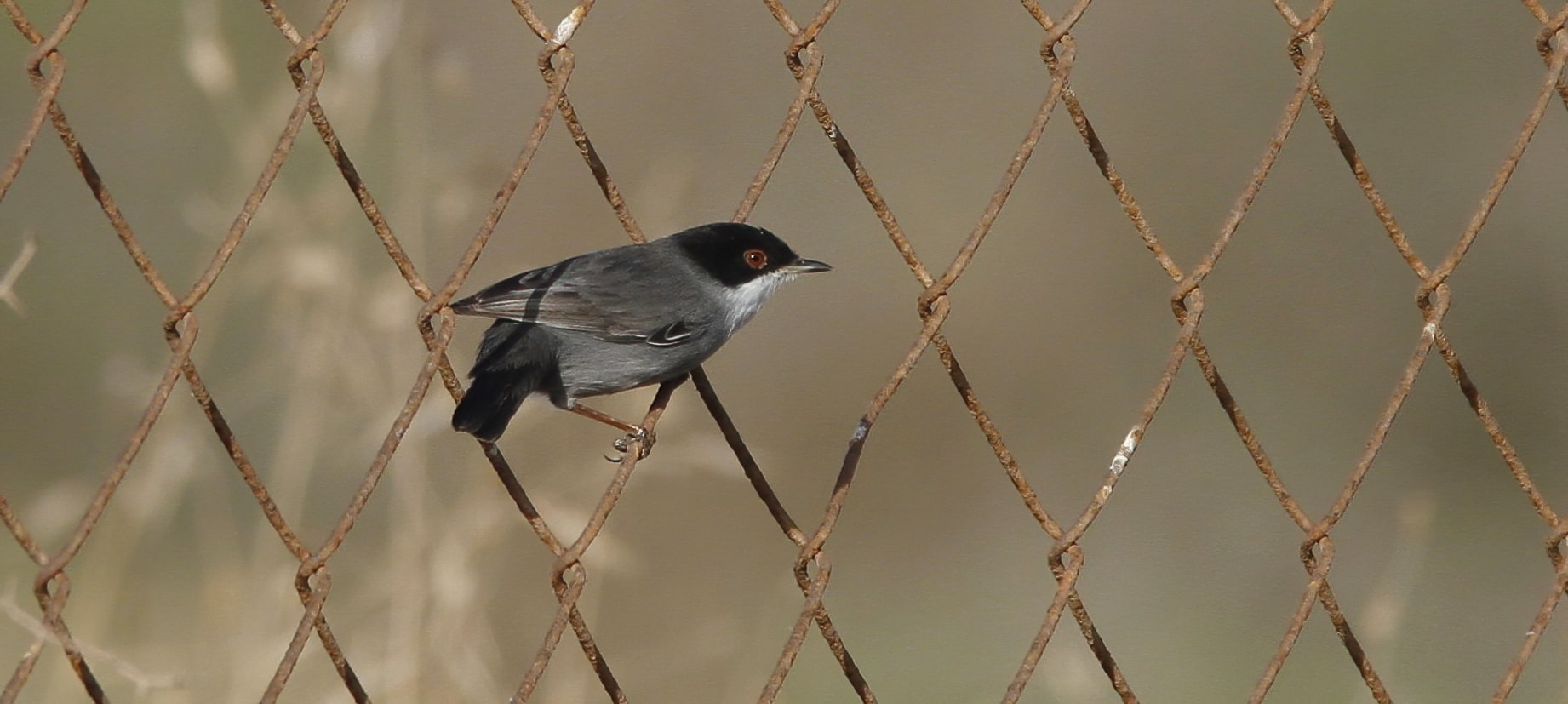
Curruca melanocephala melanocephala -  Sardinian Warbler
Sardinian Warbler 
![]() toutinegra-dos-valados
toutinegra-dos-valados  kucsmás poszáta
kucsmás poszáta
(Tavira, salt pans)
● the most abundant sylviid species in the Algarve, widespread and common in every habitat vegetated by shrubs
● found in their largest numbers in roadside shrubs and plantations of Vilamoura and the shrubby coastline of Quinta de Marim
● usually stays invisible behind dense vegetation and only appears for moments
● a short alarm call of the Sardinian Warbler:
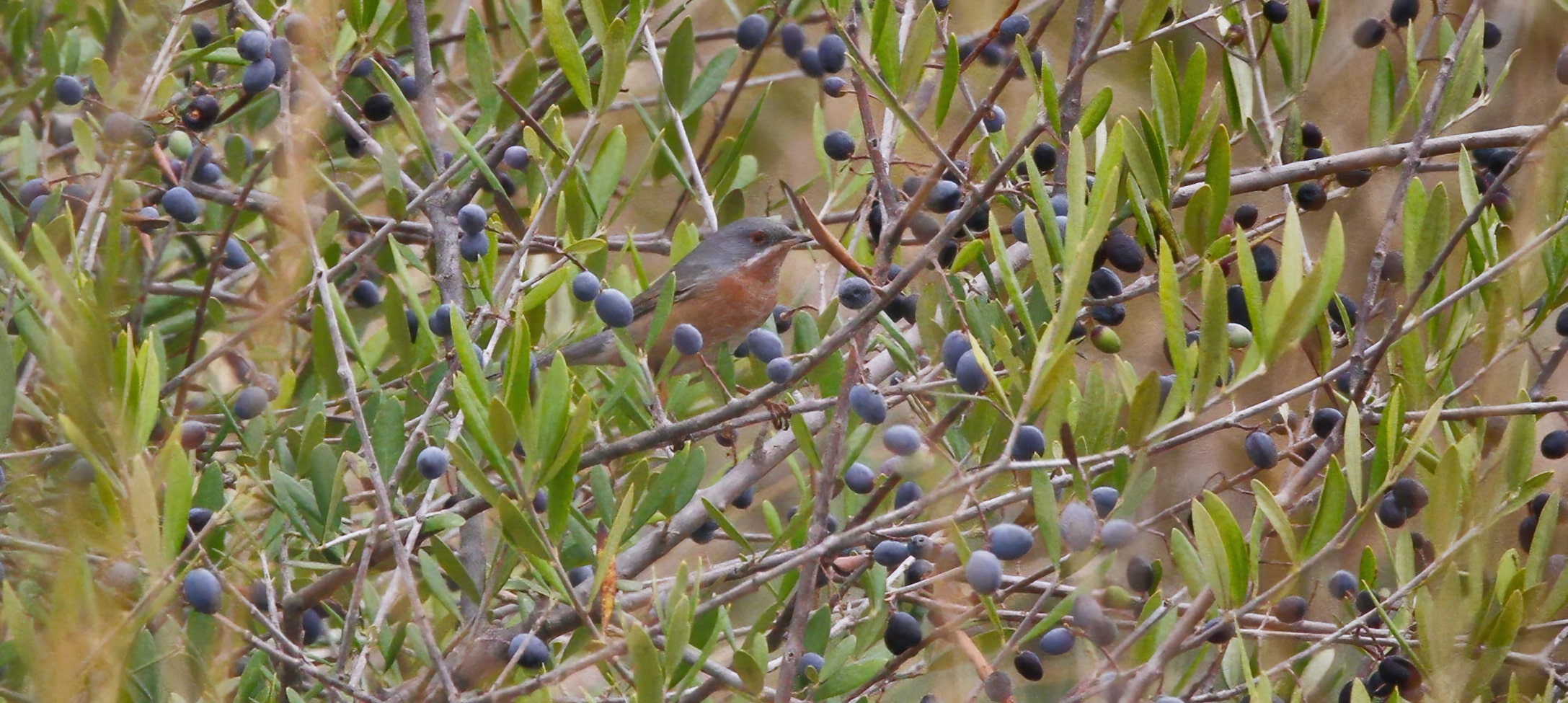
Sylvia (inornata?) cantillans iberiae
Curruca iberiae -  Western Subalpine Warbler
Western Subalpine Warbler 
![]() toutinegra-carrasqueira
toutinegra-carrasqueira  ibériai bajszos poszáta
ibériai bajszos poszáta
(Castro Marim, Esteiro da Carrasqueira)
● seen only a couple of birds in this tour, only in roadside shrubs and low trees in Castro Marim
● ssp iberiae: purplish upperparts, intense deep brownish or burnt-orange underparts, narrow malar stripe; breeding range from Portugal to S France (and NW Italy), winters in NW and W Africa
● taxonomy is really problematic here:
● the species S. inornata was recently split [ref] from S. cantillans by differentiating Western and Eastern Subalpine Warbler species [+references: 1, 2]. In addition a new third species (S. subalpina) was created from the geographically and genetically central ssp S. c. moltoni of the former S. cantillans
● ...after all resulting these complications (3 new species from 1):
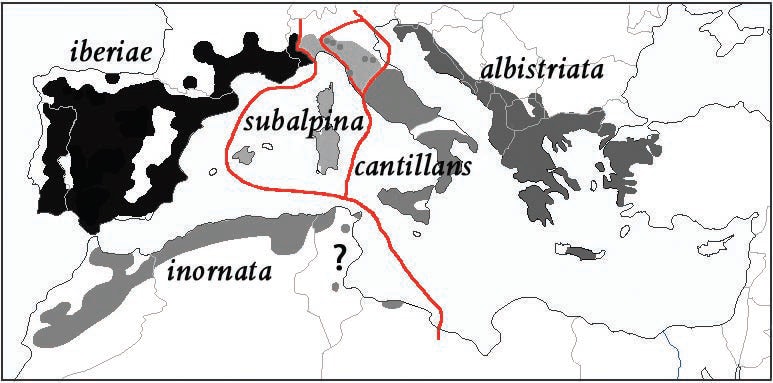
- S. inornata inornata - Western Subalpine Warbler (NW Africa)
- S. inornata iberiae - Western Subalpine Warbler (Iberia and S France)
- S. subalpina - Moltoni's Warbler
- S. cantillans cantillans - Eastern Subalpine Warbler (Central and S Italy)
- S. cantillans albistriata - Eastern Subalpine Warbler (from Balkan to Turkey)
● this theory is not yet accepted
Update in 2024:
● The taxonomic adventures seem endless ever since [ref].
● It seems that the three-way split theory was OK after all, but with modifications:
● All taxa were renamed from Sylvia to Curruca. This is not new.
● The sp inornata and its 2 ssp compeletely disappeard and merged into the monotypic sp iberiae.
● Resulting these 3 new species as a new classification:
- C. iberiae (monotypic) - Western Subalpine Warbler (NW-Africa, Iberia, S-France, extreme NW-Italy)
- C. subalpina (monotypic) - Moltoni's Warbler (N-Italy, Corsica, Sardinia, Balearics)
- C. cantillans cantillans - Eastern Subalpine Warbler (C- and S-Italy, Sicily)
- C. cantillans albistriata - Eastern Subalpine Warbler (NE-Italy, Balkan, Greece, Turkey)
● I think - except inornata - the map above remained otherwise valid.
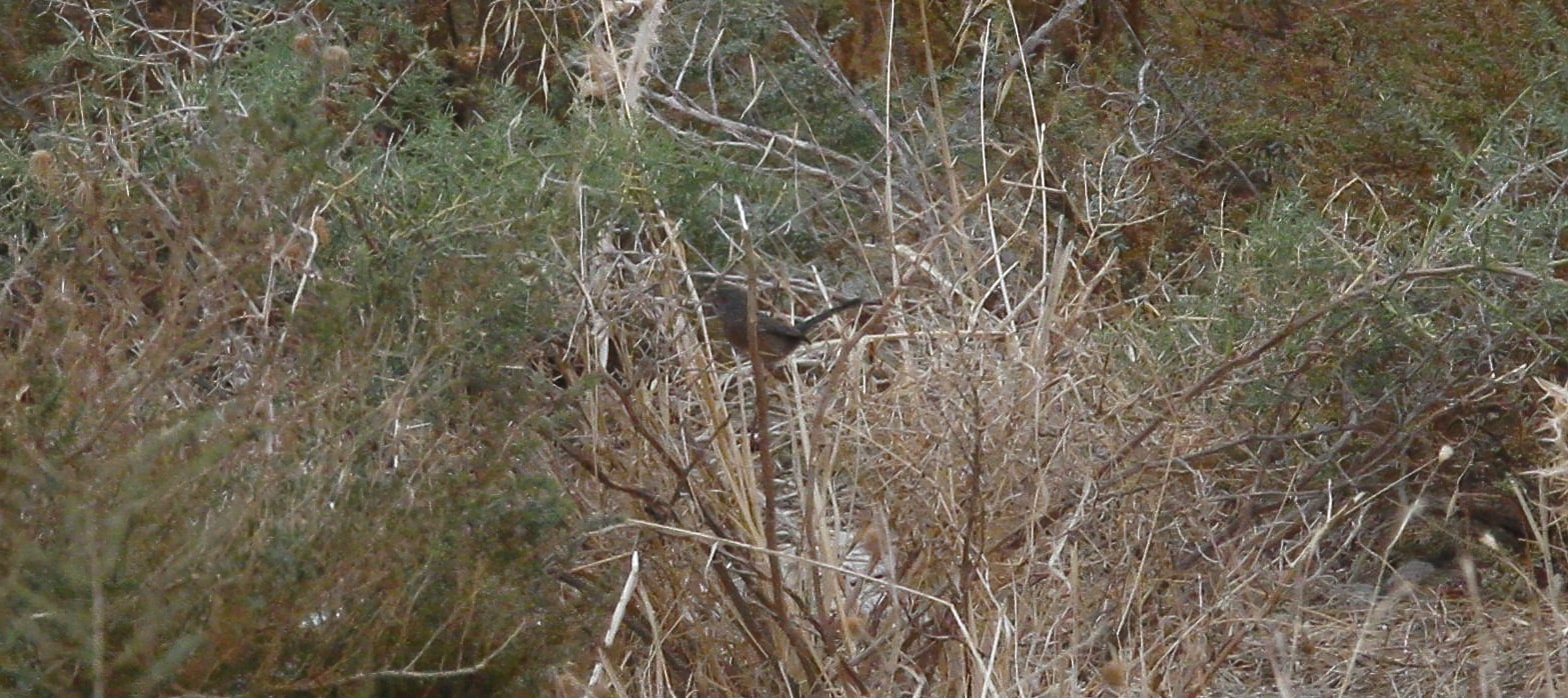
Curruca undata (undata?) -  Dartford Warbler
Dartford Warbler 
![]() toutinegra-do-mato
toutinegra-do-mato  bujkáló poszáta
bujkáló poszáta
(Castro Marim, behind a ruined building near the highway)
● seen only one pair in Castro Marim (signed accurately on the map linked above) and only for a couple of moments, seemed very hiding birds but stayed in their close territory in the low dry scrubs in an abandoned farm
● species is easily differentiable from other Curruca/Sylvia species by its long tail
● differentiation of the two possible subspecies (undata vs. toni) is a harder task:
- ssp undata: slate grey upperparts, Iberian Peninsula and W Mediterraneum
- ssp toni: duller slate upperparts, more saturated underparts; Southern Iberian Peninsula and NW Africa
- mostly the nominate subspecies lives in the Iberian peninsula (a ssp differentiation guide)
● according to general coloration and probability I bet on the nominate subspecies to this fast moving birds in my quick and bad pictures
● scrubs in photo: Ulex argenteus - Whin sp, xy zanót faj
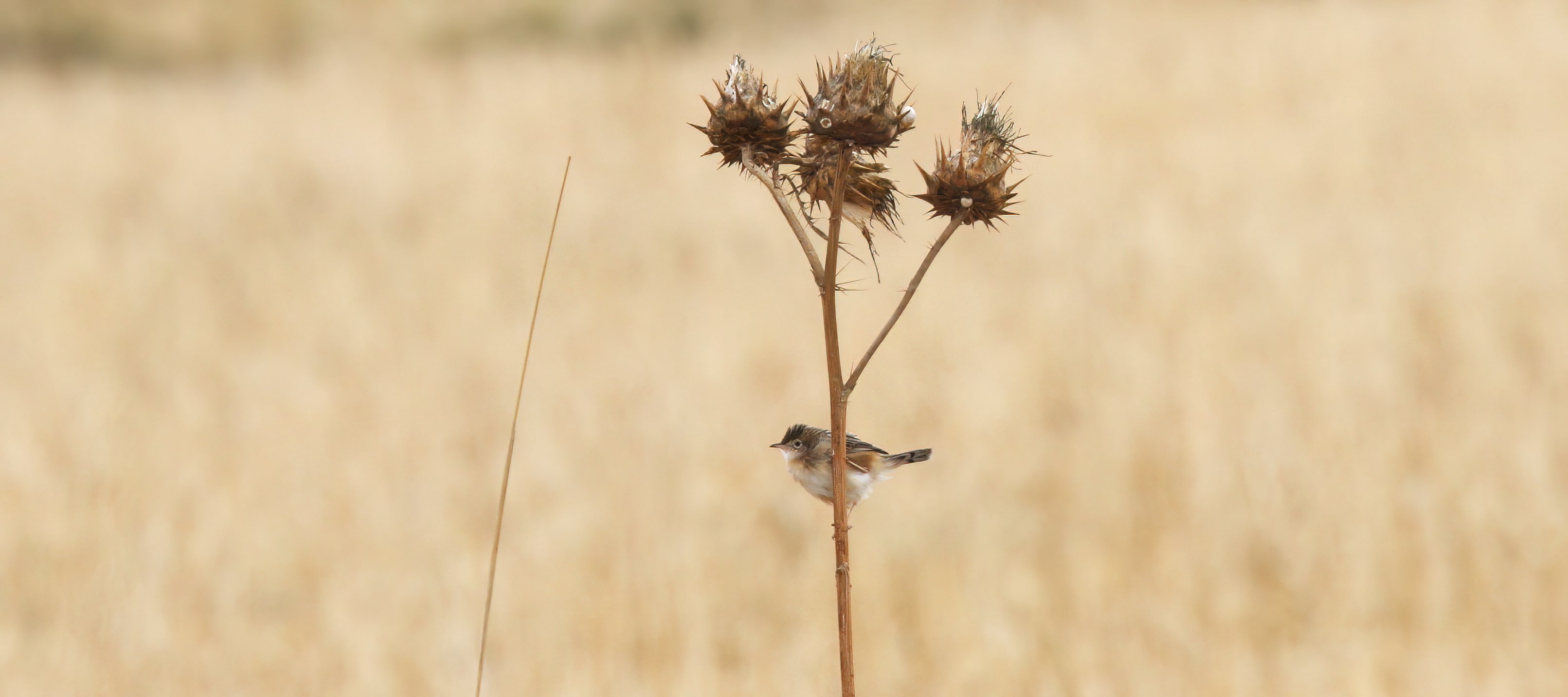
Cisticola juncidis cisticola -  Zitting Cisticola
Zitting Cisticola 
![]() fuinha-dos-juncos
fuinha-dos-juncos  szuharbújó
szuharbújó
(Vilamoura, grasslands)
● ssp cisticola: Iberian Mediterraneum; duller brown upperparts, paler underparts than on nominate
● seen almost in every kind of vegetated habitats, most abundant in the marshes of Catro Marim
● fast moving and elusive little bird
● plant in photo: Cynara sp - Cardoon
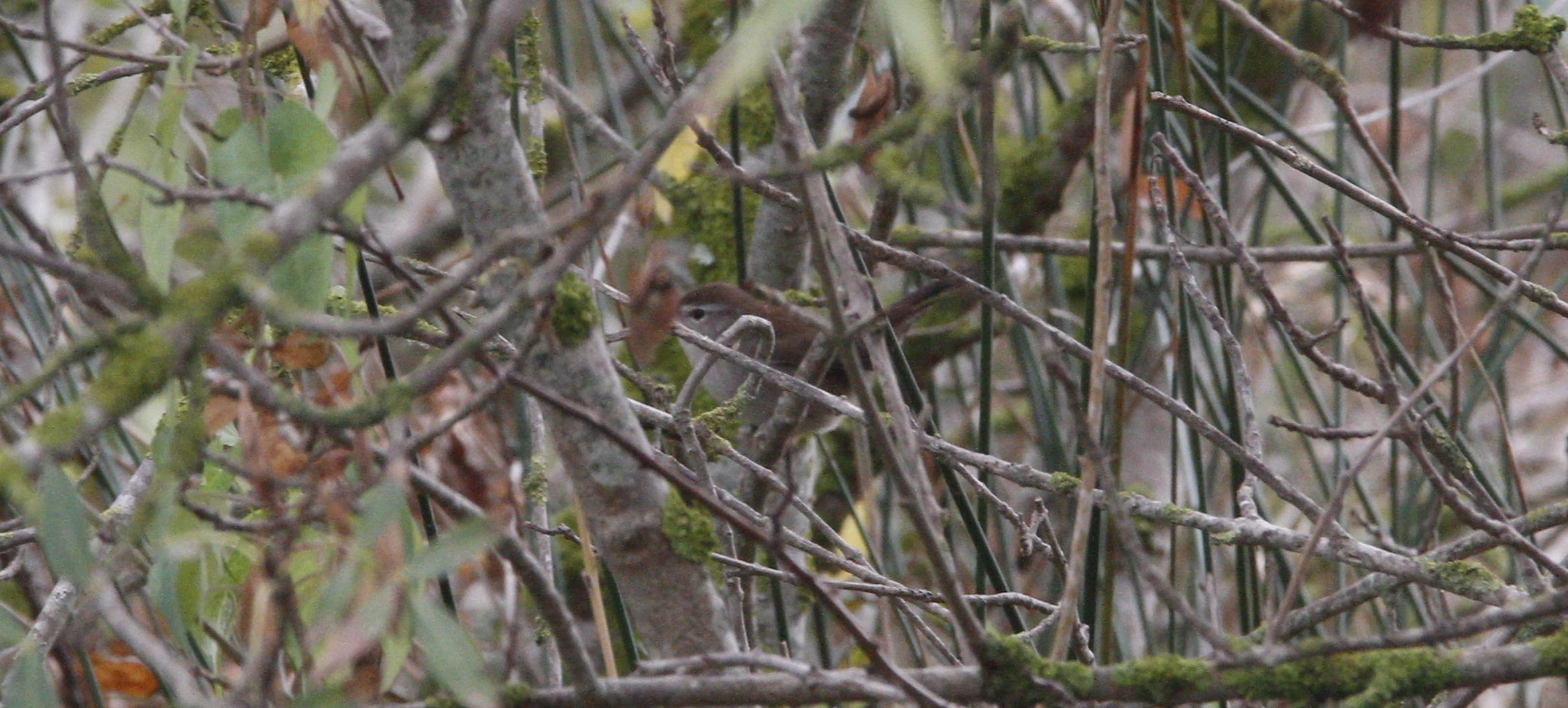
Cettia cetti cetti -  Cetti's Warbler
Cetti's Warbler 
![]() rouxinol-bravo
rouxinol-bravo  berki poszáta
berki poszáta
(Vilamoura, shrubs and reedbeds)
● very rarely seen but heard much easier from dense vegetation in close proximity of freshwater (Vilamoura Canal)
● the always repeated melody from dense reedbed (multiple birds from the thicket with some background noise by a lawn mower):
● a real wetland with extended reedbed is a rare habitat in the Algarve
● I found larger and real reedbeds only in Vilamoura (near the water plant with a birdwatching hut) and in Ludo (Ria Formosa N.P.), these reedbeds and coastal wetlands give a home to some other wetland-connected songbirds, too: Reed Warbler (Acrocephalus scirpaceus) and White-spotted Bluethroat (Luscinia svecica cyanecula) were also found here in low numbers
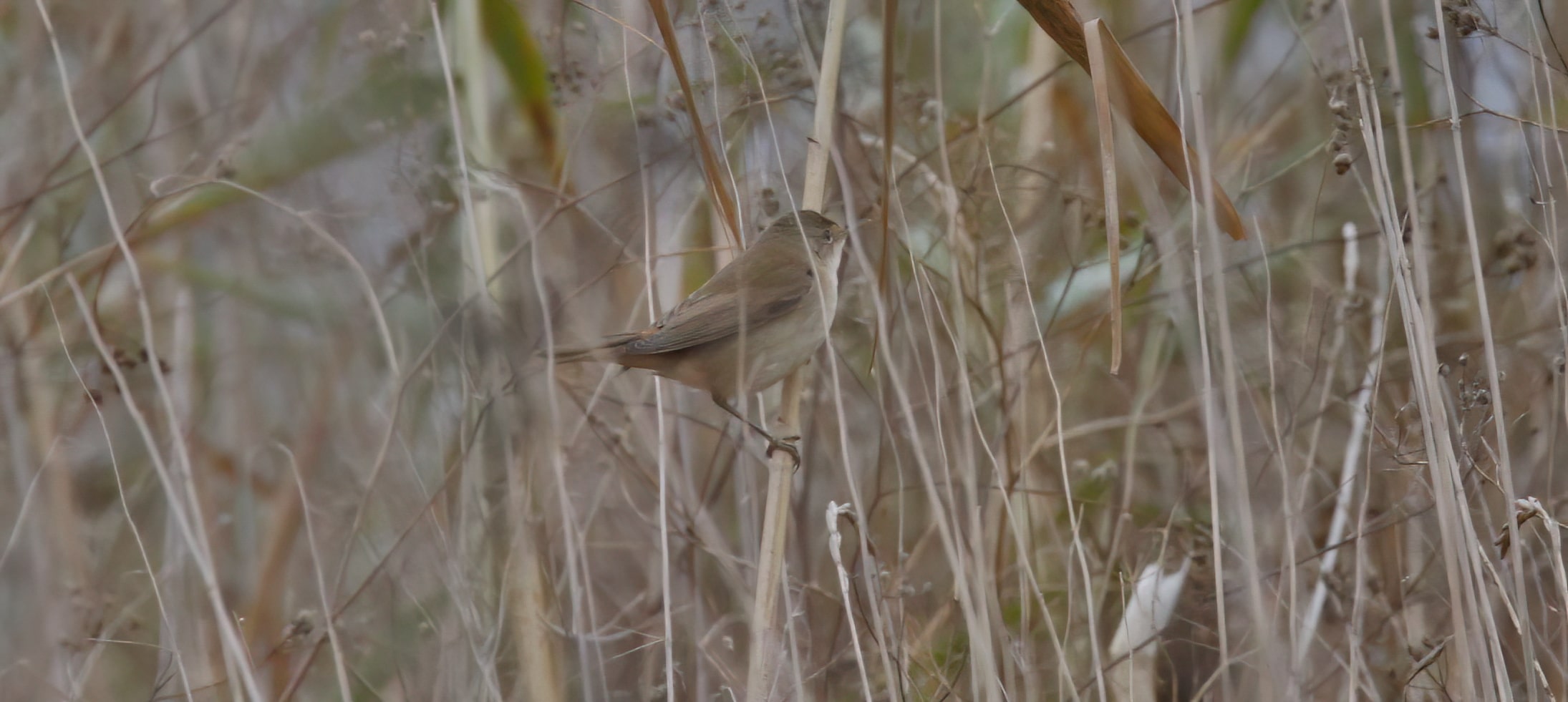
A. scirpaceus |
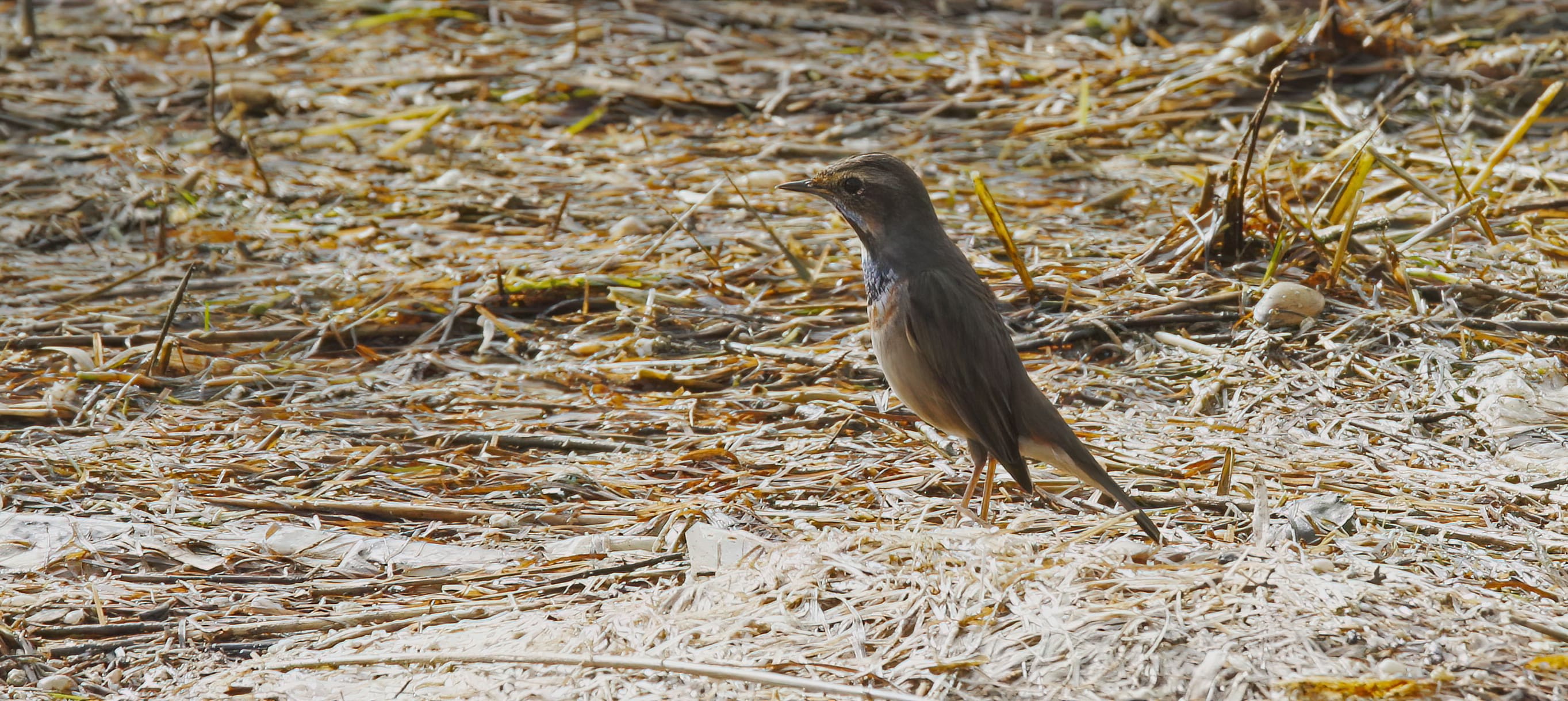
L. svecica cyanecula |
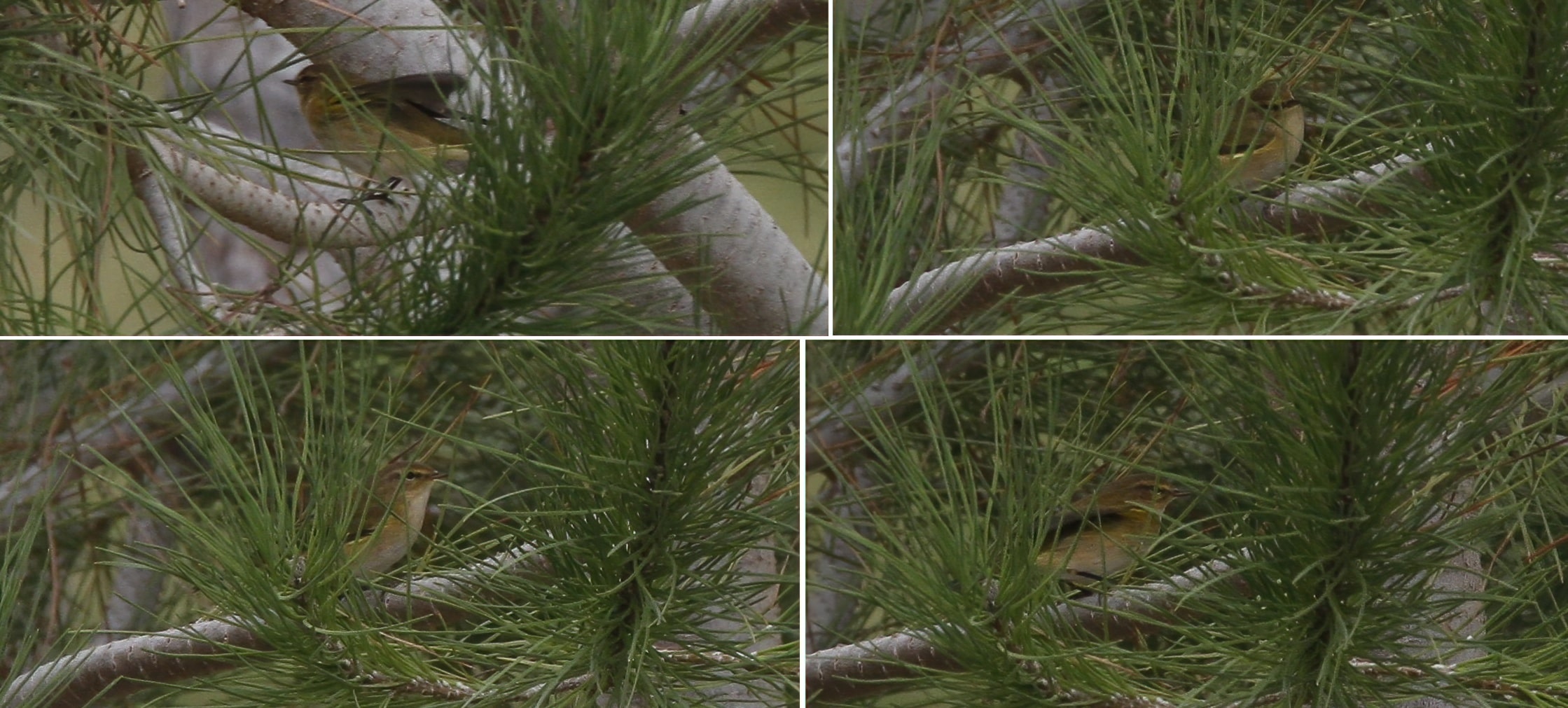
Phylloscopus ibericus -  Iberian Chiffchaff
Iberian Chiffchaff 
![]() felosinha-ibérica
felosinha-ibérica  ibériai füzike
ibériai füzike
(Vilamoura, golf courses)
● ibericus: different voice, greenish rump, shorter bill, brighter colors, more yellow marks and more yellowish general underpart colors than on P. collybita
● a great guide in ID: ref
● managed to see this species only twice (Olhão marshes and Vilamoura golf courses)
● plant in photos: Pinus pinea - Mediterranean Stone Pine, mandulafenyő
Other Phylloscopus species:
● other Phylloscopus species were also rare in this tour: Common Chiffchaff (P. collybita) (20-25) and Willow Warbler (P. trochilus) (1) seen only in less dry and more vegetated habitats, mainly around the fruit plantations near Vilamoura
● P. ibericus is resident in Portugal, P. collybita is both resident and migrant, P. trochilus is only migratory in the country
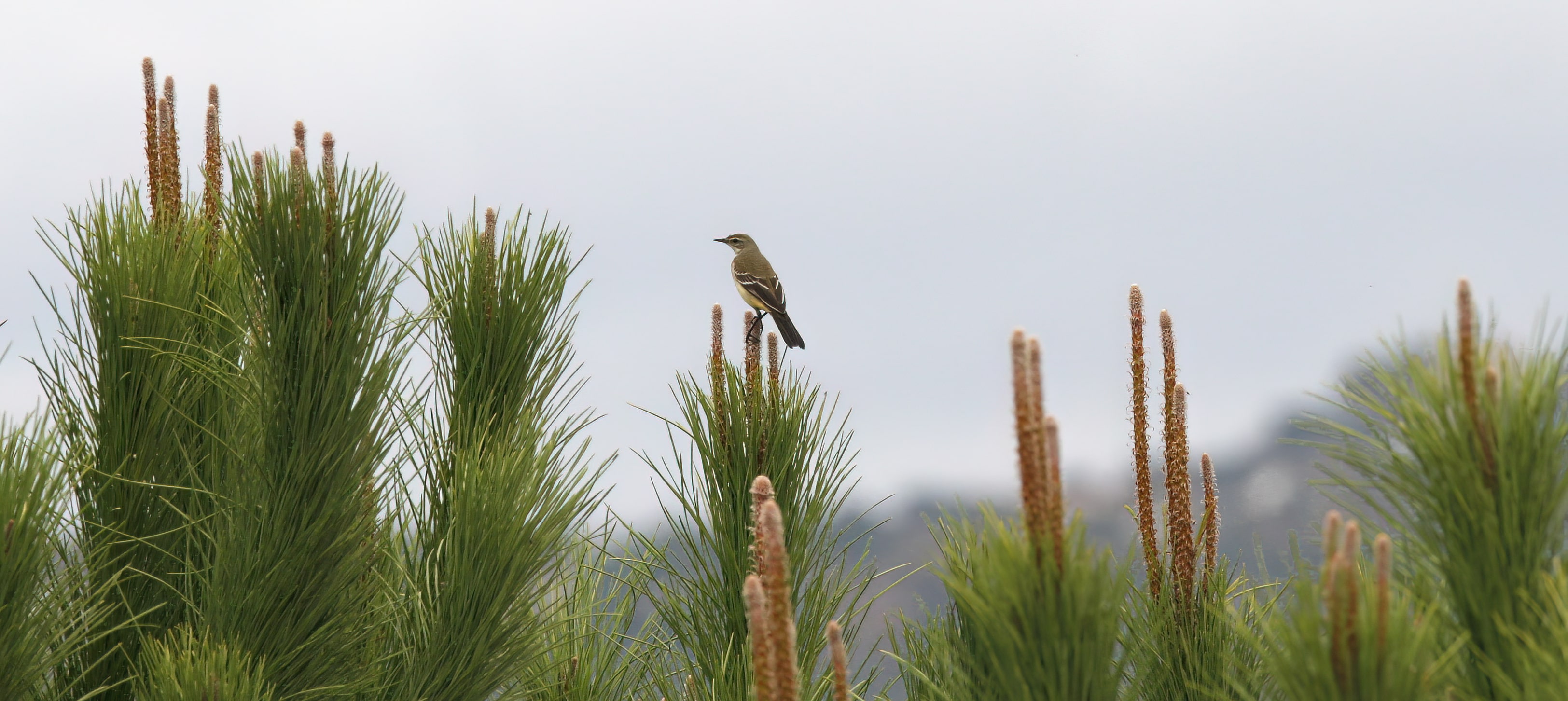
Motacilla flava iberiae -  Iberian Yellow Wagtail
Iberian Yellow Wagtail 
![]() alvéola-amarela
alvéola-amarela  ibériai sárga billegető
ibériai sárga billegető
(Vilamoura, water plant)
● ssp iberiae: grey head, white supercilia and throat, darker greyish mantle
● perched on the top of a tree standing just on the edge of a golf course lawn
● plant in photo: Pinus pinea - Mediterranean Stone Pine with pollen bearing male cones, mandulafenyő porzós virágzatokkal
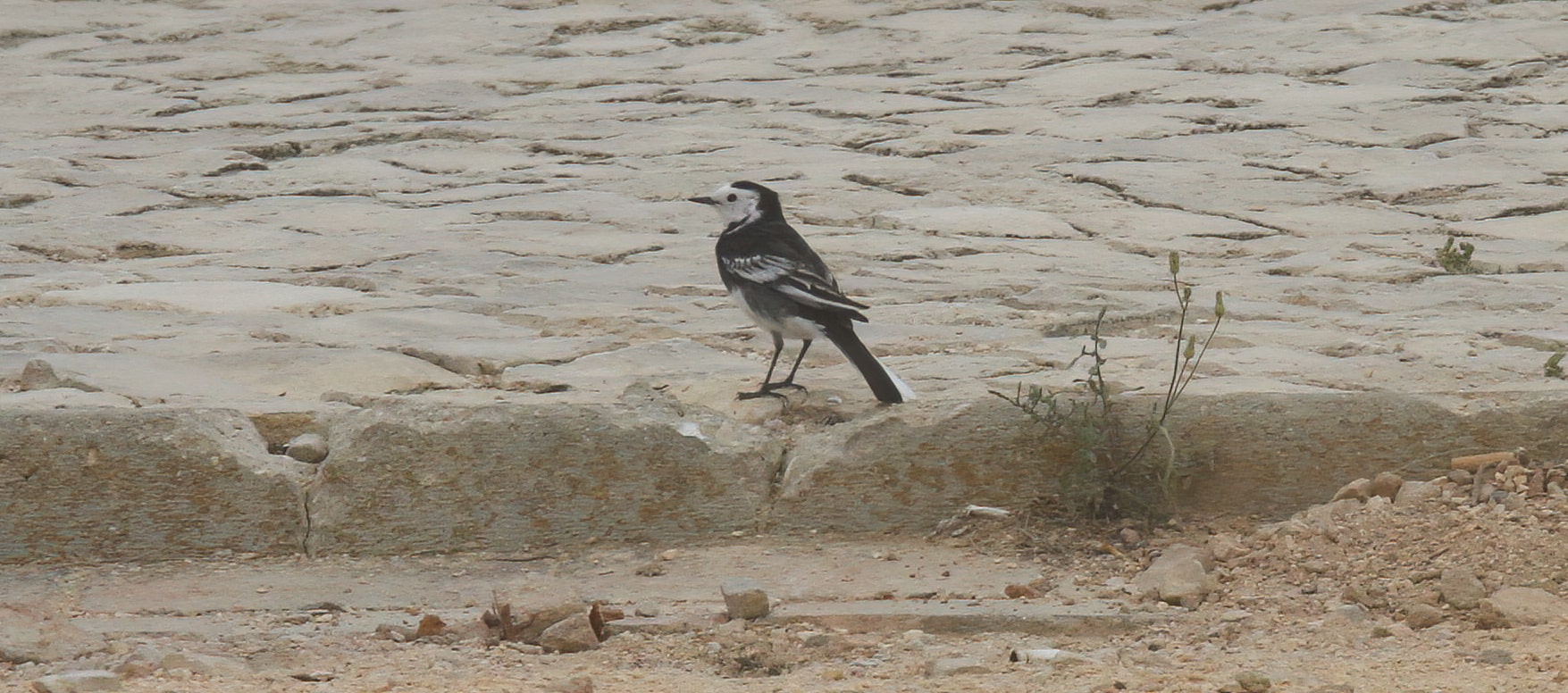
Motacilla alba yarrellii -  'British' Pied Wagtail
'British' Pied Wagtail 
![]() alvéola-branca-britânica
alvéola-branca-britânica  angliai barázdabillegető
angliai barázdabillegető
(Sagres, Jardim de Sagres)
● ssp yarrellii: clear black mantle and breast; breeds in NW Europe, winters in SW Europe (some in Morocco)
● a migrating adult male bird in summer plumage just in the middle of the main public square of Sagres city
● for differentiation of alba alba and alba yarrellii in problematic cases: ref
● the Moroccon Wagtail (ssp subpersonata) also has some similarities, but significantly differs in: eye-stripe, mustache, grey back
● Motacilla alba alba wasn't a common species in this week, too
● a single individual of Motacilla cinerea - Grey Wagtail (hegyi billegető) also found around the muddy bank of Esteiro da Carrasqueira in Castro Marim
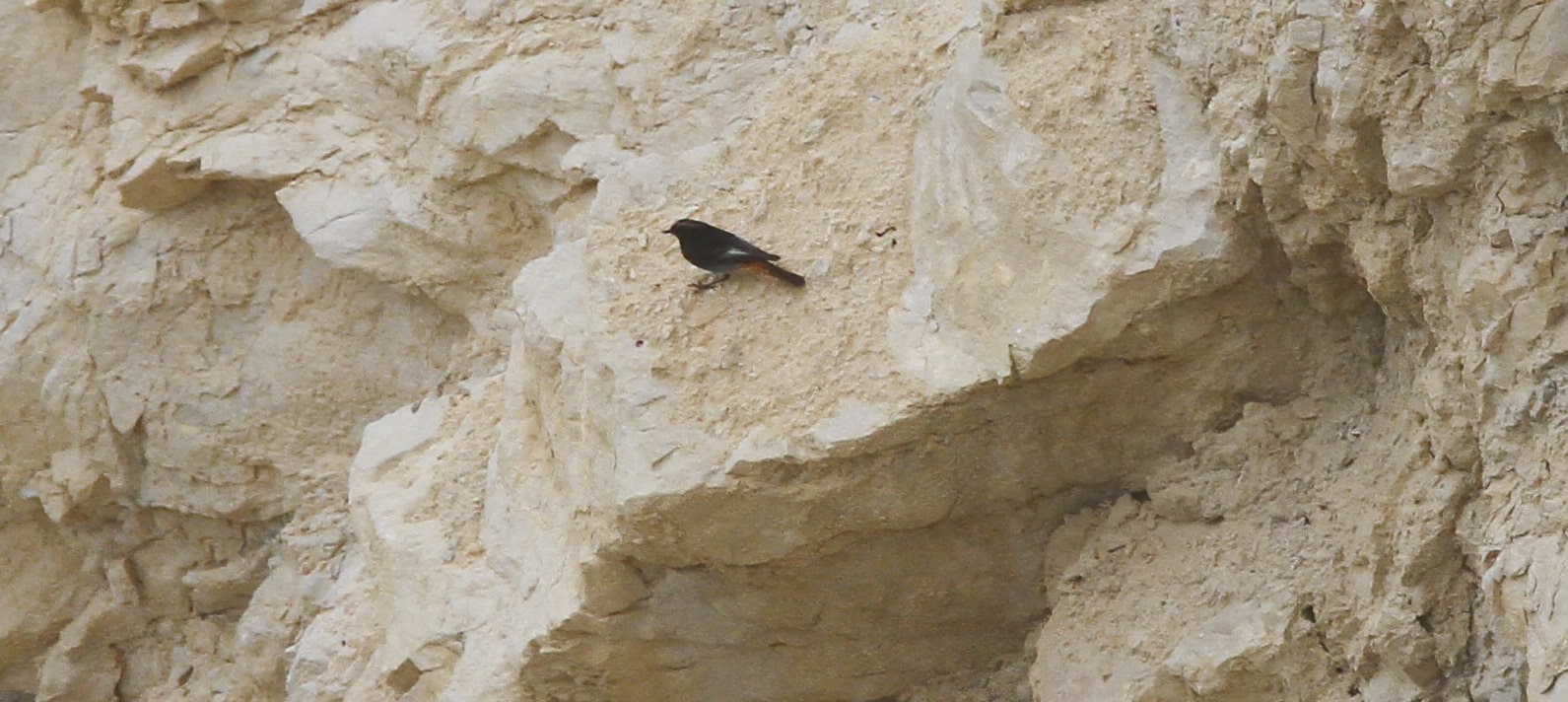
Phoenicurus ochruros aterrimus -  Iberian Black Redstart
Iberian Black Redstart 
![]() rabirruivo-preto
rabirruivo-preto  házi rozsdafarkú
házi rozsdafarkú
(Cabo de São Vicente, coastline)
● ssp aterrimus: black neck, shoulders and back on adult male
● today an independent subspecies taxon, earlier it was just a race of P. o. gibraltariensis
● Black Redstarts were uncommon in this trip: in total 3 in Sagres-region and 2 in Castro Marim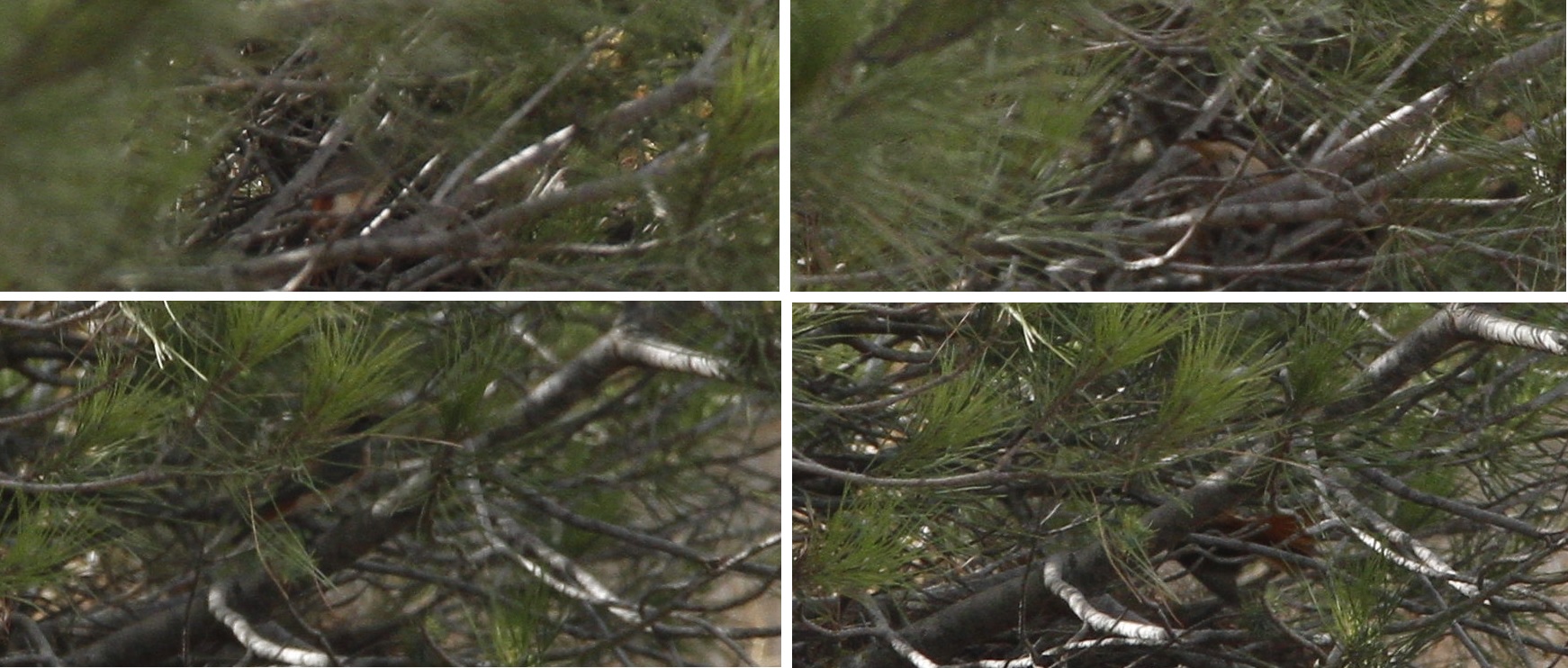
● 1 female Common Redstart (P. phoenicurus) was also spotted in Praia Falésia ➤
Wheatears:
● 3 Oenanthe species are present in Portugal, but I saw only a couple of individuals of the most common Oenanthe oenanthe oenanthe - Northern Wheatear (hantmadár) here and there;
● Oenanthe hispanica - Black-eared Wheatear (déli hantmadár) and the rare Oenanthe leucura - Black Wheatear (kormos hantmadár) leave the region in early Autumn
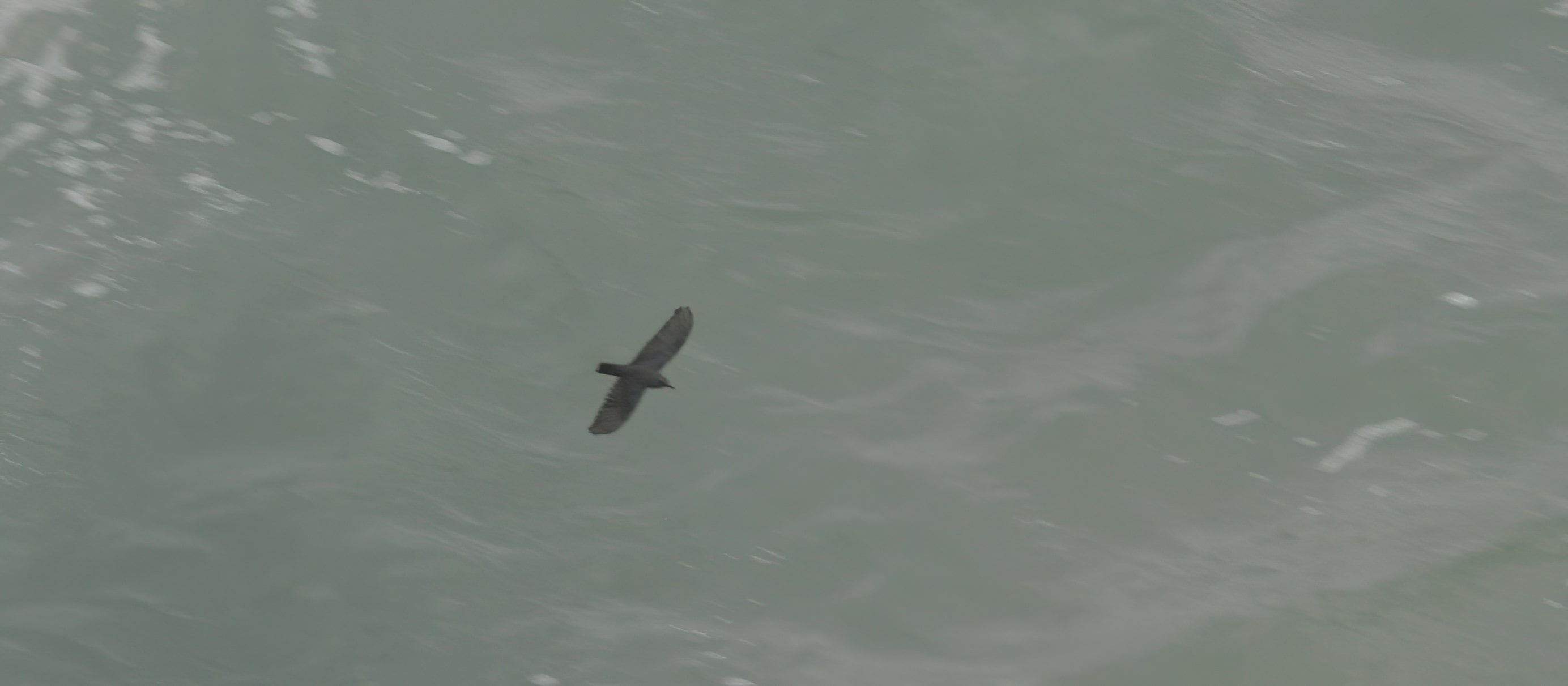
Monticola solitarius solitarius -  Western Blue Rock Thrush
Western Blue Rock Thrush 
![]() melro-azul
melro-azul  kék kövirigó
kék kövirigó
(Cabo de São Vicente, coastline)
● seen only once and only for some seconds flying into hide under the steep coastal cliffs
● the nominate type lives in Portugal (Western Mediterranean region)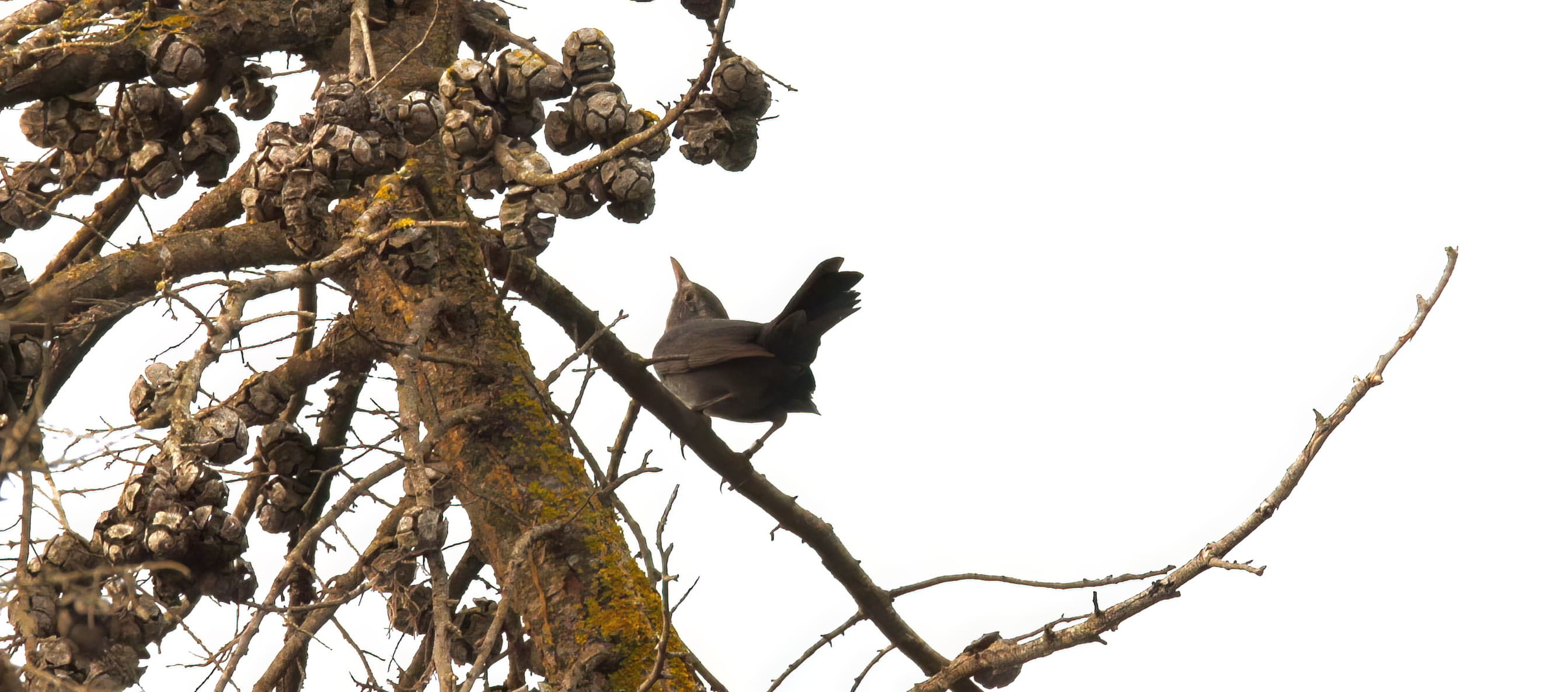
● Turdus species in the Algarve were represented solely by Blackbird (T. merula merula) but in not too elevated numbers, presumably they needed more wet and more vegetated habitats (e.g. irrigated city parks in Faro, shrubby wetland marshes in Castro Marim and Quinta de Marim, fruit plantations and golf courses in Vilamoura)
● plant in small picture: Cupressus sempervirens - Mediterranean Cypress)
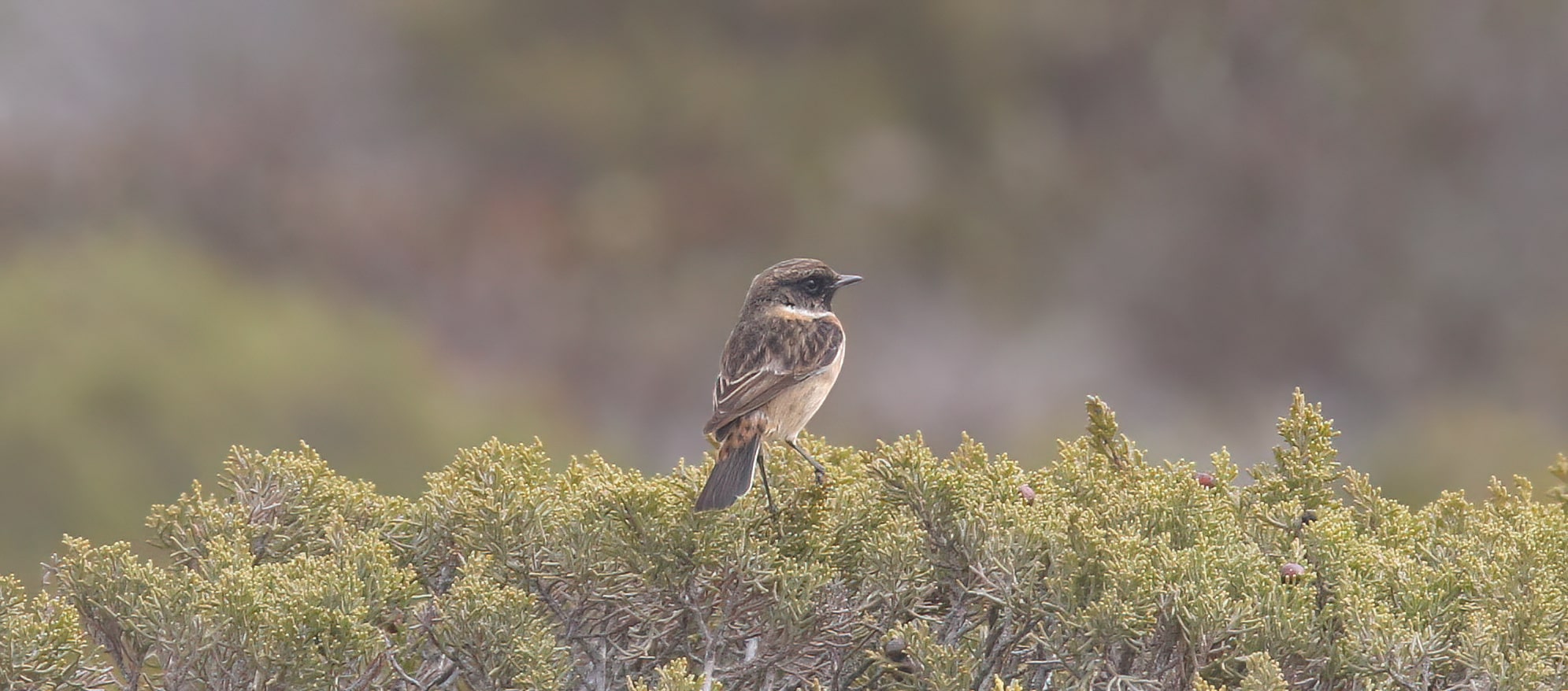
Saxicola rubicola hibernans -  European Stonechat
European Stonechat 
![]() cartaxo-comum
cartaxo-comum  cigánycsuk
cigánycsuk
(Cabo de São Vicente, coastal shrubs)
● the most frequently seen Turdidae species in the Algarve: marshes, grassfields, cities, beaches, they were everywhere...
● resident and breeding bird in Portugal but many European birds winter or pass through here, too
● ssp hibernans: darker than nominate, less white on wings, smaller patch on neck, less white on rump; NW Europe to Portugal
● according to a study [ref] ssp rubicola breeds in Portugal and ssp hibernans rather just winters here
● all Stonechats seen in this week had this type of appearance as shown in the upper photo and were identified as ssp hibernans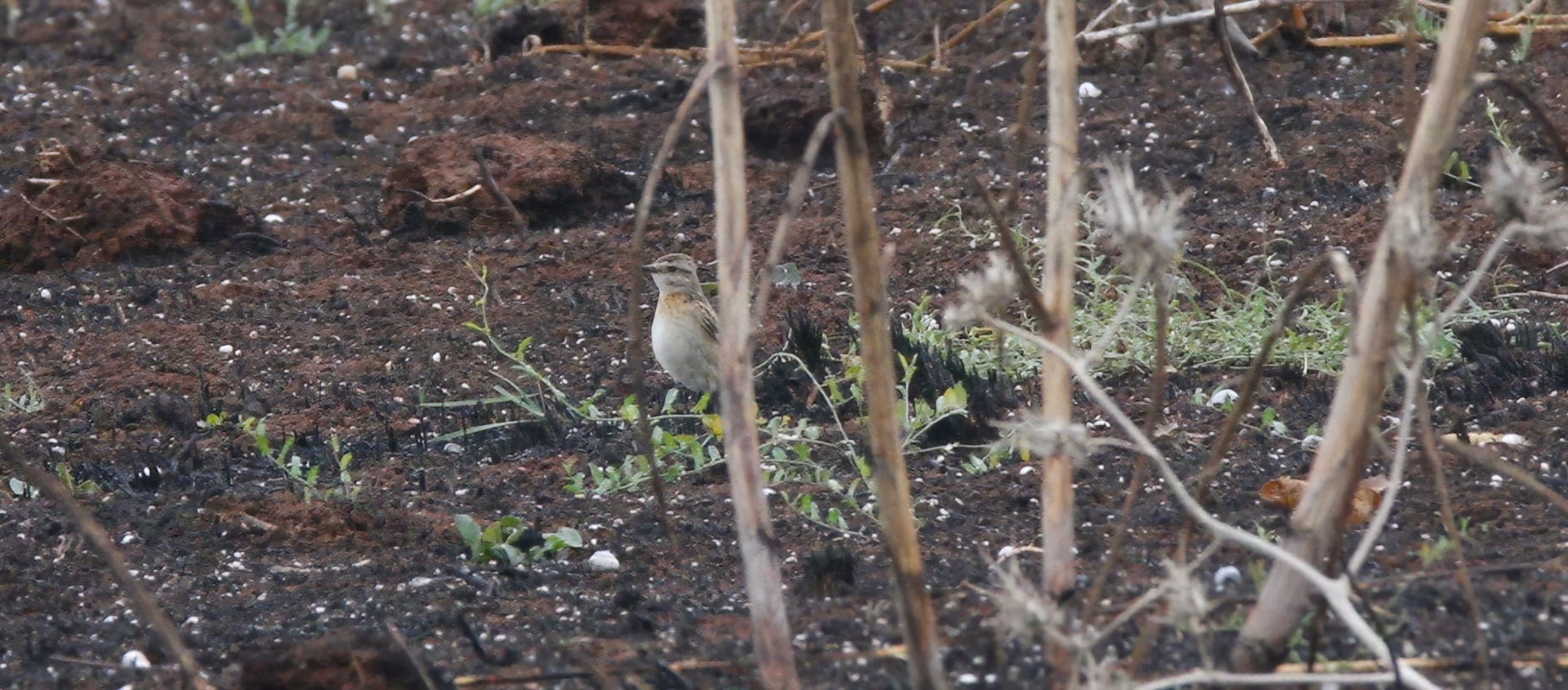
● shrub in photo of Stonechat: Juniperus phoenicea - Phoenician Juniper, föníciai pikkelyboróka
● a single migrant immature Whinchat (Saxicola rubetra) was also seen at Vilamoura (small photo)
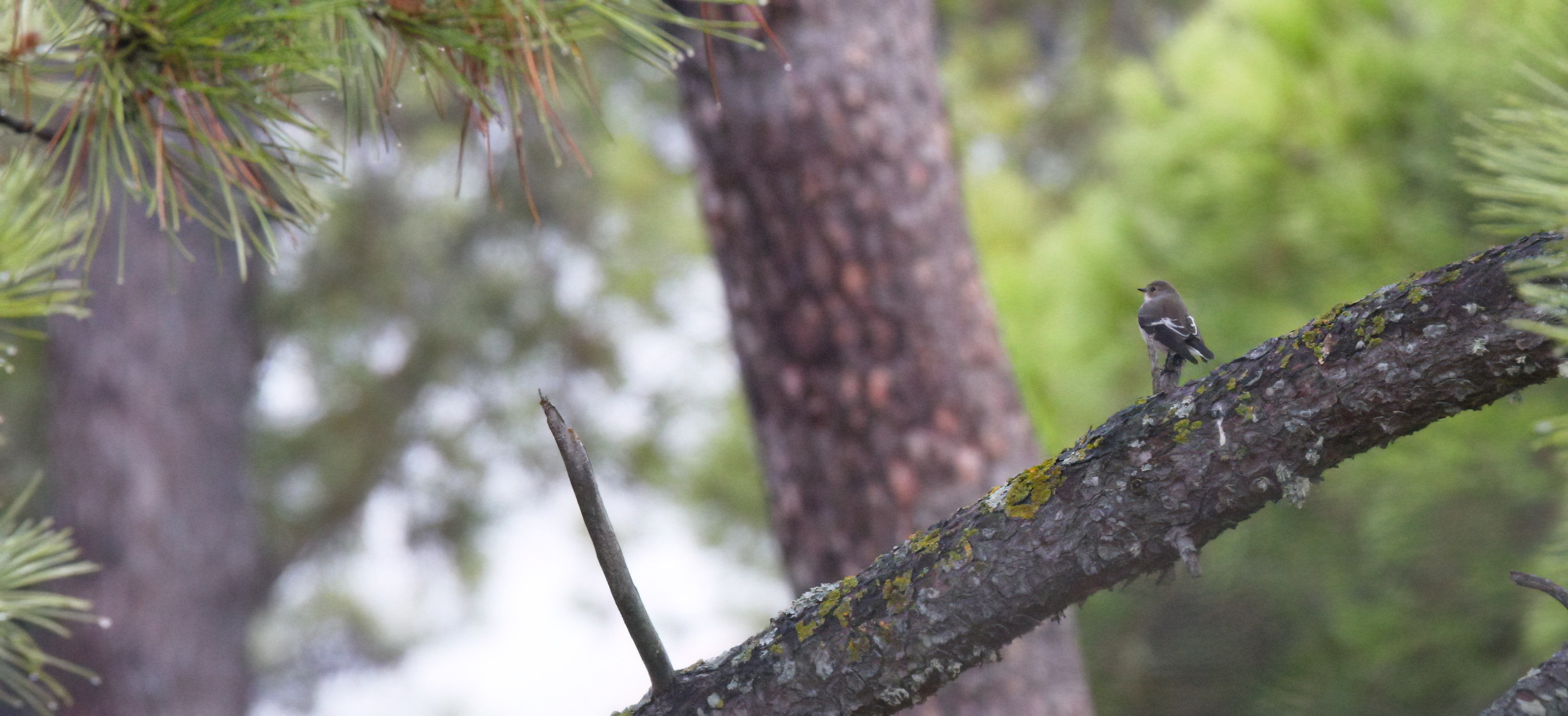
Ficedula hypoleuca iberiae -  Iberian Pied Flycatcher
Iberian Pied Flycatcher 
![]() papa-moscas-preto
papa-moscas-preto  kormos légykapó
kormos légykapó
(Olhão, Quinta de Marim, park)
● ssp iberiae: larger frontal patch on males, whiter tertial web, more extensive white patch on basis of flight feathers
● a single bird (female) in the western coasts, which could be a nominate in its migration
● little groups in forestral habitats in the more inner (eastern) regions were more likely Iberian ssp (Olhão, Vilamoura)
● unfortunately, no picture from a male to clearly see differences
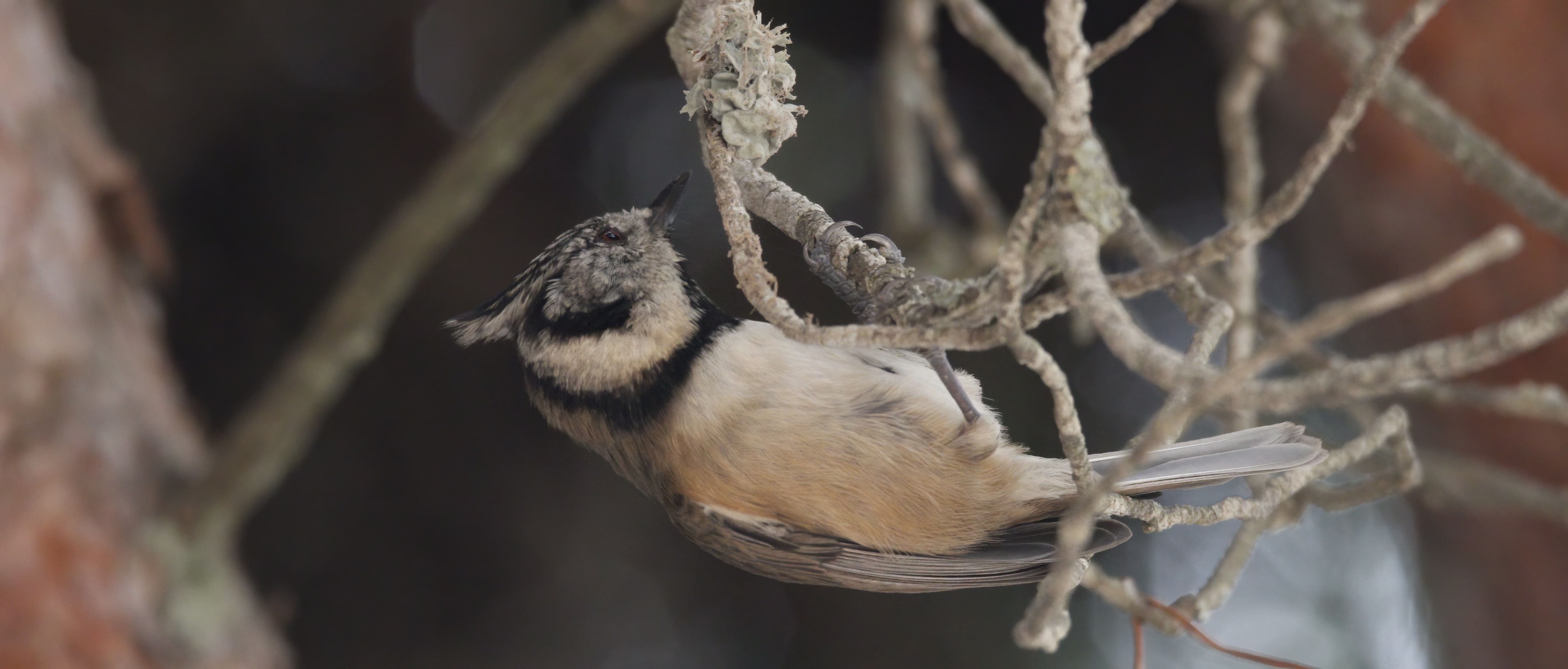
Lophophanes cristatus weigoldi -  West Iberian Crested Tit
West Iberian Crested Tit 
![]() chapim-de-poupa
chapim-de-poupa  búbos cinege
búbos cinege
(Olhão, Quinta de Marim, park)
● ssp weigoldi: underparts whiter, upperparts and head paler; S and W Iberian peninsula
● only seen in a semi-arid pine tree habitat in Quinta de Marim

● Parus species were represented only by P. major corsus (Great Tit) and were really rare in this week, found only in wetlands (Vilamoura, Quinta do Lago, Quinta de Marim)
● ssp corsus: darker upperparts, paler underparts; Portugal, S Spain and Corsica
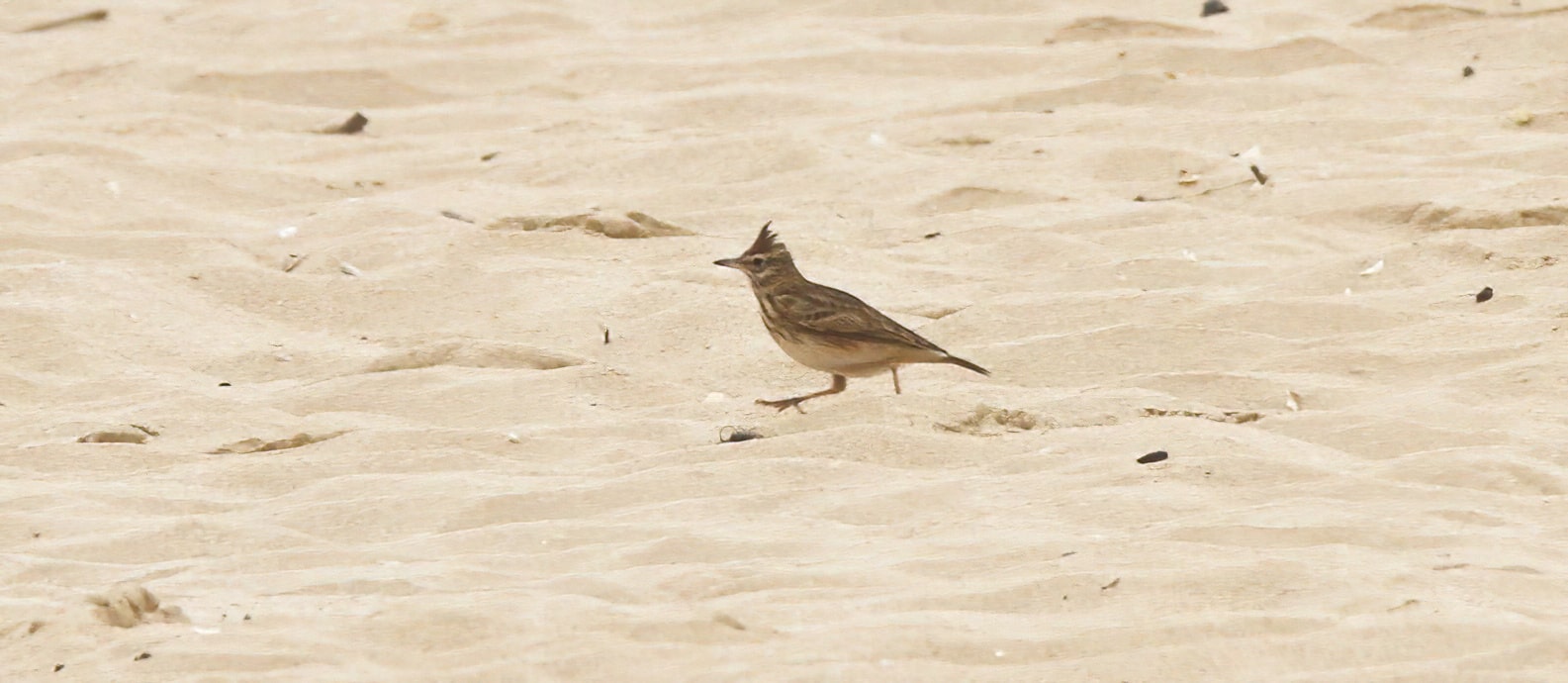
Galerida cristata pallida -  Crested Lark
Crested Lark 
![]() cotovia-de-poupa
cotovia-de-poupa  búbos pacsirta
búbos pacsirta
(Lagos, São Roque Beach)
● ssp pallida: slightly paler, smaller in size, more reddish and less clear strinkings
● about a dozen or two were seen in almost all area visited in this tour
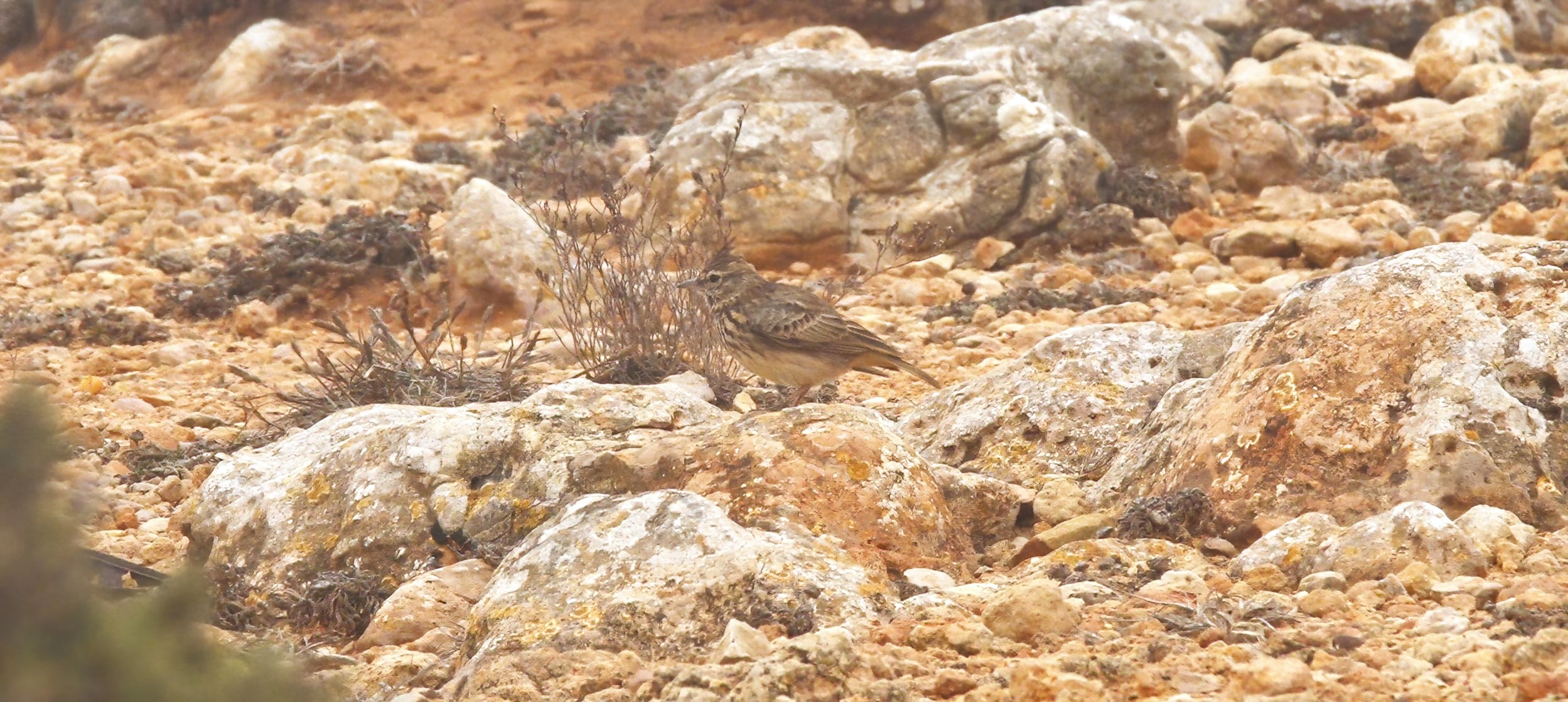
Galerida theklae theklae -  Thekla Lark
Thekla Lark 
![]() cotovia-montesina
cotovia-montesina  kövi pacsirta
kövi pacsirta
(Sagres, coastline)
● the nominate subspecies lives in the Iberian Peninsula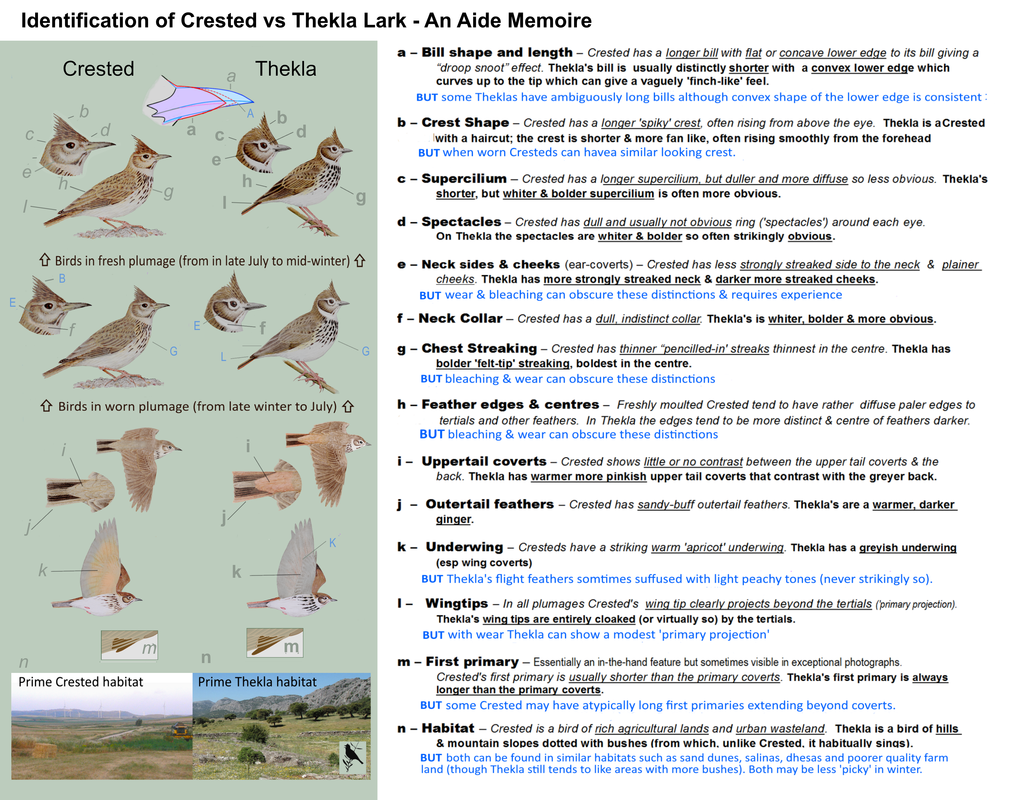
● identification guide to Thekla and Crested Lark (source: BirdForum) ➤
● the clearest markers for identification of Thekla Lark in the field:
- shorter bill and convex lower cave (concave or flat on Crested Lark)
- shorter crest
- whiter collar on neck
- shorter supercilium after the eye
- some marks are not always obvious
● after all of these, I still didn't manage to securely identify all the birds I photographed, in some cases some signs were not reliable
● the two species overlapped only in the Sagres region, Thekla Lark was absent (for me) from other regions in this week. HBW and xeno-canto maps show much wider distribution area in Portugal for the Thekla Lark
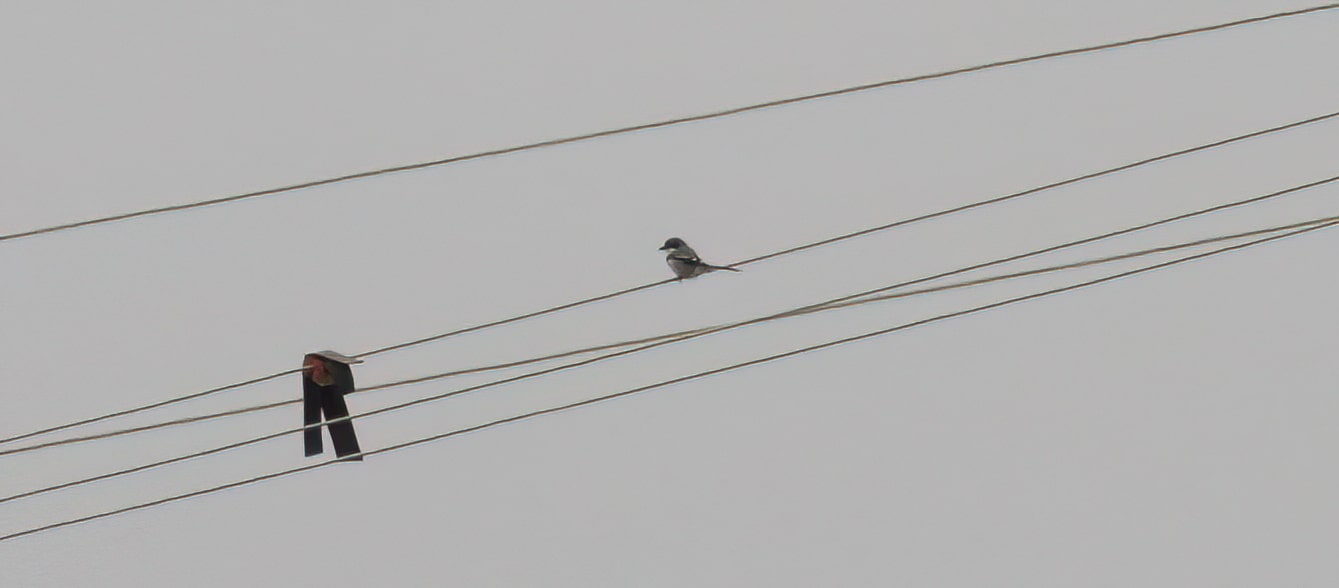
Lanius meridionalis meridionalis -  Southern Grey Shrike
Southern Grey Shrike 
![]() picanço-real
picanço-real  sivatagi őrgébics
sivatagi őrgébics
(Castro Marim, arid region, near São Bartolomeu)
● recently split from the closely related L. excubitor (Great Grey Shrike), an independent species today
● main markers for differentiation:
● L. excubitor is absent in the Iberian Peninsula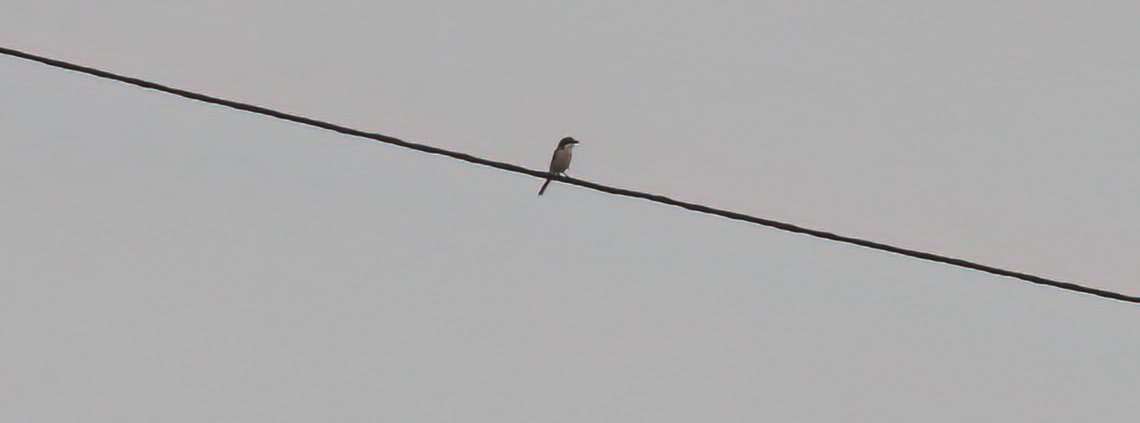
● L. meridionalis: darker upperparts and more rosy-cream-coloured underparts, narrow white supercilium connected above bill, smaller white spot on wing
● rosy underparts shown in another photo (Castro Marim pastures) (small picture) ➤
● cream coloured belly is also characteristic for the adult male L. minor (Lesser Grey Shrike), but this shrike doesn't occur in Portugal and the male has a black mask above bill
● seen only three times during this week: twice in Castro Marim and once from a train on a wire somewhere near Tavira (for a moment...), unfortunately, I never saw from close enough to a better quality capture
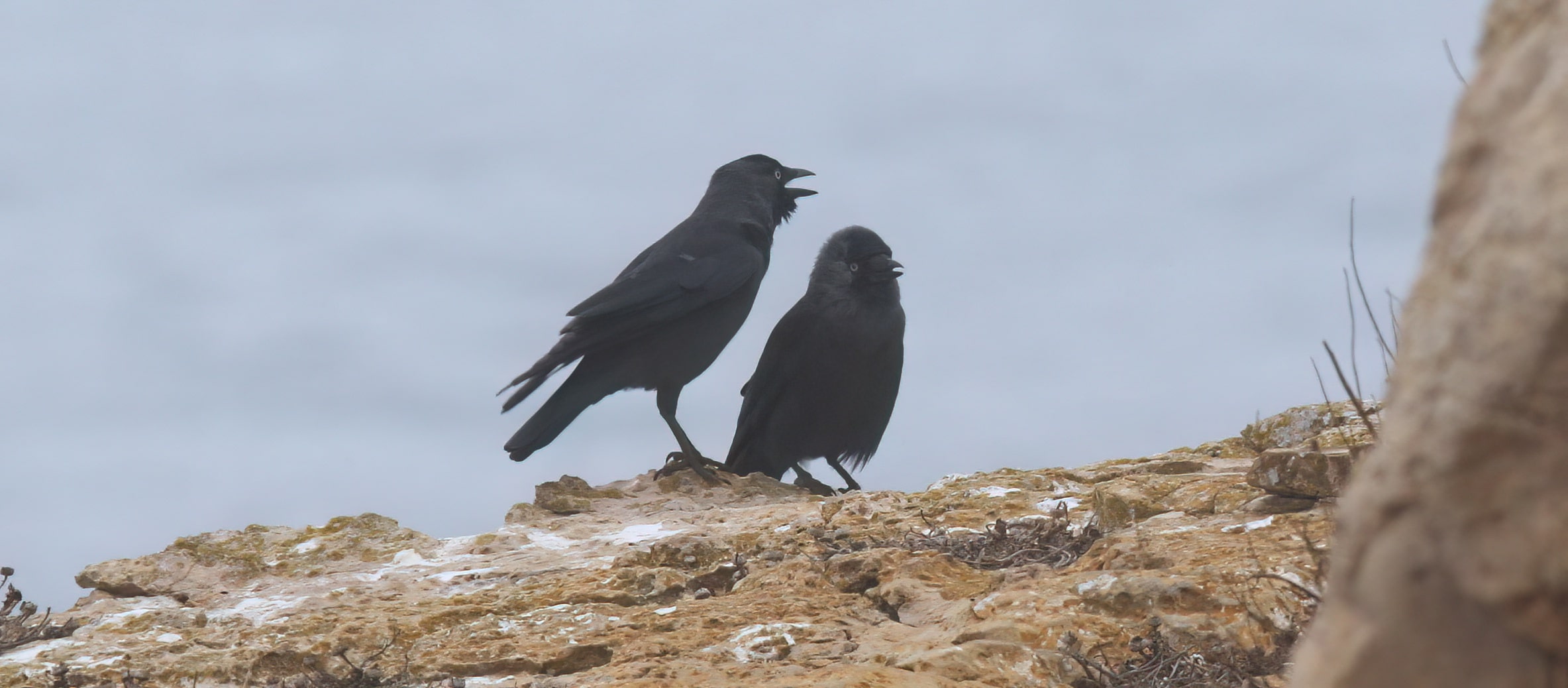
Coloeus monedula spermologus -  Western Jackdaw
Western Jackdaw 
![]() gralha-de-nuca-cinzenta
gralha-de-nuca-cinzenta  csóka
csóka
(Sagres, coastline)
● ssp spermologus: the darkest subspecies of all, almost no pale collar and no silvery shining on neck and head; distribution range from W Europe to NW Morocco
● according to many sources ssp ibericus is no longer a valid taxon and is just a clinal variation of ssp spermologus
● seen a flock in Lagos beach and some pair of birds around the cliffs of Sagres coastline
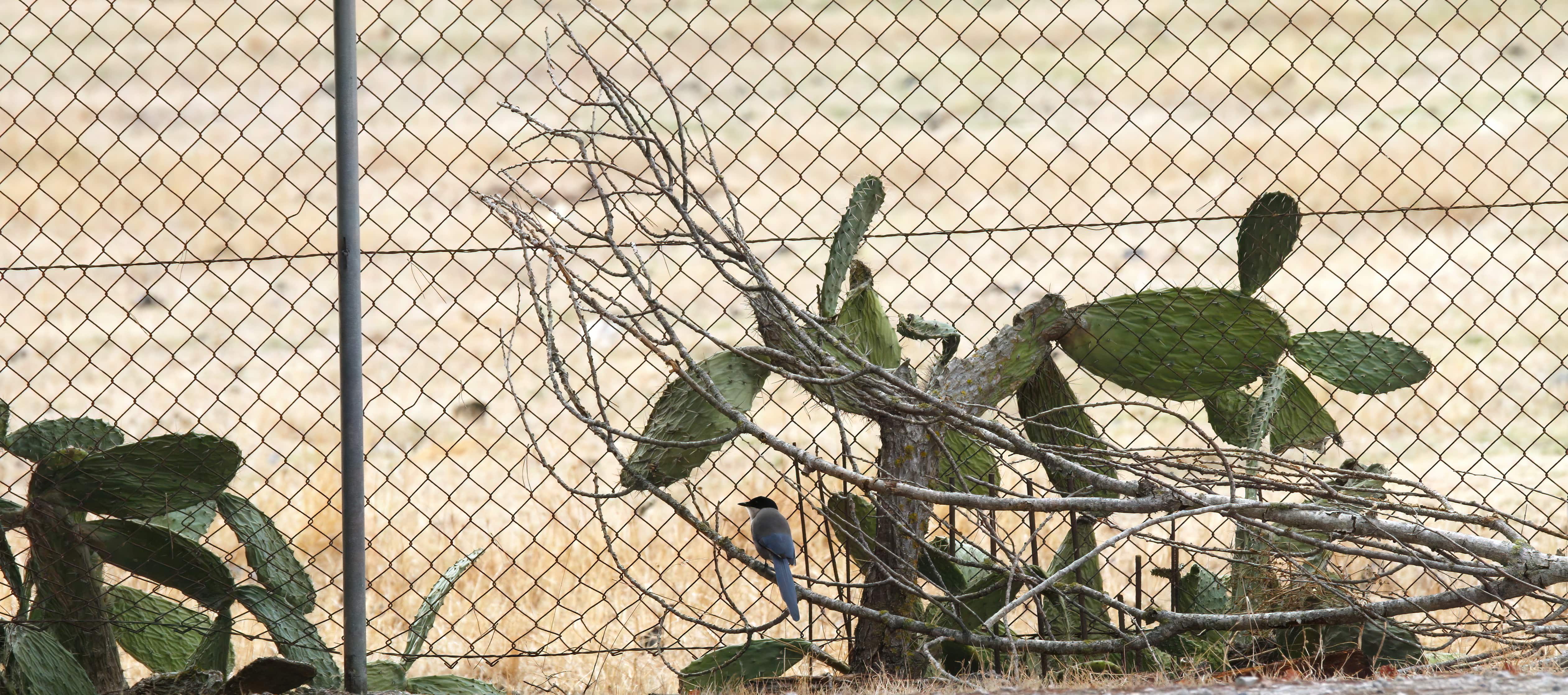
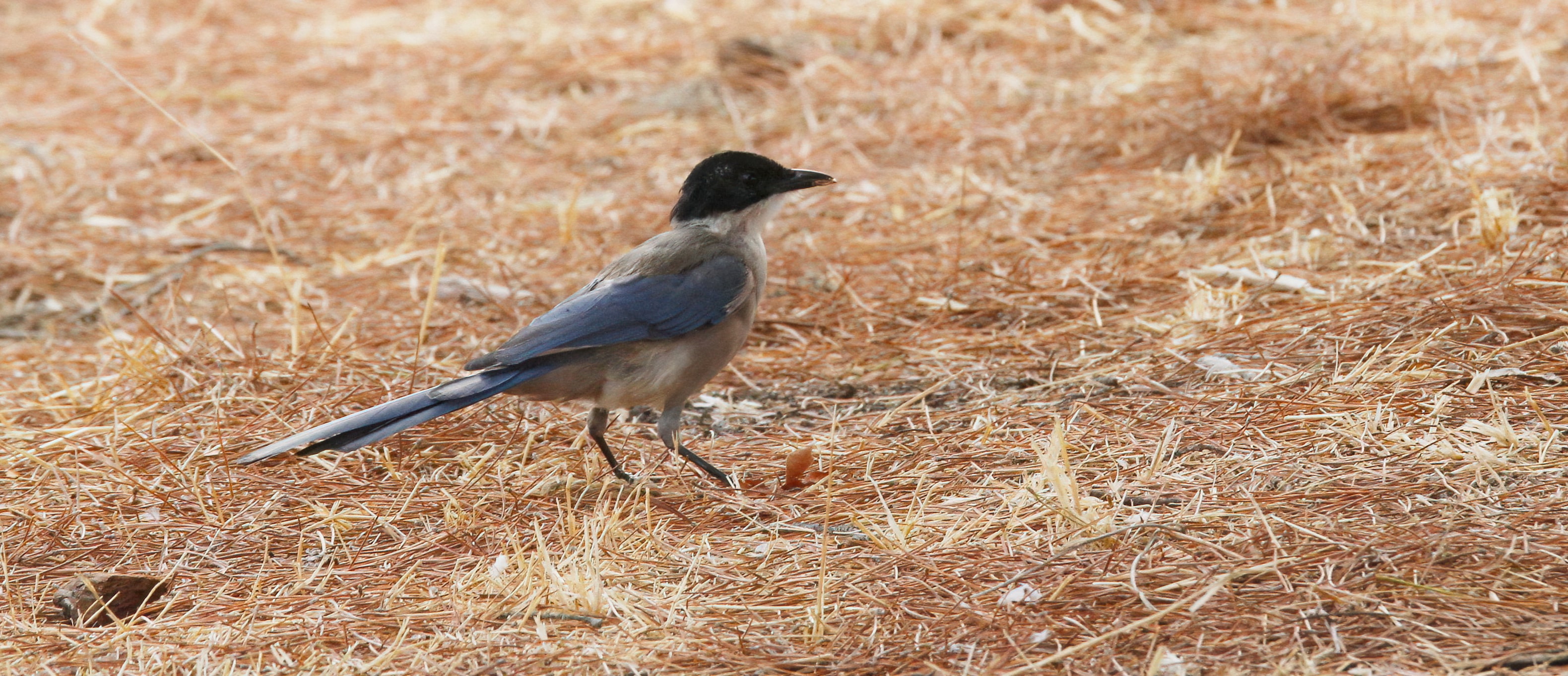
Cyanopica cooki -  Iberian Magpie
Iberian Magpie 
![]() charneco / pega-azul
charneco / pega-azul  ibériai kékszarka
ibériai kékszarka
(Olhão, Quinta de Marim, park)
● alarm calls and chatting of 2 magpies in a park of Quinta de Marim, Olhão
● no longer a subspecies subtaxon of the very similar looking C. cyanus (Azure-winged Magpie), but an independent new species
● the old Portuguese name pega-azul includes the Asian C. cyanus, too
● C. cooki (compared to C. cyanus): smaller size, shorter tail, no white tip on tail, geographically separeted (~8.000 km...!)
● found just a few in Quinta do Lago and in Vilamoura, but a lot of them in Quinta de Marim, Olhão
● plant in upper picture: Opuntia ficus-indica - Prickly Pear Cactus, közönséges fügekaktusz
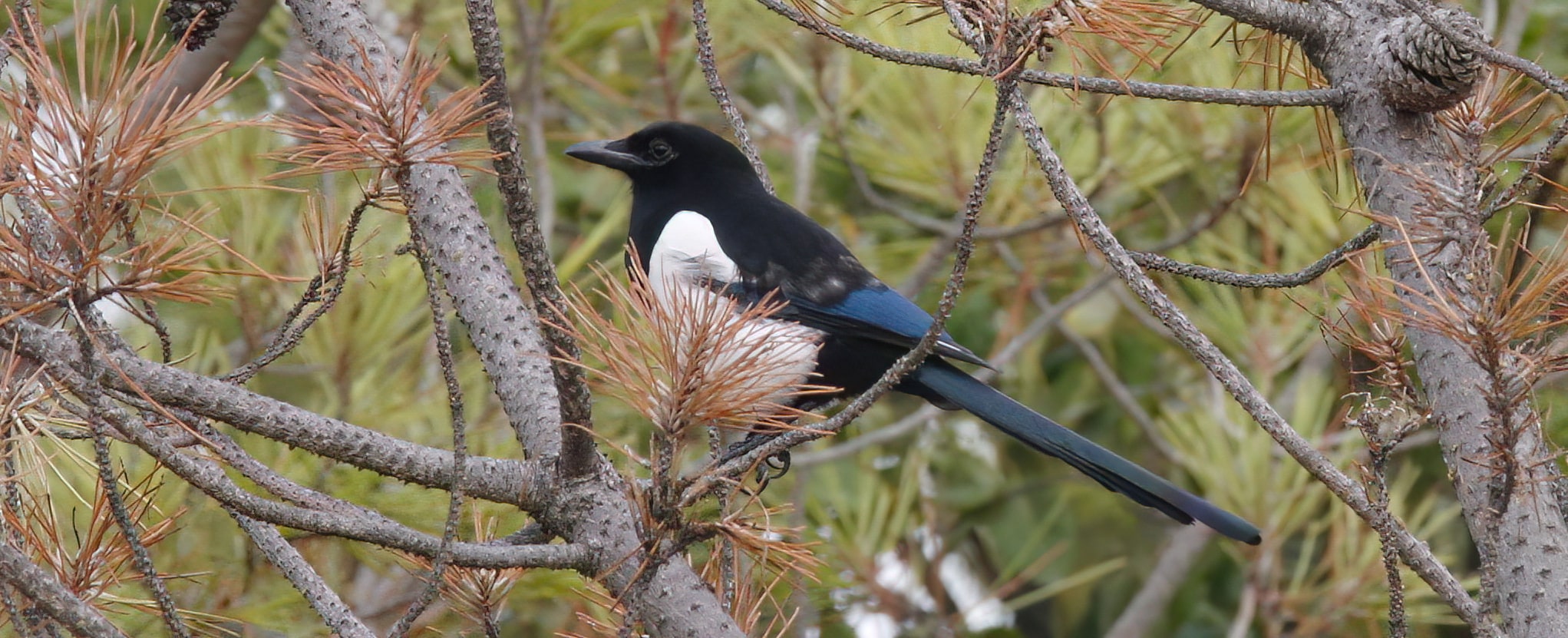
Pica pica melanotos -  Iberian Magpie
Iberian Magpie 
![]() pega-rabuda
pega-rabuda  spanyolszarka
spanyolszarka
(Olhão, Quinta de Marim, park)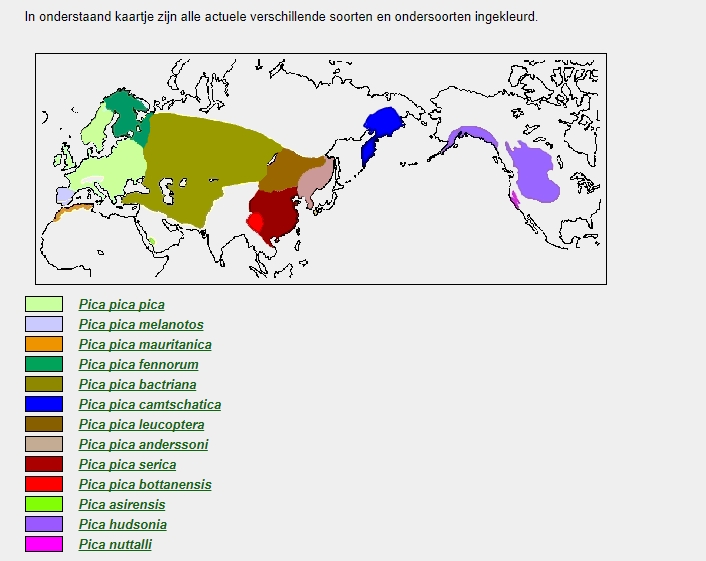
● ssp melanotos: smaller than nominate, black rump (seen only in flight), there is a few bare-skin spot around/behind the eye (not an obvious sign in all individual); Iberian Peninsula
● ssp mauritanica (Maghreb Magpie) (NW Africa) has a much bigger and always clear blue bare skin spot behind its eyes (Wiki)
● widespread but not so common and abundant as the Central European nominate in C-Europe
● plant in photo: Pinus pinaster - Maritime Pine, tengerparti fenyő
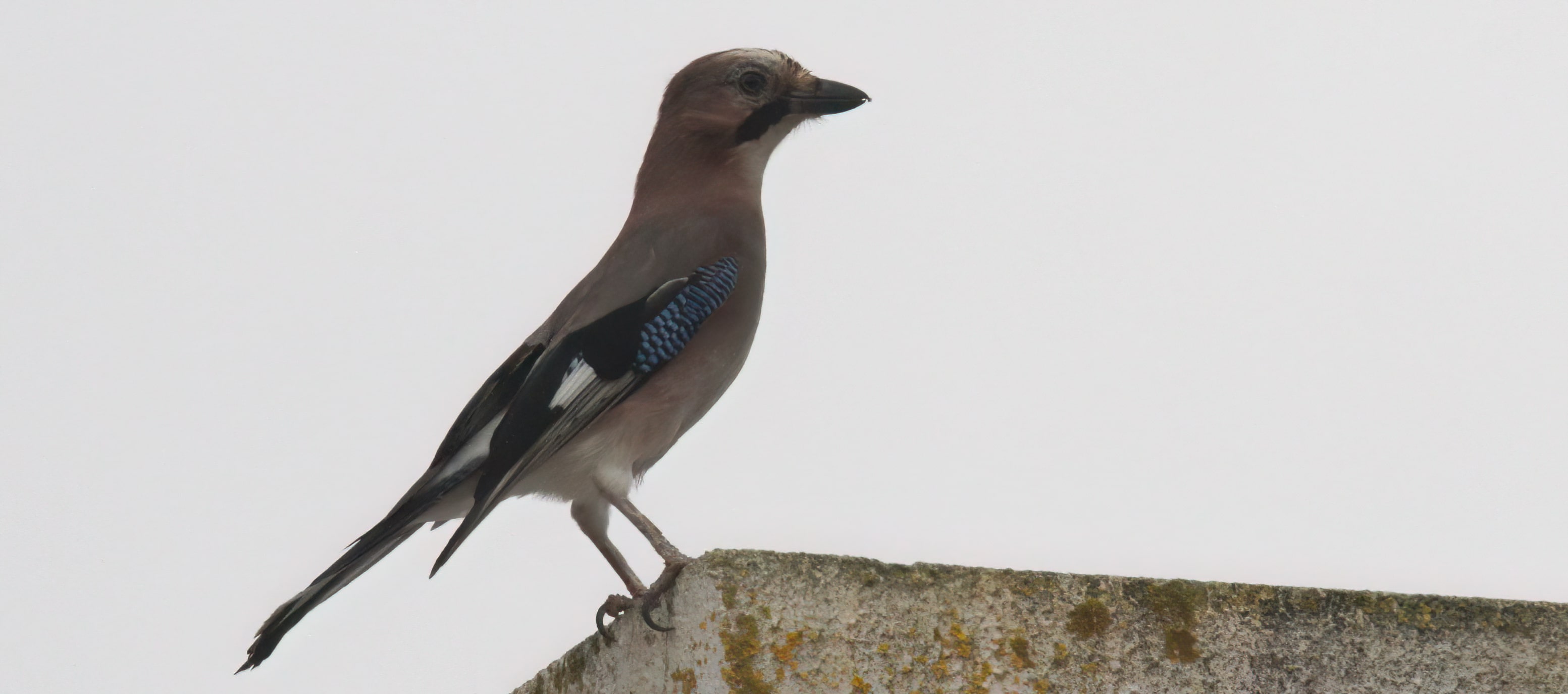
Garrulus glandarius fasciatus -  South Iberian Jay
South Iberian Jay 
![]() gaio-comum
gaio-comum  szajkó
szajkó
(Olhão, Quinta de Marim, park)
● ssp fasciatus: has a somewhat darker breast, clearly shorter tail and tarsus than nominate
● ssp lusitanicus is just a race and a merged synonym of ssp fasciatus
● this bird was the only one I saw (in Olhão) all over the whole tour, despite the Iberian Jay is known widespread in Portugal
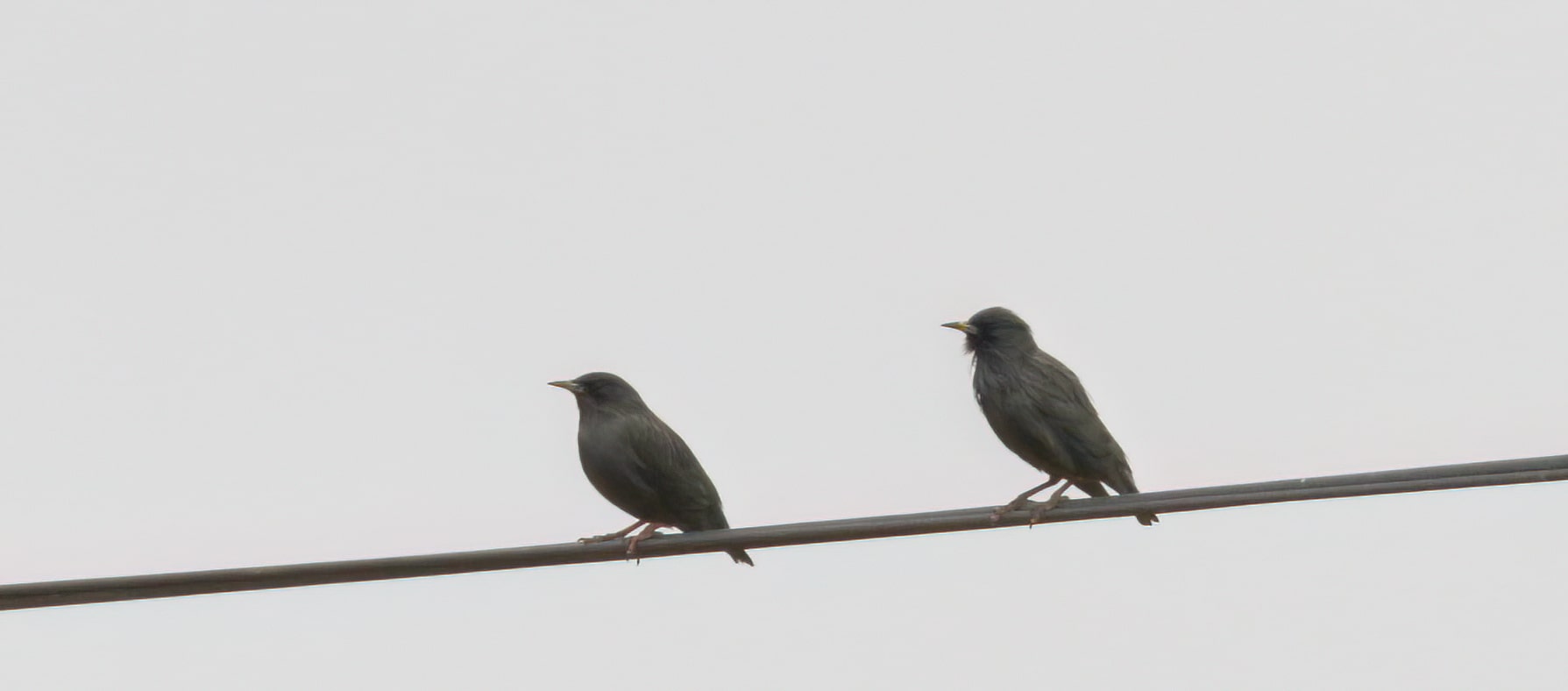
Sturnus unicolor -  Spotless Starling
Spotless Starling 
![]() estorninho-preto
estorninho-preto  egyszínű seregély
egyszínű seregély
(Castro Marim, near São Bartolomeu)
● highly gregarious and social birds
● a smaller group is singing-chatting on wires at a low-traffic road in Castro Marim
● huge flocks roost on coastal trees of Faro city in the evening
● not even a single S. vulgaris vulgaris were seen in this week, Common Starlings spend only their winter months in Portugal

Carduelis carduelis parva -  European Goldfinch
European Goldfinch 
![]() pintassilgo-comum
pintassilgo-comum  tengelic
tengelic
(Faro, downtown lagoons)
● ssp parva: somewhat smaller than nominate, paler brown mantle on back (honestly, I don't see these differences here...)
● common and widespread everywhere in the Algarve, but scarce in the Sagres region
● plant in photo: Cynara sp - Cardoon
● the Portuguese name pintassilgo also means another bird in Brazil, the Hooded Siskin (>Spinus magellanicus)
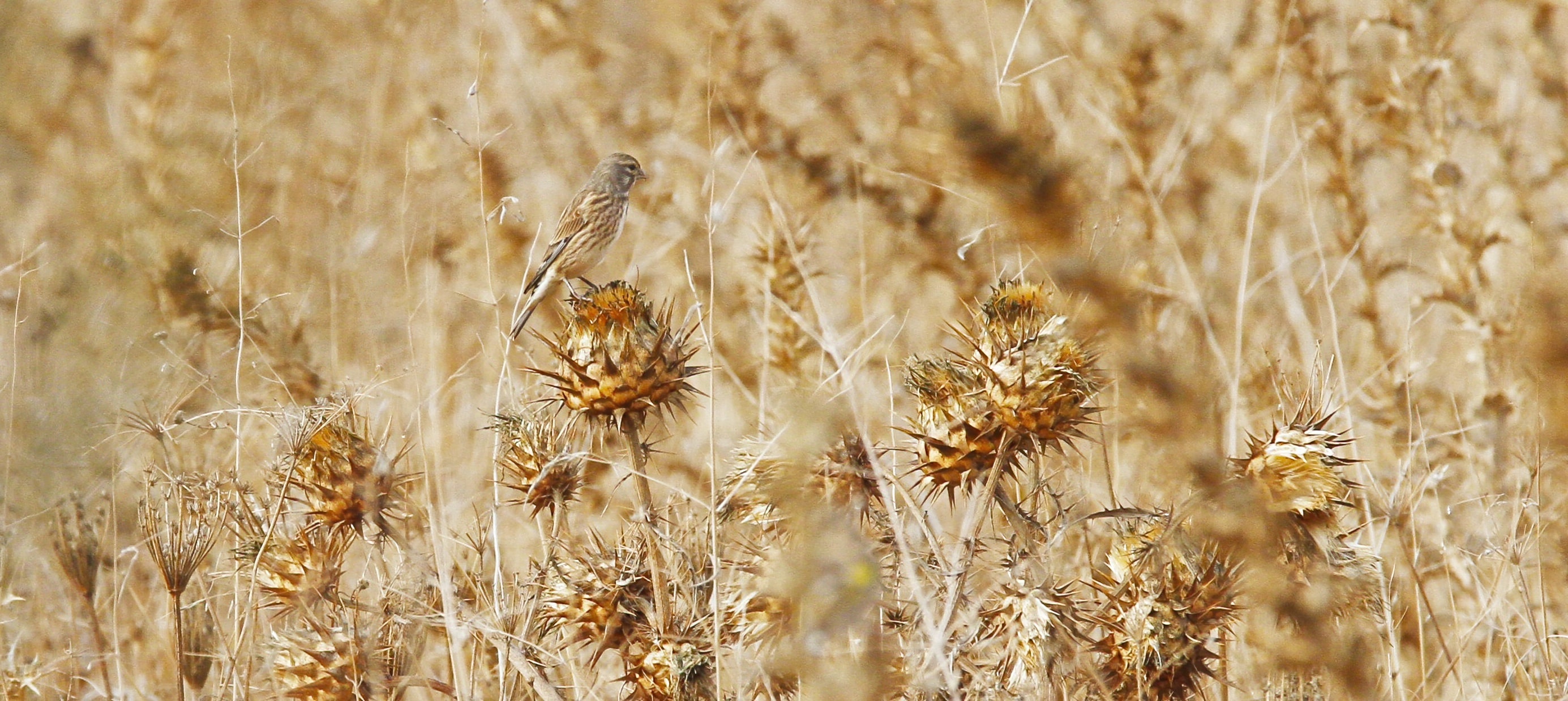
Linaria cannabina mediterranea -  Mediterranean Linnet
Mediterranean Linnet 
![]() pintarroxo-comum
pintarroxo-comum  kenderike
kenderike
(Vilamoura, Canal de Vilamoura)
● ssp mediterranea: shorter-winged and paler, less colorful than nominate; Mediterranean region
● rarely seen but once managed to find a bigger flock in the dry fields of Vilamoura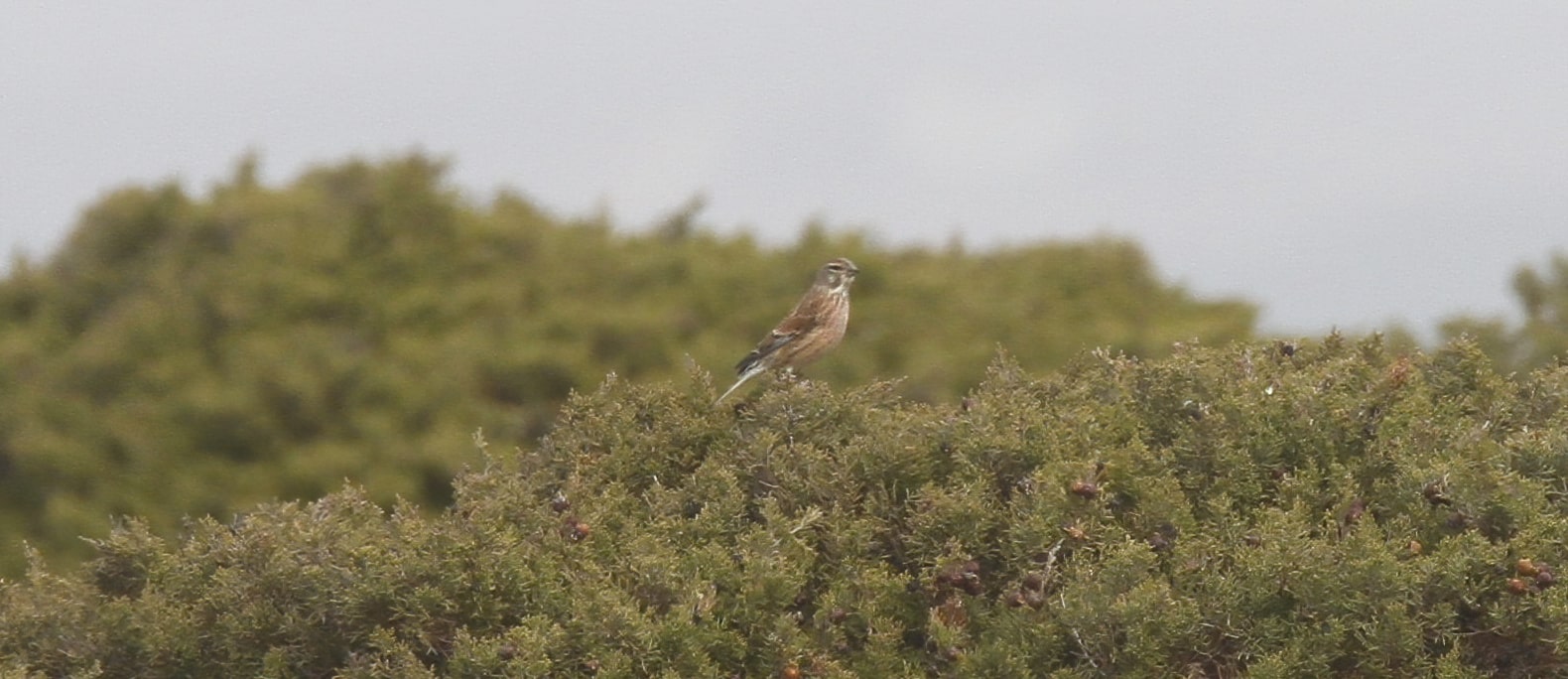
● a single bird found in Sagres region (small pic) (maybe a migrant bird) which doesn't show evaluable difference from the individuals of the Vilamoura-flock (for me...) ➤
● plant in big photo (Vilamoura): Cynara sp - Cardoon
● plant in small photo (Cabo de São Vicente): Juniperus phoenicea - Phoenician Juniper, föníciai pikkelyboróka
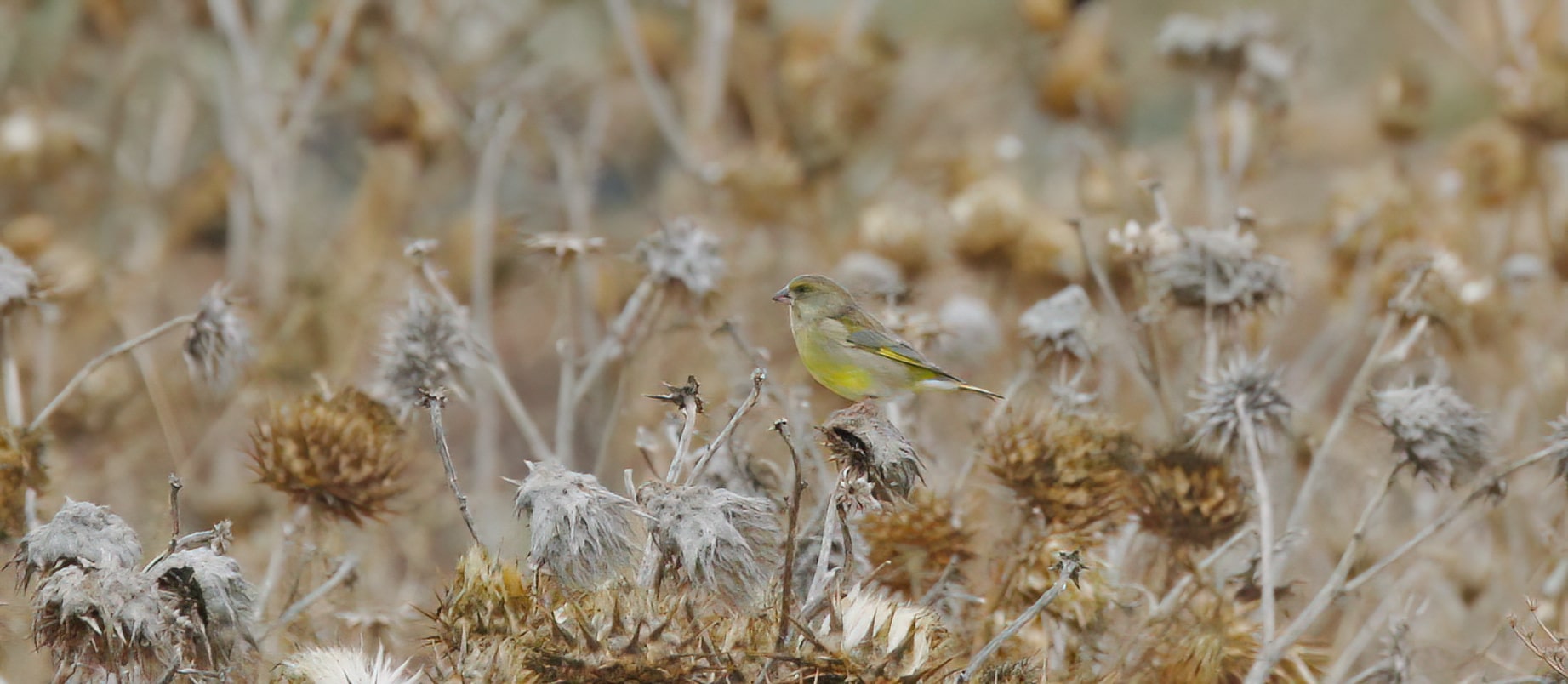
Chloris chloris vanmarli -  West Mediterranean Greenfinch
West Mediterranean Greenfinch 
![]() verdilhão
verdilhão  zöldike
zöldike
(Vilamoura, Canal de Vilamoura)
● ssp vanmarli: darker and greener upperparts, belly is more golden and less yellow; NW Morocco and W Iberian Peninsula
● beyond the HBW description written above, I see some kind of size difference of the bill, too: smaller in ssp vanmarli and larger at home in Central European nominate (ssp chloris)
● seen in more elevated numbers in arid fields near the Vilamoura Canal, sometimes in mixed groups with Linnets
Other finches:
● another species in similar numbers (found in the previously marked Fringillidae hotspots (Vilamoura, Castro Marim)) was Serinus serinus serinus - European Serin (csicsörke)
● some Emeriza calandra calandra - Corn Bunting (sordély) also seen in these regions but in much lower numbers

Passer hispaniolensis hispaniolensis -  Spanish Sparrow
Spanish Sparrow 
![]() pardal-espanhol
pardal-espanhol  berki veréb
berki veréb
(Castro Marim, Esteiro da Carrasqueira)
● seen occasionally in Tavira, Vilamoura and Castro Marim, and always in close proximity of water
● more widespread in the Alentejo region in Portugal
● P. hispaniolensis: white supercilium, brown head, bulkier and stronger bill, no spot on ear as Tree Sparrow (P. montanus) has, heavily spotted breast and back
● the nominate race lives in the Western Mediterraneum including the Iberian Peninsula
● much less 'domesticated' as the House Sparrow (P. d. domesticus), lives in rural and wild habitats
Other sparrows:
● other Passer species in the Algarve: found P. d. domesticus in huge numbers everywhere, Tree Sparrow P. montanus was completely absent somehow in this week (for me...)
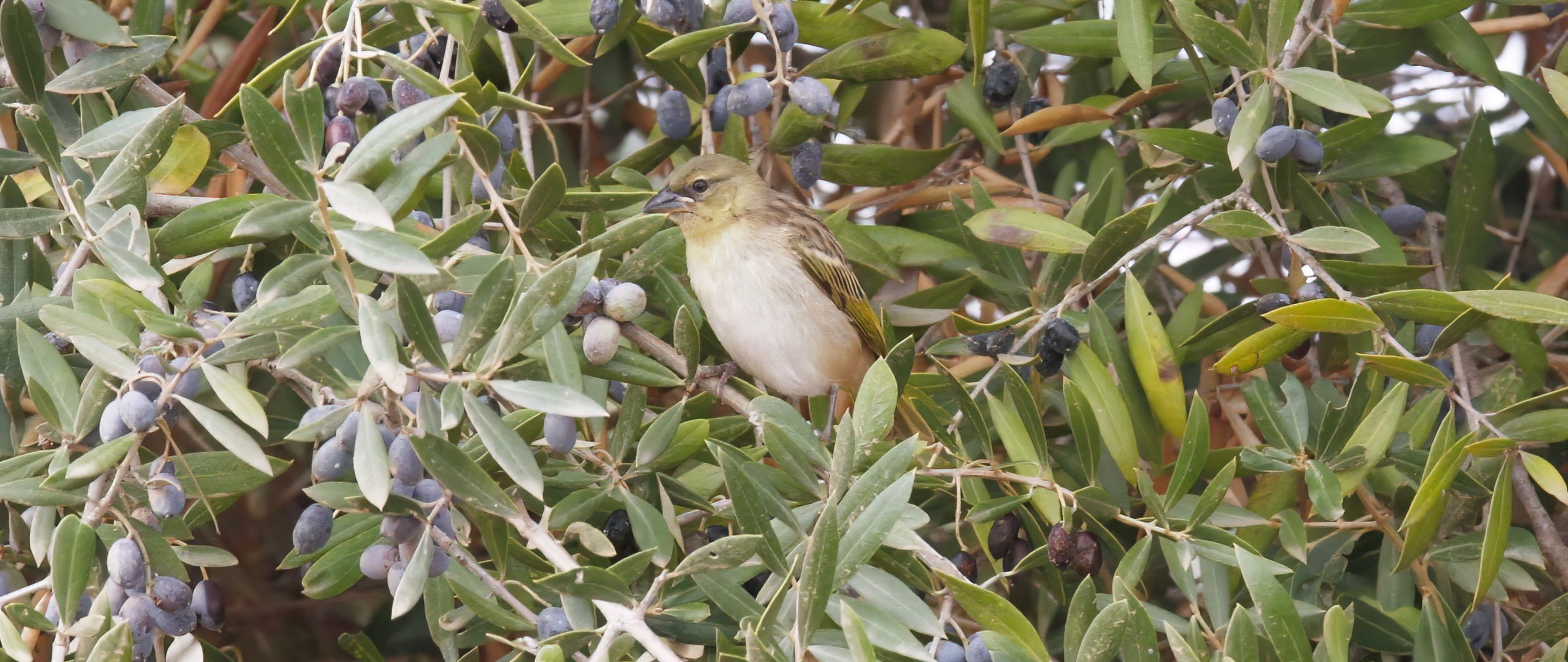
Ploceus melanocephalus -  Black-headed Weaver
Black-headed Weaver 
![]() tecelão-de-cabeça-preta
tecelão-de-cabeça-preta  feketefejű szövőmadár
feketefejű szövőmadár
(Vilamoura, olive plantation)
● typical gregarious bird of the African savannas, introduced into the Iberian Peninsula where small breeding populations live today in vegetation dense areas near lakes and rivers in Portugal (Cat C)
● seen two birds in Quinta do Lago and a single one in Vilamoura, all of them close to freshwater, all of them female/immature
● generally nests in flocks but the nests are individual ➤
● also found a single nest in the reeds in Quinta do Lago (small photo) ➤
● plant in big photo: Olea europaea - European Olive, olajfa
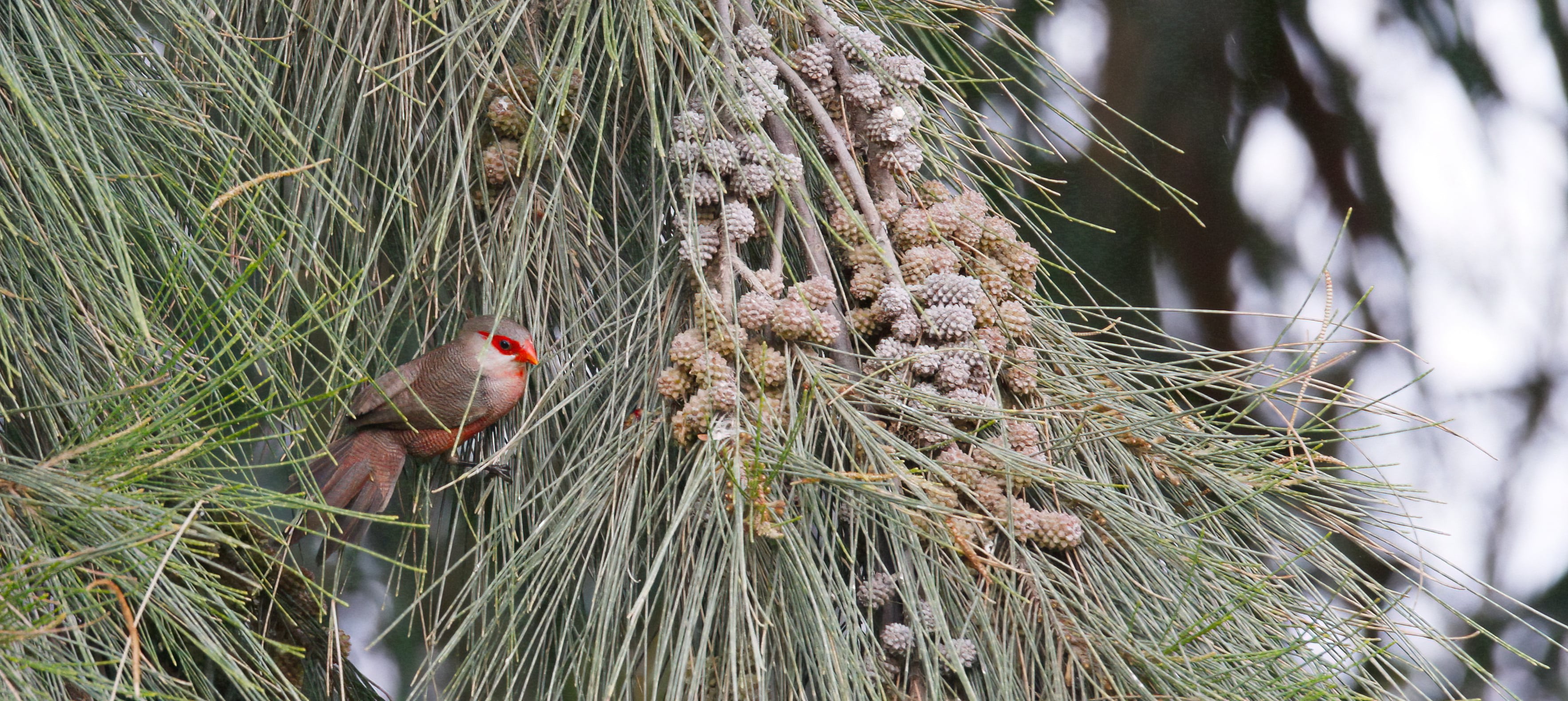
Estrilda astrild jagoensis -  Common Waxbill
Common Waxbill 
![]() bico-de-lacre
bico-de-lacre  Helena-pinty
Helena-pinty
(Vilamoura, near the water plant)
➤ a small group in the lagoons near the airport ➤
● ssp jagoensis: the most popular SW-African (Angola) subspecies for aviculture, today independent breeding populations in Portugal and in Spain (Cat C)
● exported from Sub-Saharan Africa as a pet worldwide but mainly into Europe and America
● found their flocks always around vegetated edges of waterbodies (shrubs of tidal marshes in Faro and Olhão, or tree alleys of waterwork in Vilamoura)
● plant in photo (Vilamoura): Casuarina equisetifolia - Australian 'Pine Tree' (Beach She-Oak), zsurlólevelű kazuárfa
● plant in video (Faro): Arthrocnemum macrostachyum - Glaucous Glasswort
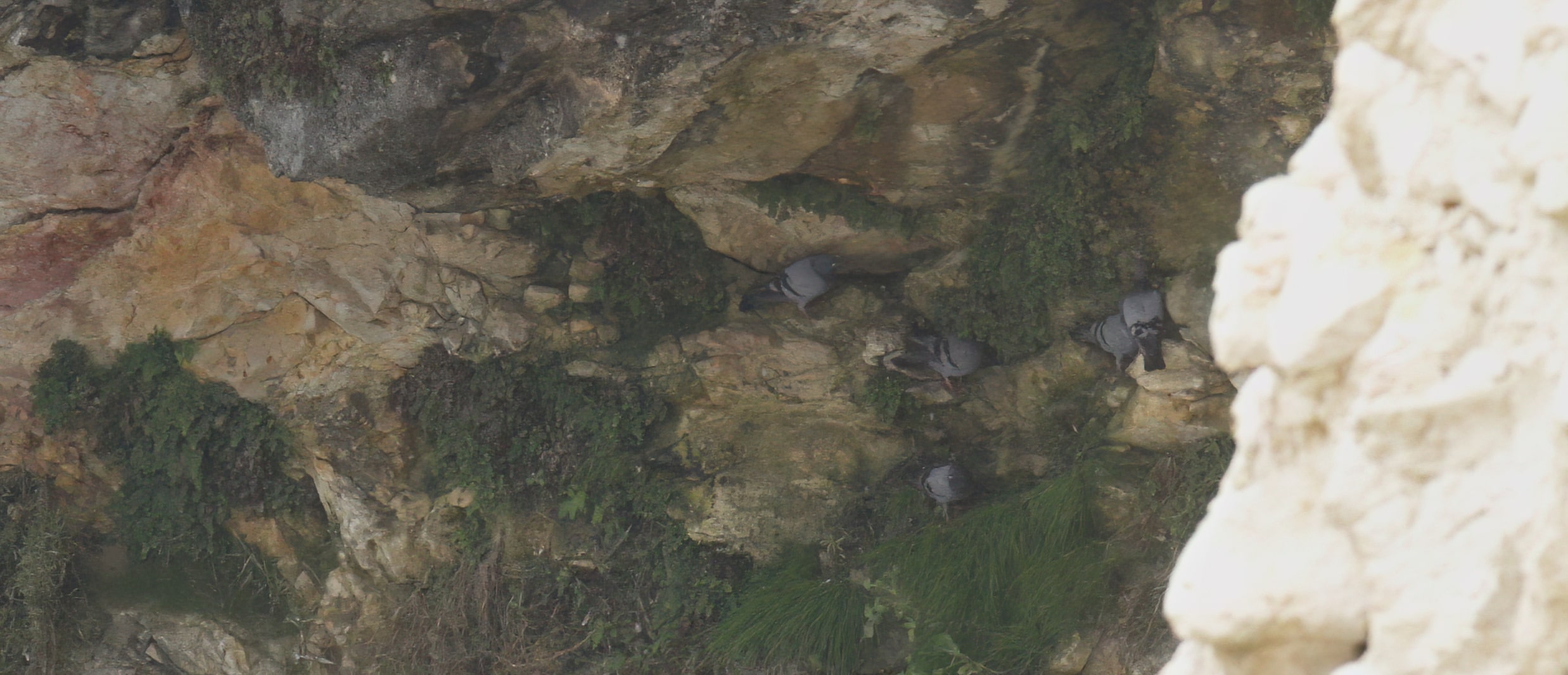
Columba livia -  Rock Dove
Rock Dove 
![]() pombo-das-rochas
pombo-das-rochas  szirti galamb
szirti galamb
(Cabo de São Vicente, coastline)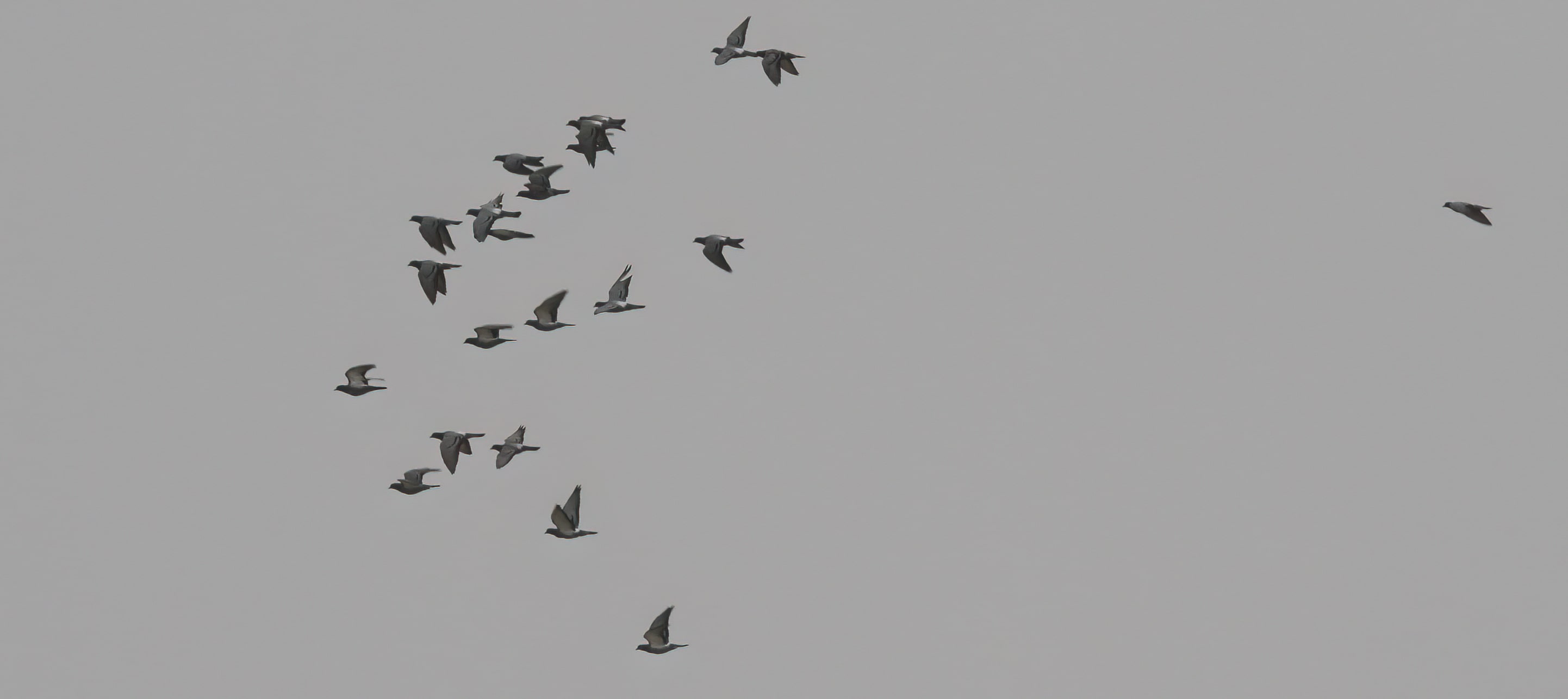
● the nominate race lives in the W Mediterraneum
● common around the coastal cliffs of the Sagres region, but seen nowhere else in this tour
● flocks nest in hidden corners of steep cliffs
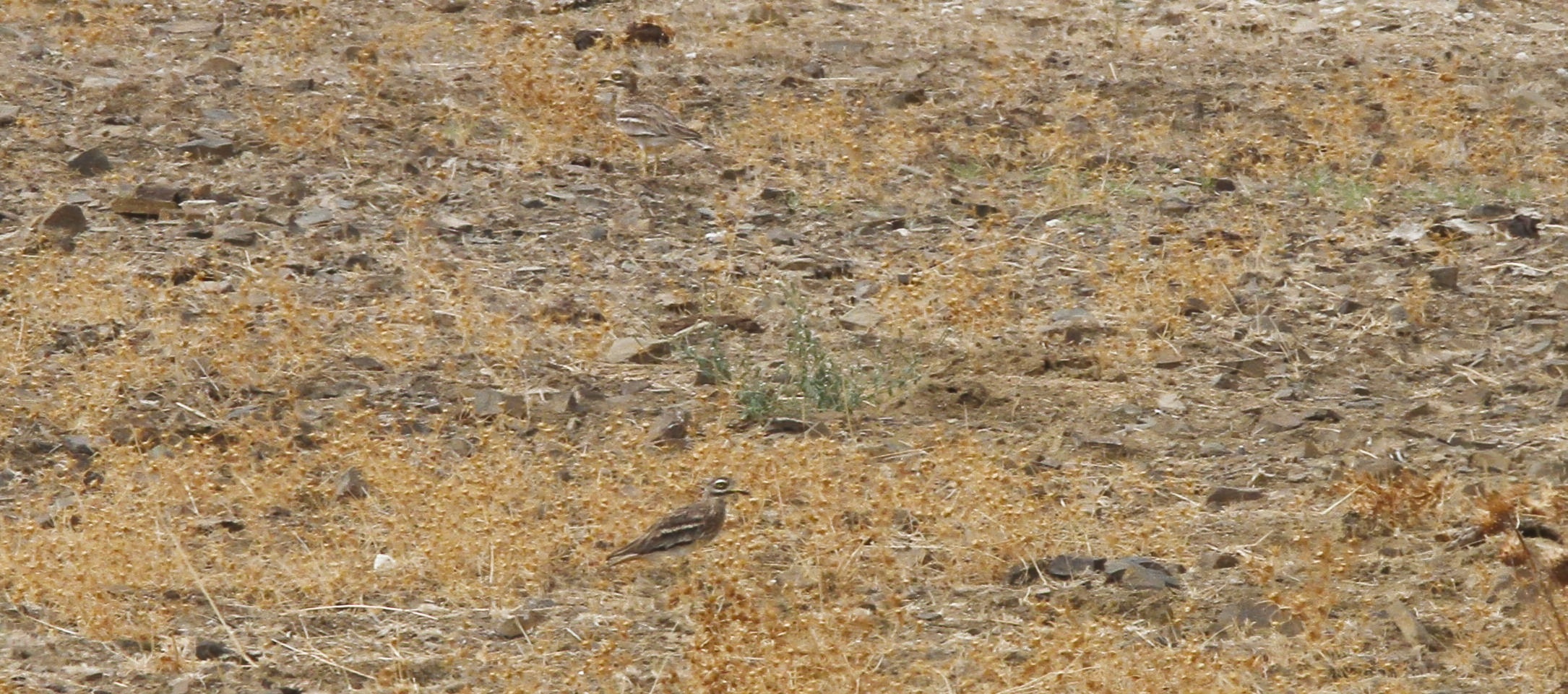
Burhinus oedicnemus -  Stone-Curlew
Stone-Curlew 
![]() alcaravão
alcaravão  ugartyúk
ugartyúk
(Castro Marim, arid slope)
● seen only 4 individuals in a loose group in the marked Eastern arid grassfields of Castro Marim
● despite its open habitat Stone-Curlew is a very elusive bird
● all-year-round resident in Southern regions of the Iberian Peninsula
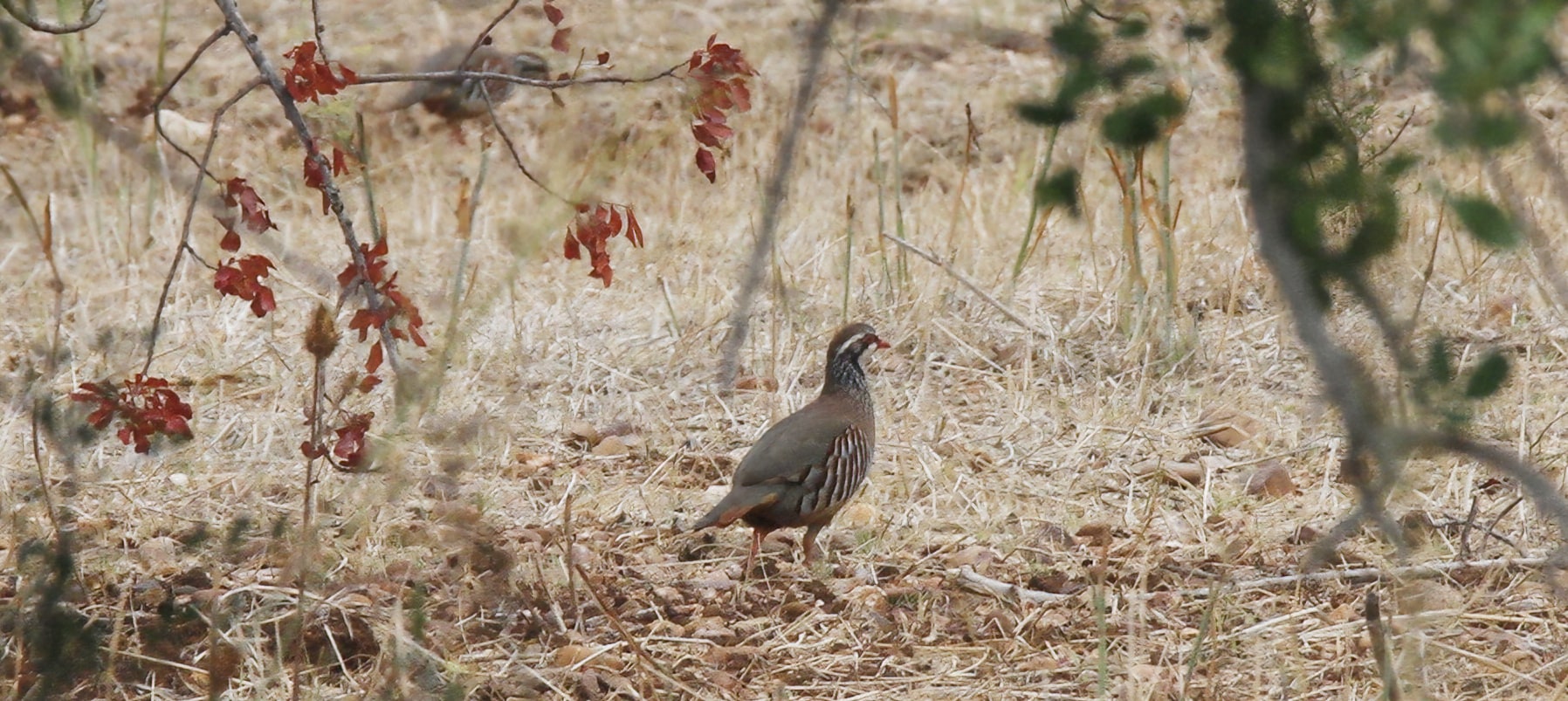
Alectoris rufa hispanica -  Red-legged Partridge
Red-legged Partridge 
![]() perdiz-vermelha
perdiz-vermelha  vörös szirtifogoly
vörös szirtifogoly
(Castro Marim, hill with trees)
● ssp hispanica: overall brighter colouration, bright chestnut nape; Iberian region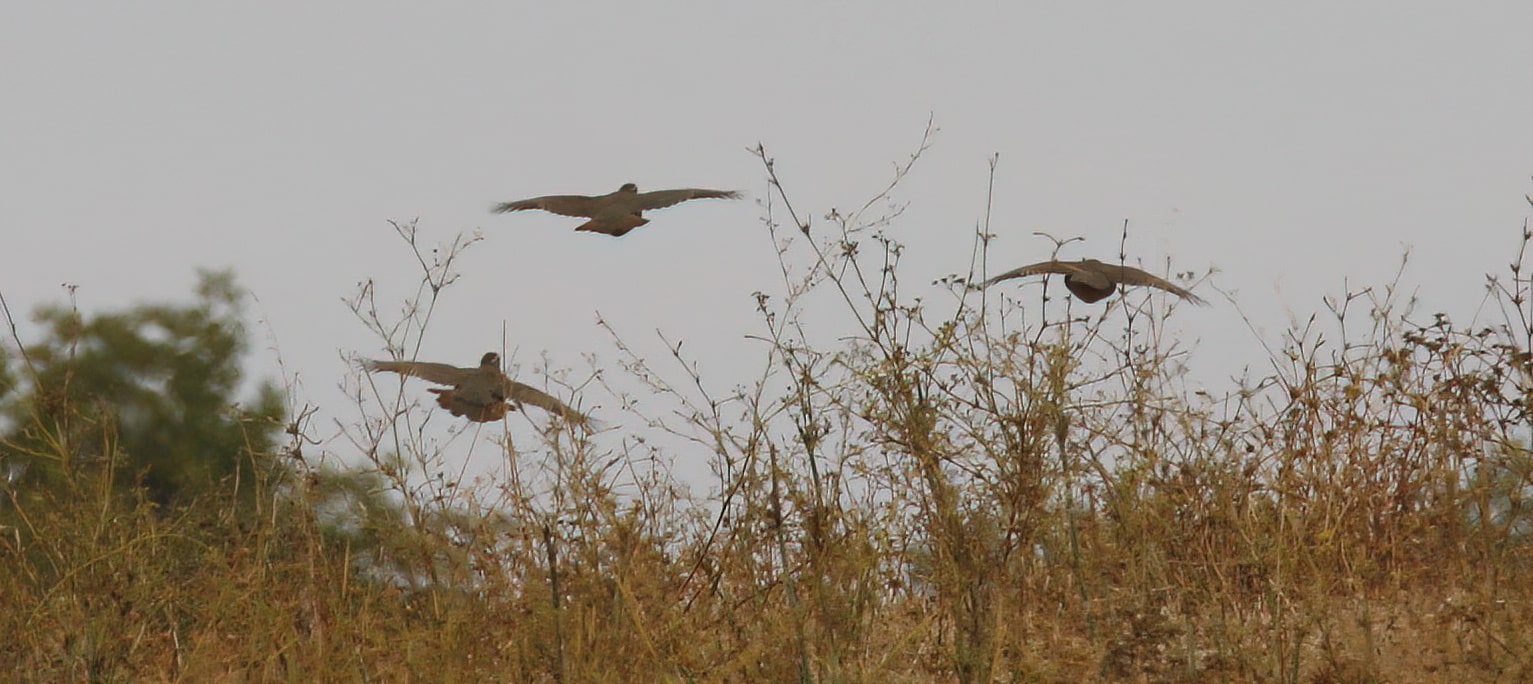
● only found a small flock in the arid hills of Castro Marim, near the pastures and near the Esteiro da Carrasqueira
● at first sight I saw the flock flying from the shrubs to the sparse alleys of a hill ➤
● in flight their general apperance is similar to the European Grey Partridge (>P. perdix) but without patterns on wing upperparts and with an obvious and striking white supercilium above the eye
● in autumn and winter they are in small groups called coveys before they separate into pairs in spring
● Red-legged Partridge is a game bird in Portugal, but beside breeds there are natural and wild populations in natural reserves such as Sapal de Castro Marim
● Grey Partridge (Perdix perdix) only occurs in the North-eastern corner of Portugal
● Common Pheasant (Phasianus colchicus) is present near Lisbon and Braga, but missing all other region in Portugal
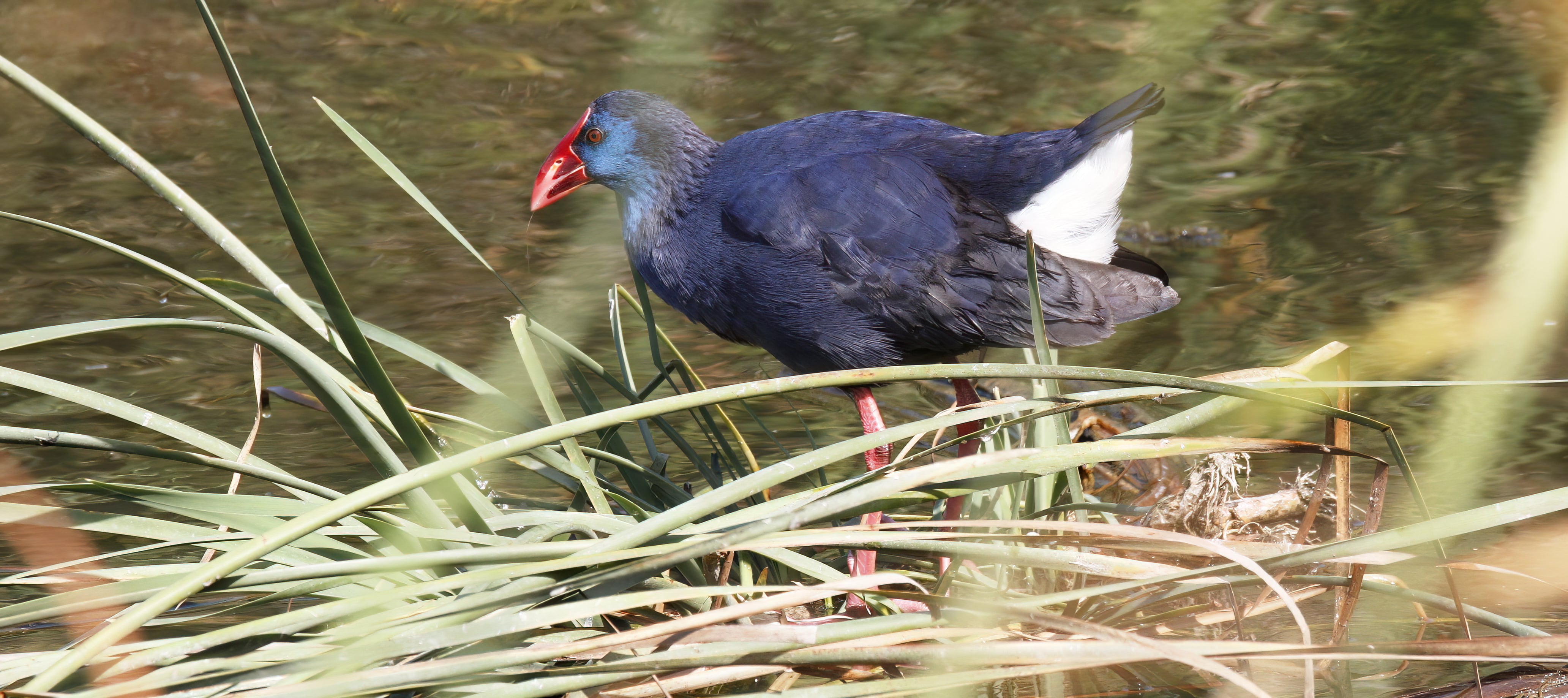
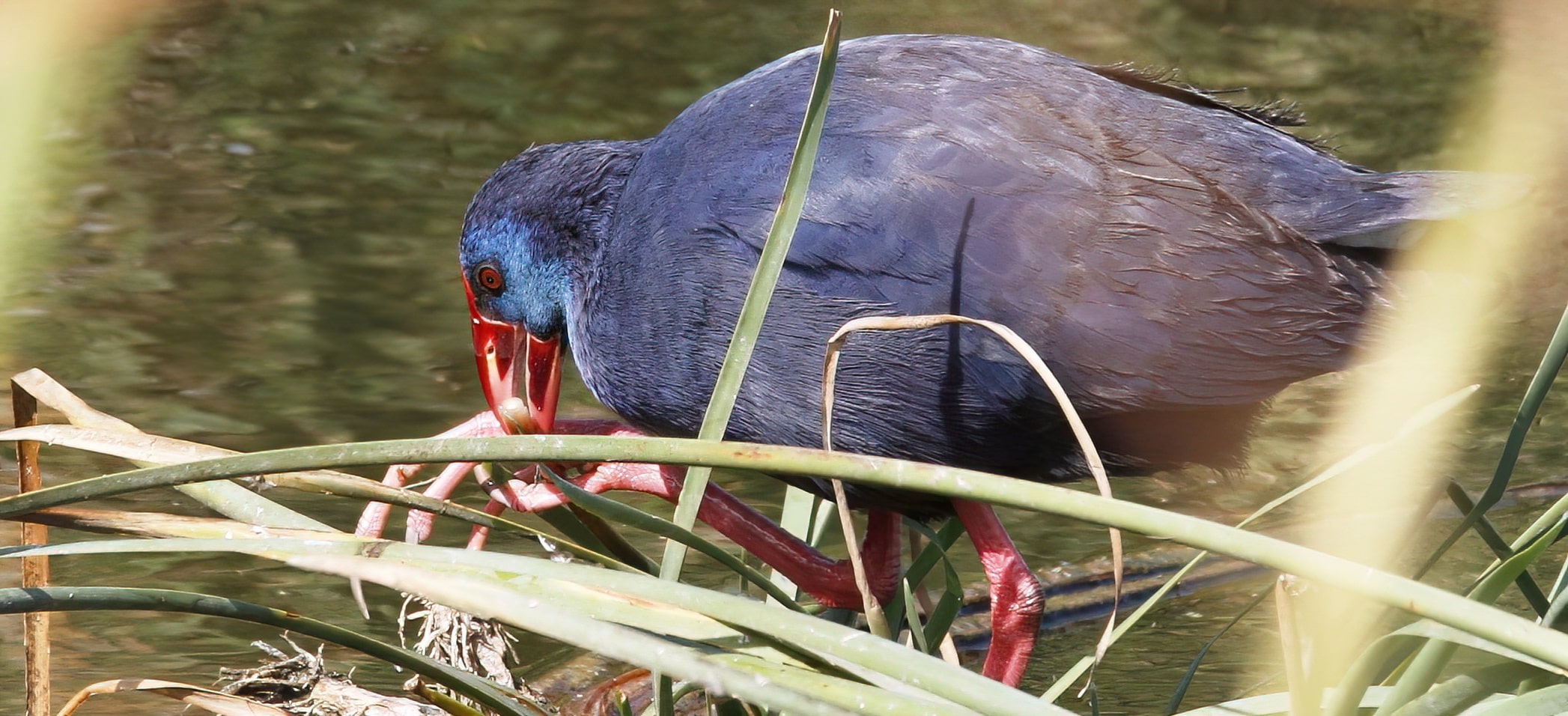
Porphyrio porphyrio -  Purple Swamp-Hen
Purple Swamp-Hen 
![]() camão
camão  kék fú
kék fú
(Faro, Quinta do Lago)
● the real bigfoot
● the very best species of this whole week (many thanks to Guillaume Réthoré!)
● expected a very rare and elusive bird deeply hidden in a highly protected military zone, but Purple Swamp-Hens just stroll along the edge of lake Quinta do Lago and the near golf courses
● altogether, I counted 6 of them mostly in the reeds or on the border of golf lawn and reeds
● one of them seen quietly swimming across the lake in the sunny afternoon...
● plant in photo: Typha latifolia - Broadleaf Cattail, széleslevelű gyékény
Other Rallidae species:
● in wetland habitats (Ludo, Quinta do Lago, Vilamoura, Olhão, Castro Marim) were Gallinula chloropus chloropus (Common Moorhen) in low numbers, and Fulica atra atra (Eurasian Coot) in abundant amounts
● unfortunately, another big goal of this trip, the Red-knobbed Coot (Fulica cristata) (bütykös szárcsa) remained hidden for me, but according to ebird it undoubtedly exists in Ludo and in Quinta do Lago
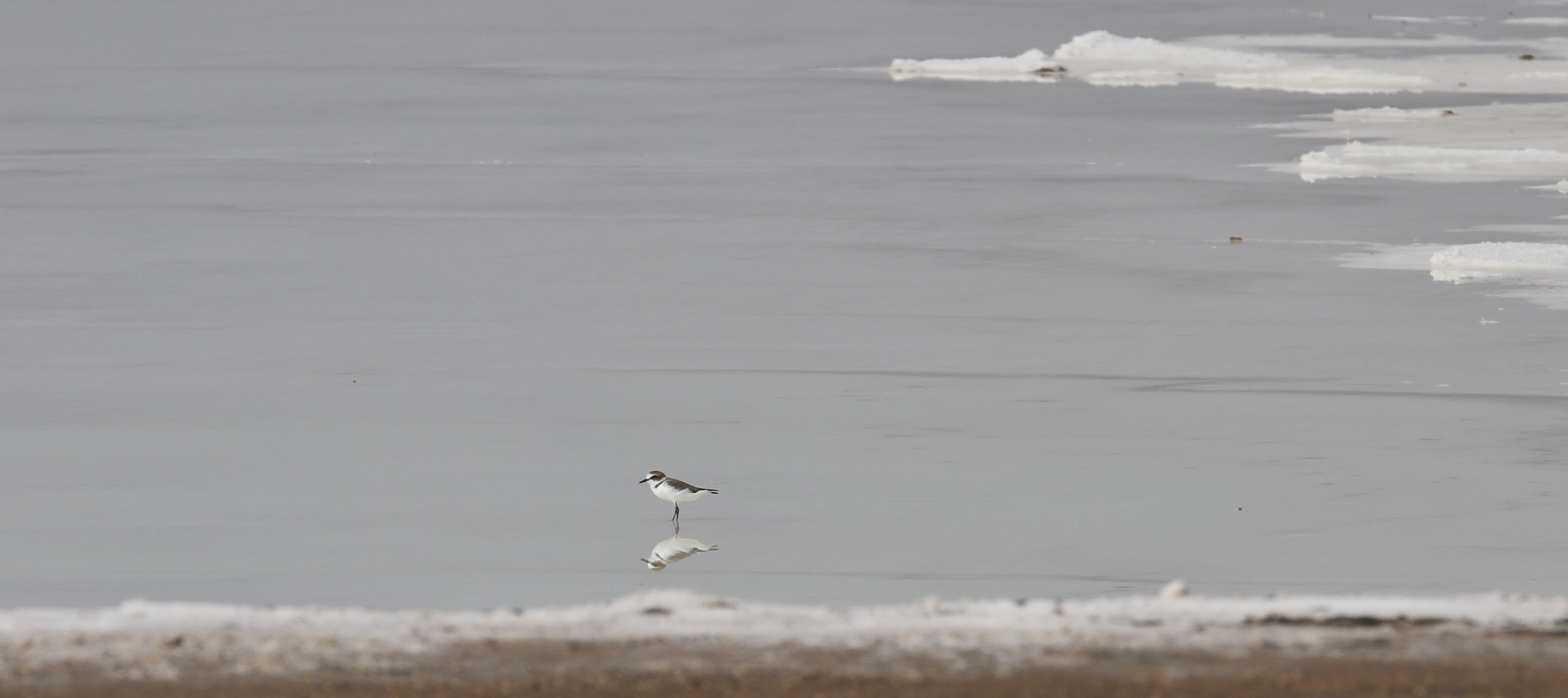
Charadrius alexandrinus -  Kentish Plover
Kentish Plover 
![]() borrelho-de-coleira-interrompida
borrelho-de-coleira-interrompida  széki lile
széki lile
(Tavira, salt pans and lagoons)
● the most common shorebird all over the Algarve
● seen in groups on every beach and every tidal shoreline
● year-round resident in the Southern coasts of Iberia
● none of the observed birds wear the reddish summer plumage cap (maybe one in transitional state: big picture above)
● other species represented the Charadriidae group spend only their winters in Portugal: Charadrius hiaticula hiaticula - Common Ringed Plover (parti lile) seen in also significant numbers, Pluvialis squatarola - Grey Plover (ezüstlile) in reduced numbers, and encountered only a single one individual of Vanellus vanellus - Northern Lapwing (bíbic) in the wet marshes of Castro Marim

Calidris alba -  Sanderling
Sanderling 
![]() pilrito-das-praias
pilrito-das-praias  fenyérfutó
fenyérfutó
(Faro, Praia de Faro)
● common on sandy beaches, not excluding even the city beach of Faro
● winters in the Algarve
● an article by Graham Appleton (BTO) with very good migrational maps and many others: Which Wader, When and Why?
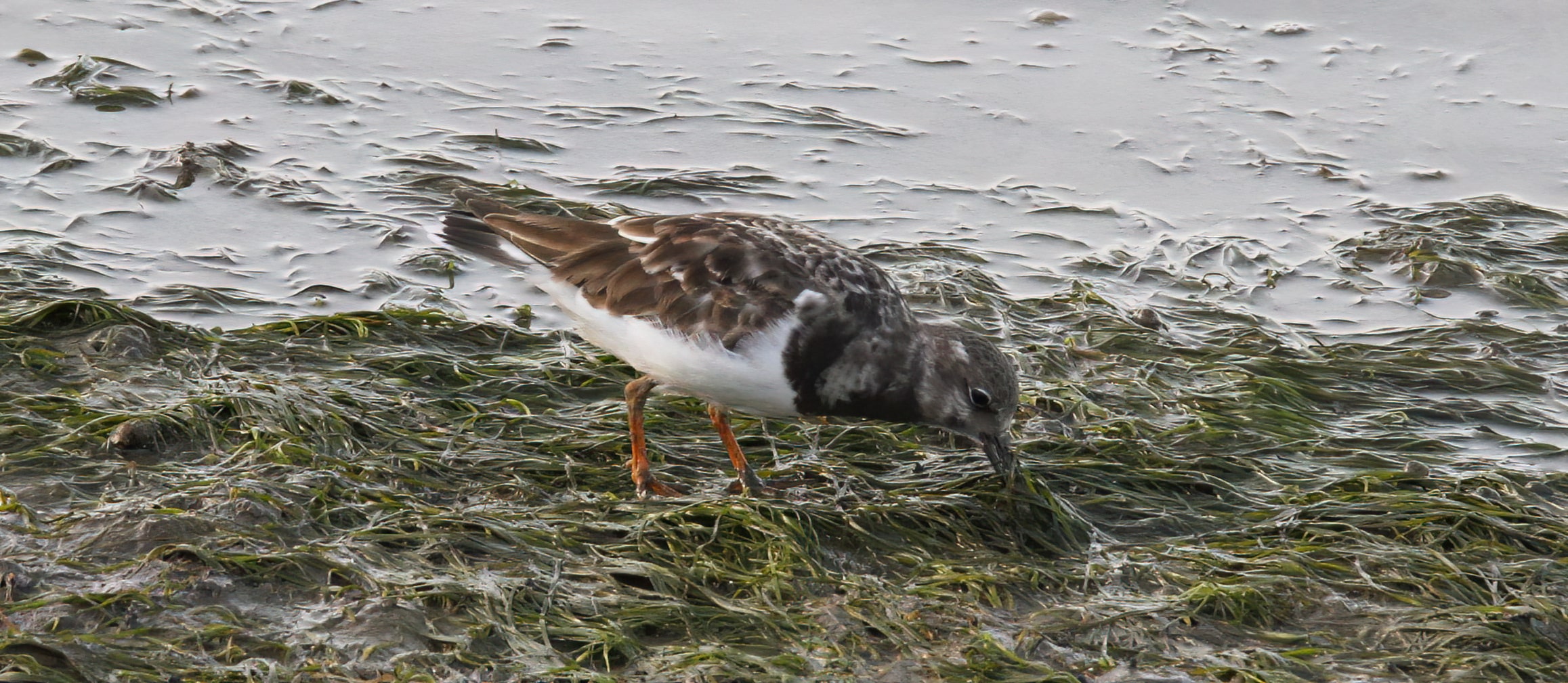
Arenaria interpres -  Turnstone
Turnstone 
![]() rola-do-mar
rola-do-mar  kőforgató
kőforgató
(Faro, Doca de Faro)
➤ late afternoon leisure time program for Turnstones ➤
● one of the most common Scolopacidae species, found in every tidal habitats
● background calls in video: Tringa totanus - Common Redshank (piroslábú cankó)
● background crab in video: Afruca tangeri - Fiddler Crab
● plant in photo (at low tide): Posidonia oceanica - Mediterranean Tapeweed (neptunfű)
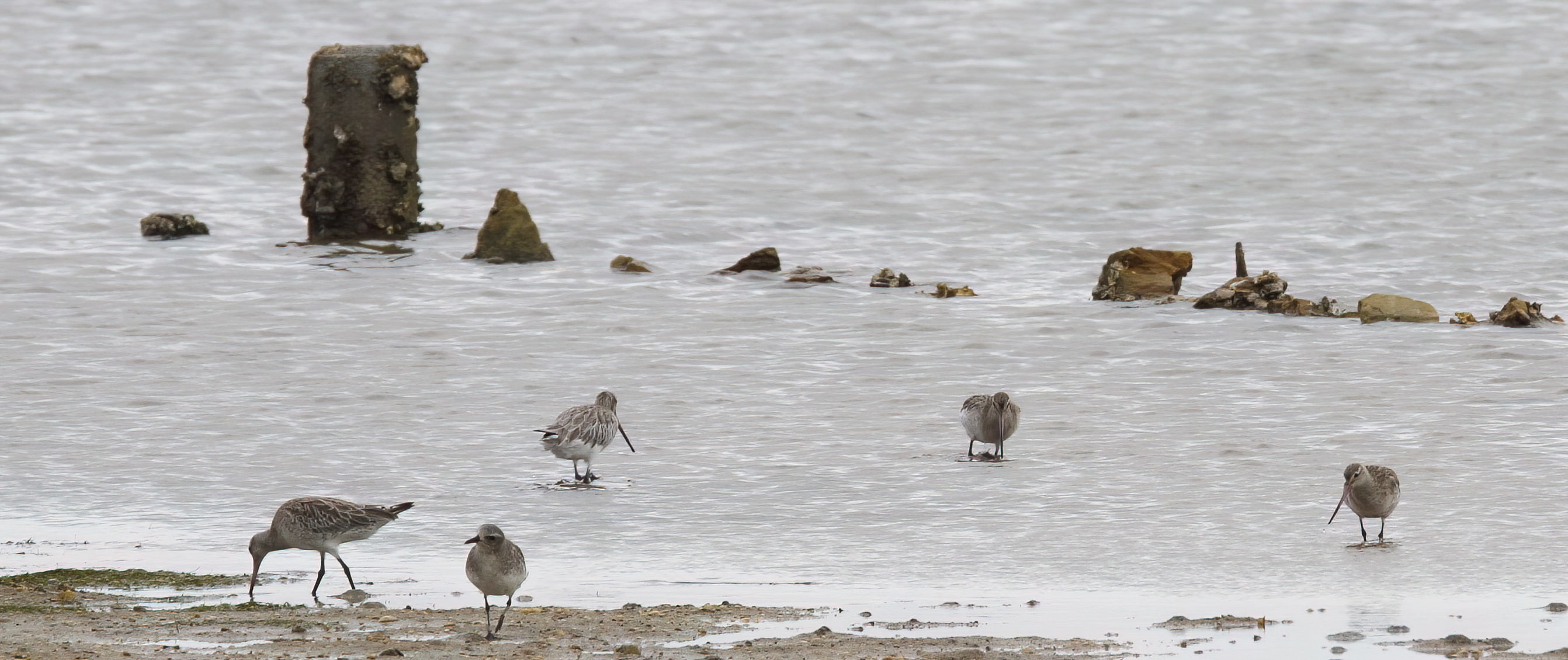
Limosa lapponica -  Bar-tailed Godwit
Bar-tailed Godwit 
![]() fuselo
fuselo  kis goda
kis goda
(Olhão, Quinta de Marim)
● found only one little group in the tidal mud flat in Quinta de Marim
● Limosa limosa - Black-tailed Godwit (nagy goda) was much more common, but they rather preferred freshwater habitats (as far as I saw...)
● mixed groups of shorebirds were dominated in numbers by:
- the two Charadrius species previously mentioned (C. alexandrinus, C. hiaticula)
- Calidris alpina alpina - Dunlin (havasi parfutó)
- Tringa totanus totanus - Common Redshank (piroslábú cankó)
- Arenaria interpres - Turnstone (kőforgató)
● in lower numbers were still present mostly:
- Numenius phaeopus phaeopus - Whimbrel (kis póling) (on the right in small photo) ➤
- Limosa limosa - Black-tailed Godwit (nagy goda)
- Pluvialis squatarola - Grey Plover (ezüstlile)
- Himantopus himantopus - Black-winged Stilt (gólytöcs)
- Recurvirostra avosetta - Pied Avocet (gulipán)
- Haematopus ostralegus - Oystercatcher (csigaforgató)
- Calidris ferruginea - Curlew Sandpiper (sarlós partfutó)
- Calidris alba - Sanderling (fenyérfutó)
- Tringa nebularia - Common Greenshank (szürke cankó)
- Actitis hypoleucos - Common Sandpiper (billegetőcankó)
● I found these shorebird species rare during this trip in this category:
- Calidris minuta - Little Stint (apró partfutó) - 1 in Tavira, 3 in Castro Marim
- Limosa lapponica lapponica - Bar-tailed Godwit (kis goda) - only one group of 9 birds in Olhão
- Numenius arquata - Eurasian Curlew (nagy póling) - the same 1 bird but twice in Faro (on the left in small photo) ➤
- Vanellus vanellus - Northern Lapwing (bíbic) - 1 passing by in Castro Marim's marshes
- Tringa ochropus - Green Sandpiper (erdei cankó) - 1 flown over in Castro Marim's marshes
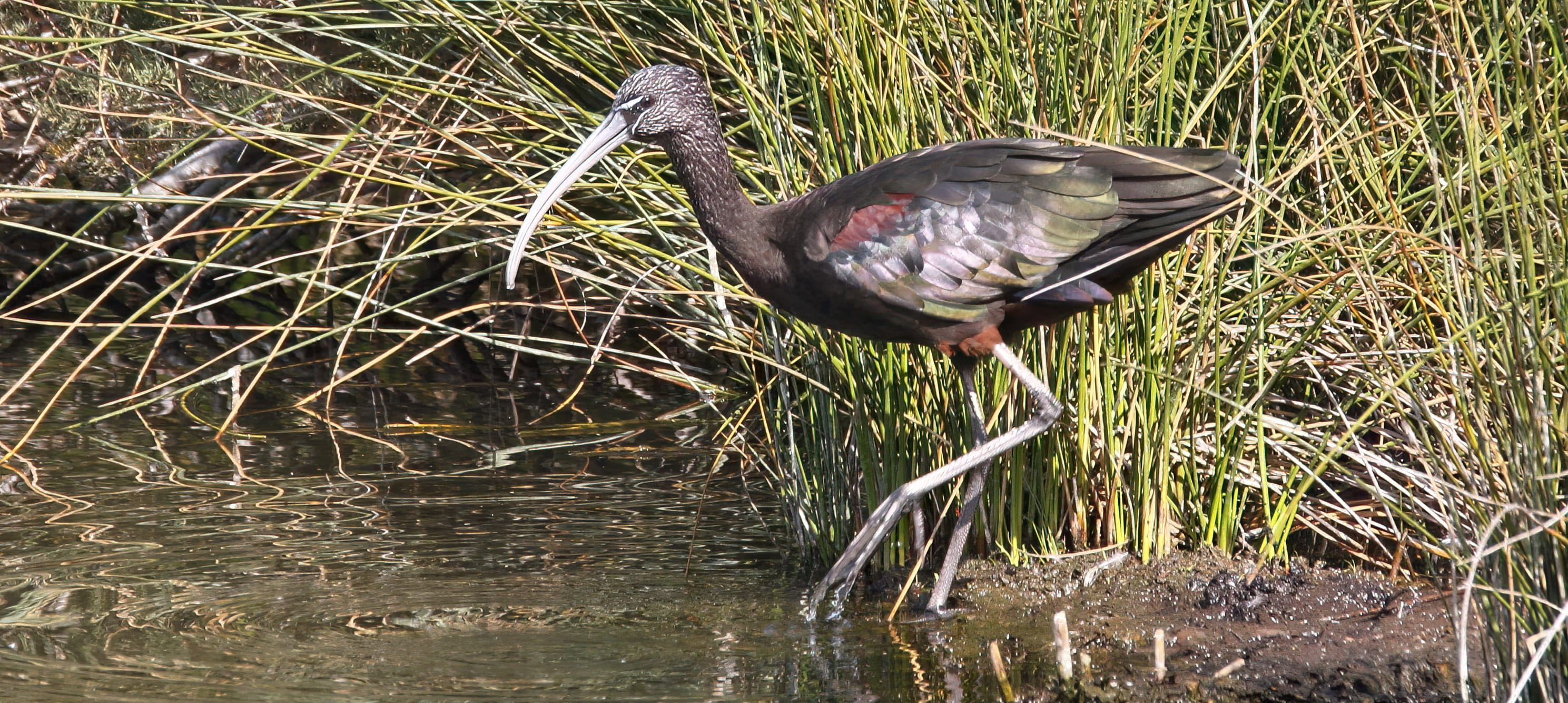
Plegadis falcinellus -  Glossy Ibis
Glossy Ibis 
![]() ibis-preta
ibis-preta  batla
batla
(Faro, Quinta do Lago)
● seen only in Quinta do Lago (8 birds altogether)
● plant: Typha angustifolia - Narrowleaf Cattail, keskenylevelű gyékény
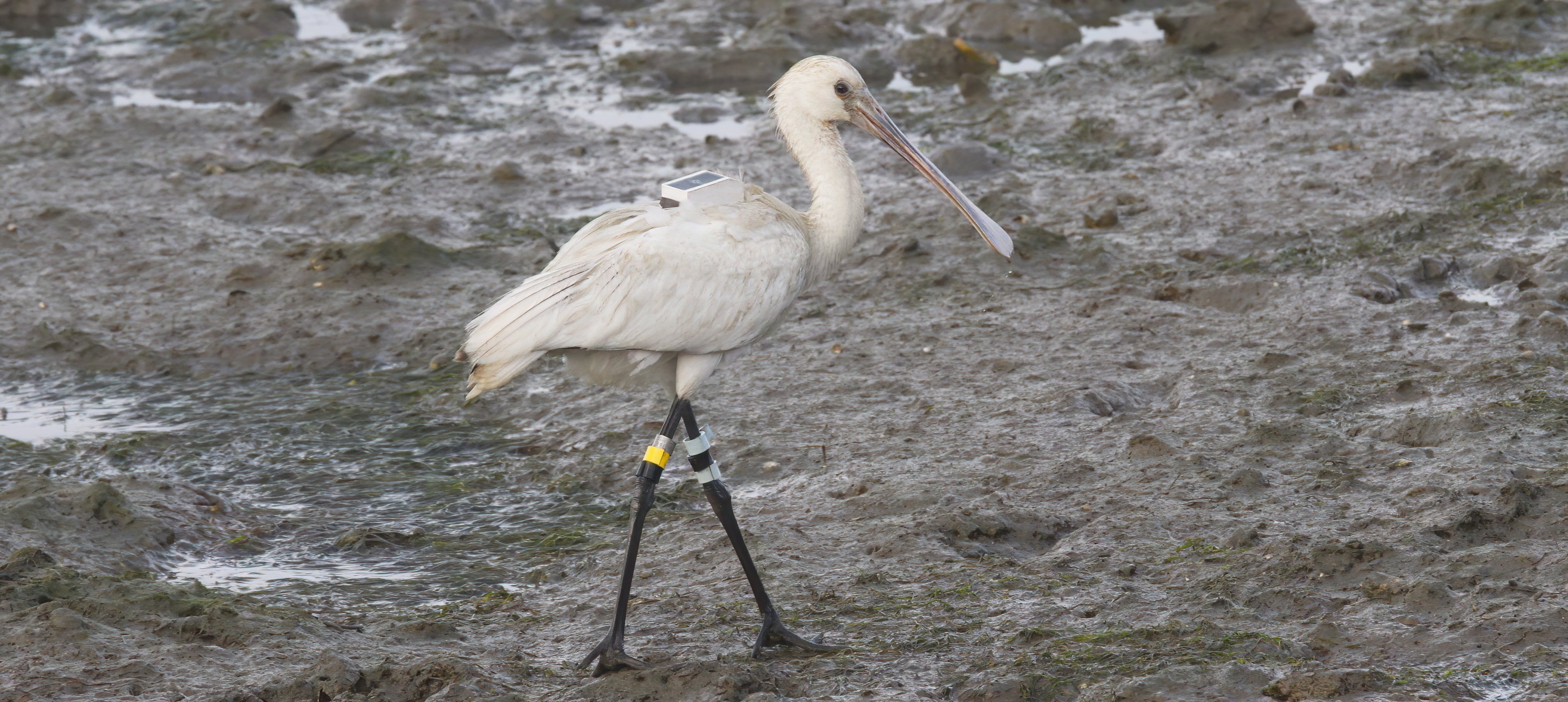
Platalea leucorodia -  Eurasian Spoonbill
Eurasian Spoonbill 
![]() colhereiro-europeu
colhereiro-europeu  kanalasgém
kanalasgém
(Faro, Doca de Faro)
● spoonbills are very well equipped in the Algarve
● seen here and there some birds, but a really big group only in Ludo
● 4 colour ring combinations observed on legs (small photo):
1. (Doca de Faro) Left: White (flag) - Black - White; Right: Metal (I think the code is 3965) - Yellow - Black
2. (Ludo) Left: Yellow - Yellow - White; Right: Green - White - Red
3. (Ludo) Left: White (code: 5R); Right: ?
4. (Ludo) Left: Yellow - Red - Green (?); Right: Blue - White - Yellow (flag)
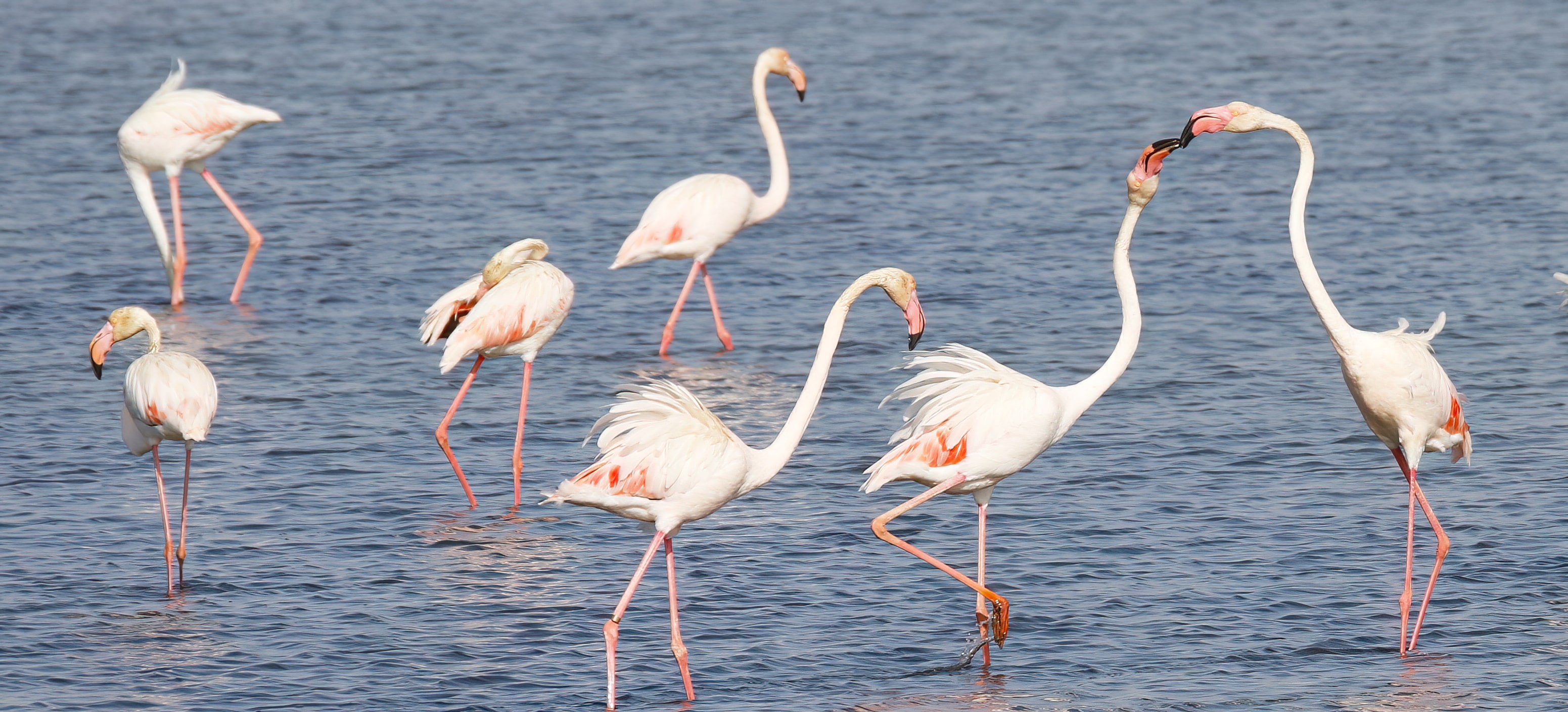
Phoenicopterus roseus -  Greater Flamingo
Greater Flamingo 
![]() flamingo-comum
flamingo-comum  rózsás flamingó
rózsás flamingó
(Tavira, salt pans and lagoons)
● probably the most emblematic, popular and celebrated birds in the region
● most of the salt pans, lagoons and lakes of Ria Formosa are inhabited by flamingos
● the largest and tight groups found in Tavira and in Ludo
● some coded rings on legs:
1. (Ludo) Left: 2|IXD; Right: Metal
2. (Ludo) Left: 1|4F; Right: Metal
3. (Ludo) Left: 0|ZRX; Right: ?
4. (Ludo) Left: 5|CA; Right: -
![]()
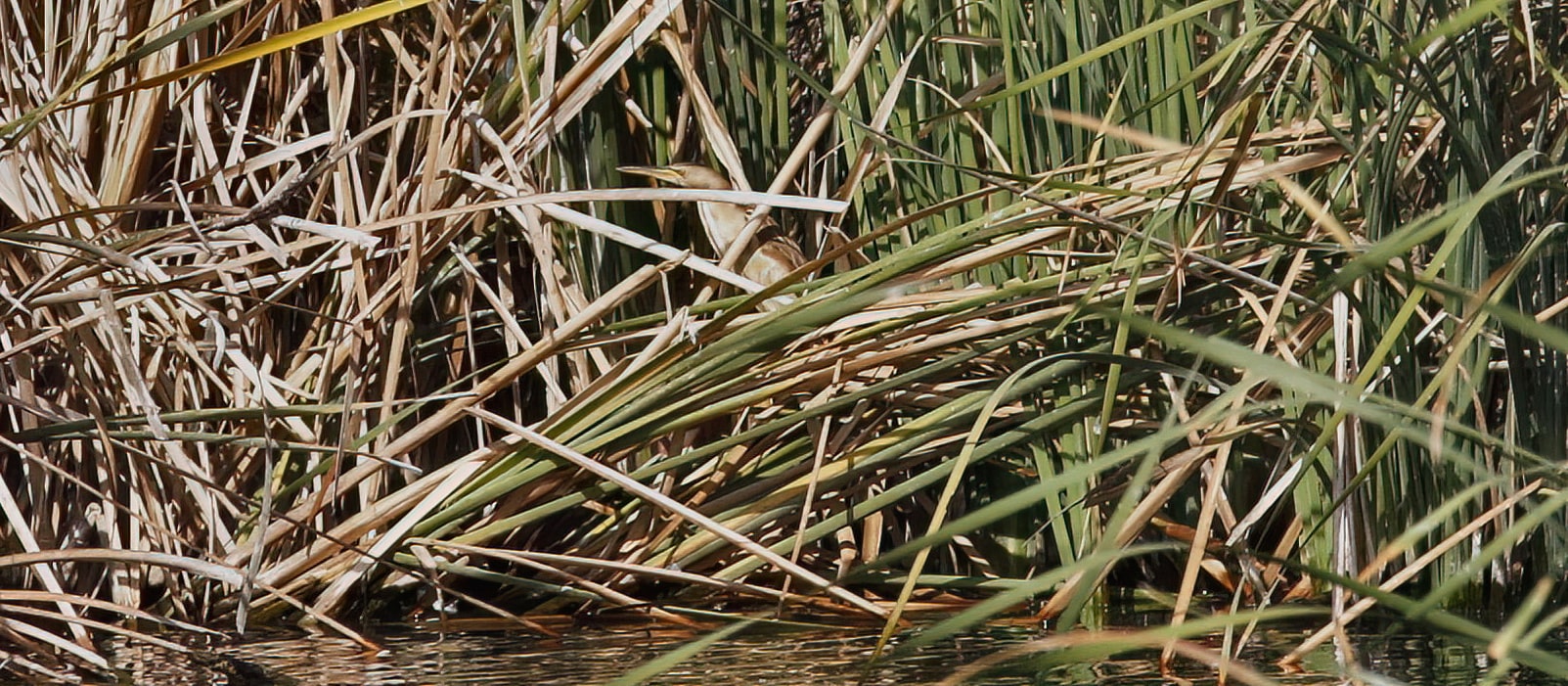
Ixobrychus minutus -  Little Bittern
Little Bittern 
![]() garçote-comum
garçote-comum  törpegém
törpegém
(Faro, Quinta do Lago)
● seen two standing in reeds in Quinta do Lago and one flown over in Vilamoura reedbeds
● not an uncommon but elusive bird in the Iberian Peninsula
● plant: Typha latifolia - Broadleaf Cattail, széleslevelű gyékény
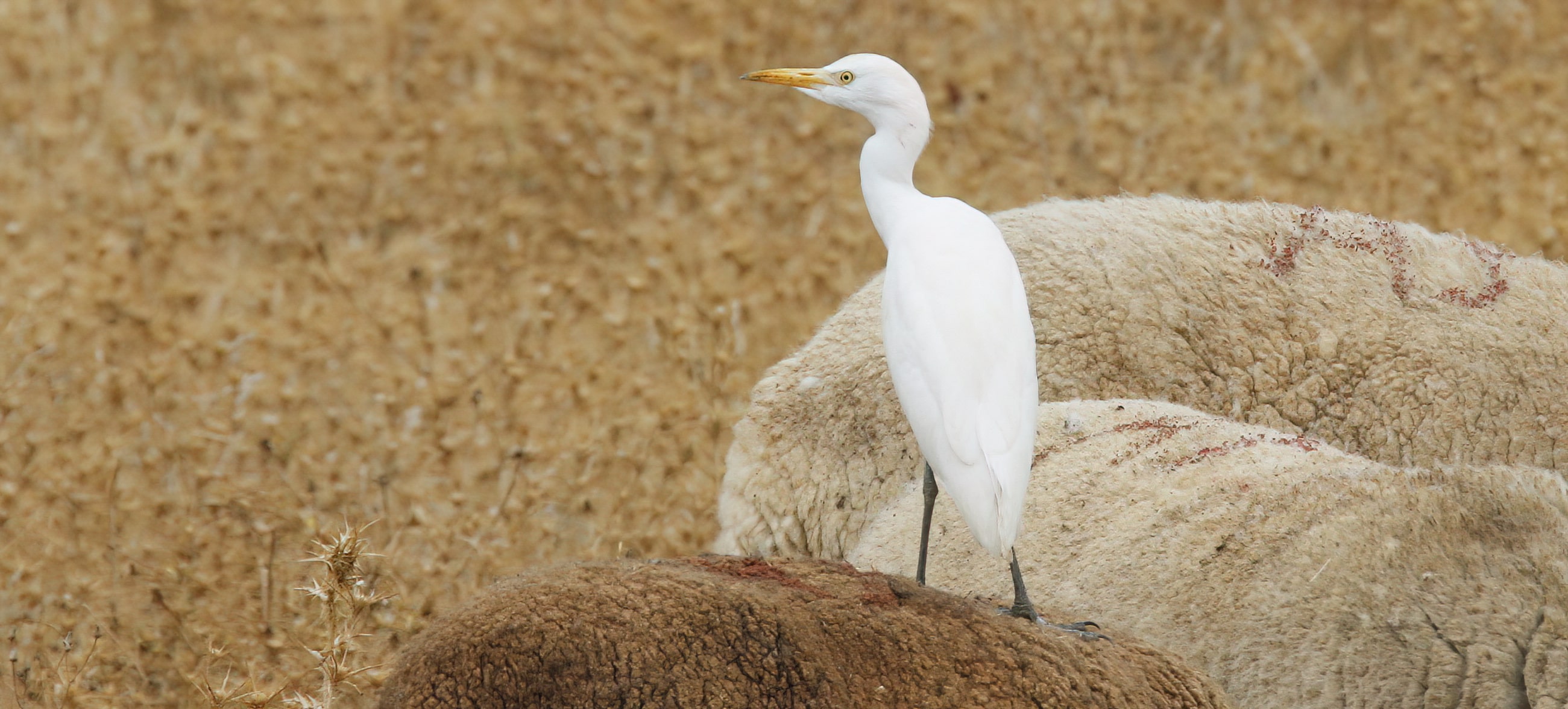
Bubulcus ibis -  Cattle Egret
Cattle Egret 
![]() garça-vaqueira
garça-vaqueira  pásztorgém
pásztorgém
(Castro Marim, pastures)
➤ hunting around grazing sheeps ➤
● common in arid grassfields especially with livestock
● 2 other Ardeidae species were really numerous in most places: Ardea cinerea - Grey Heron and Egretta garzetta - Little Egret
● Ardea alba - Great White Egret is mostly absent from the Iberian Peninsula, supposedly increasing, I didn't see one
● Cattle Egret is common in small groups even in city parks, roundabouts, etc:

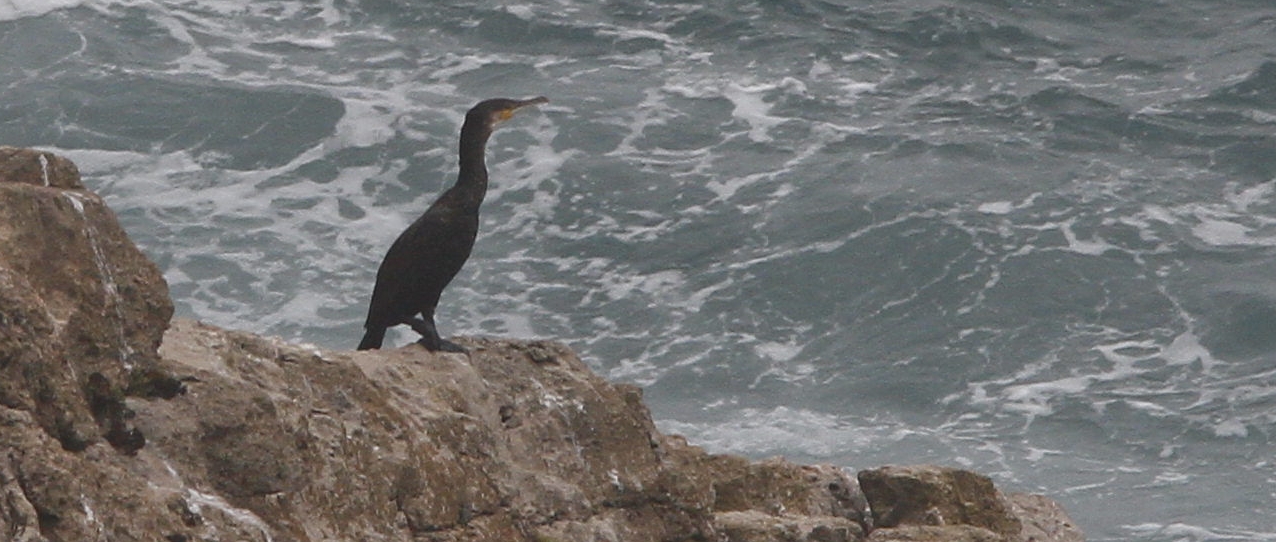
Phalacrocorax carbo carbo -  North Atlantic Great Cormorant
North Atlantic Great Cormorant 
![]() corvo-marinho-de-faces-brancas
corvo-marinho-de-faces-brancas  é-atlanti nagy kárókatona
é-atlanti nagy kárókatona
(Cabo de São Vicente, coastline)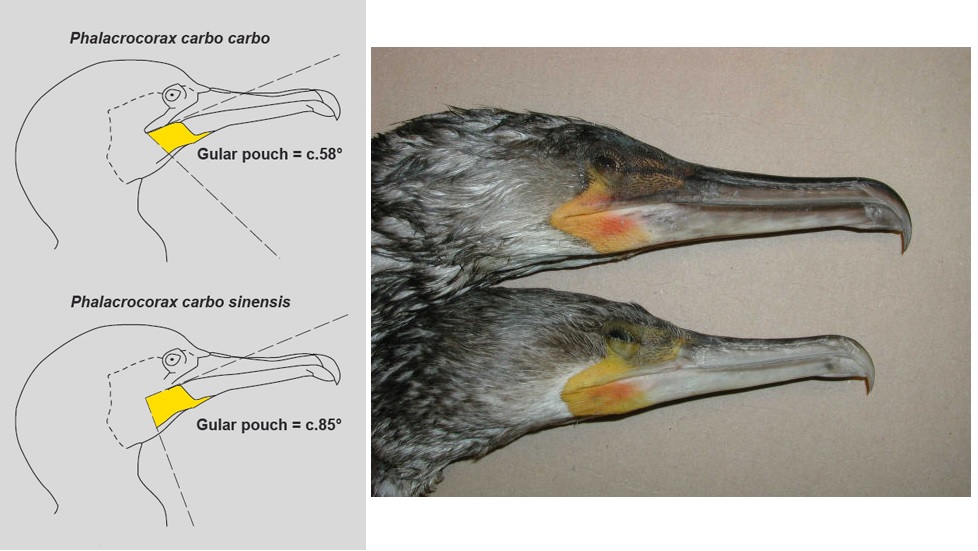
● ssp carbo: coastline habitat in Atlantic region, acute angle gular pouch, darker colors and larger in size than sinensis
● most of my observed Great Cormorants were P. carbo sinensis, 1-2 individual of P. carbo carbo seen in Lagos, Cabo de São Vicente and Vilamoura
● identification was usually doubtul, here is a good source of informations: ref
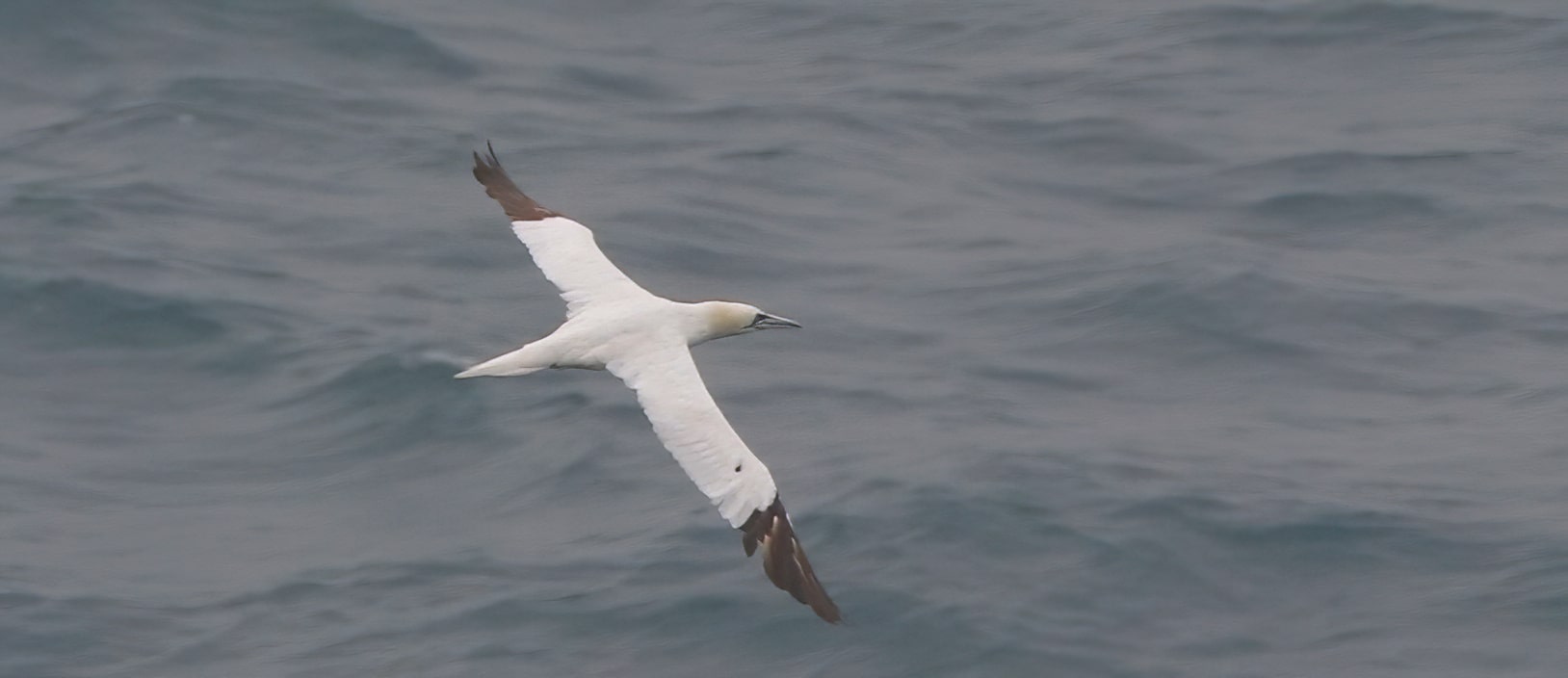
Morus bassanus -  Northern Gannet
Northern Gannet 
![]() ganso-patola
ganso-patola  szula
szula
(Cabo de São Vicente, coastline)
● always in open sea habitat, seen from the coasts of the Sagres region and one from Praia de Faro
● 3 juveniles (Lagos, Cabo, Faro), 1 moulting immature (Cabo), the others were adult birds
● its breeding region is at much Northern coastlines and islands, rarely breeds in Italy, but never in Portugal

Sterna sandvicensis -  Sandwich Tern
Sandwich Tern 
![]() garajau-de-bico-preto
garajau-de-bico-preto  kenti csér
kenti csér
(Vila Real de Santo Antonio, river Guadiana)
● seen many times, e.g. in Faro lagoons, Tavira salt pans, Lagos beach, Olhão beach, Vilamoura, Castro Marim
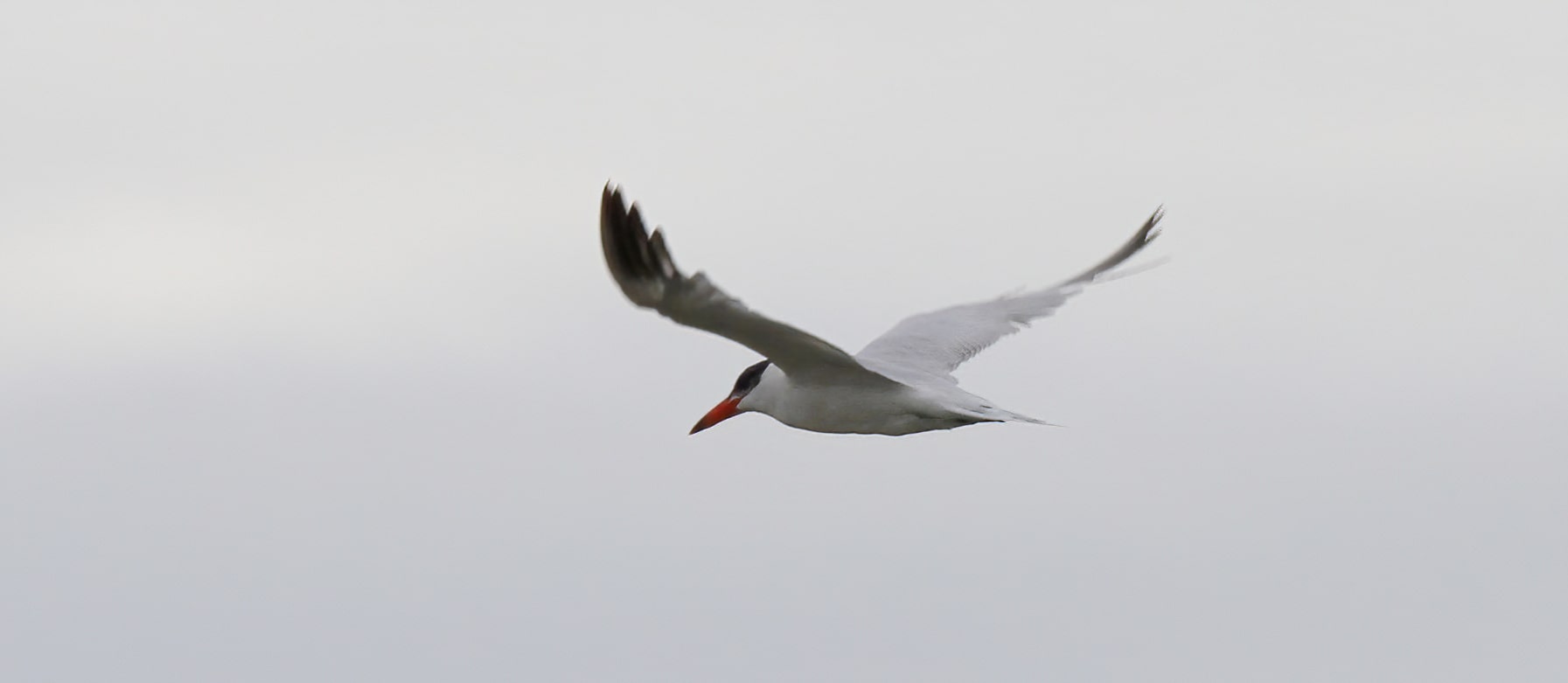
● except Chlidonias leucopterus - White-winged Tern (fehérszárnyú szerkő) all of the European Sternidae occur in Southern Portugal, but in this season I only found Sterna sandvicensis - Sandwich Tern (kenti csér), and rarely Sterna caspia - Caspian Tern (lócsér) (see small pic taken in Olhão) and Chlidonias niger - Black Tern (kormos szerkő) (Quinta do Lago) in the Algarve
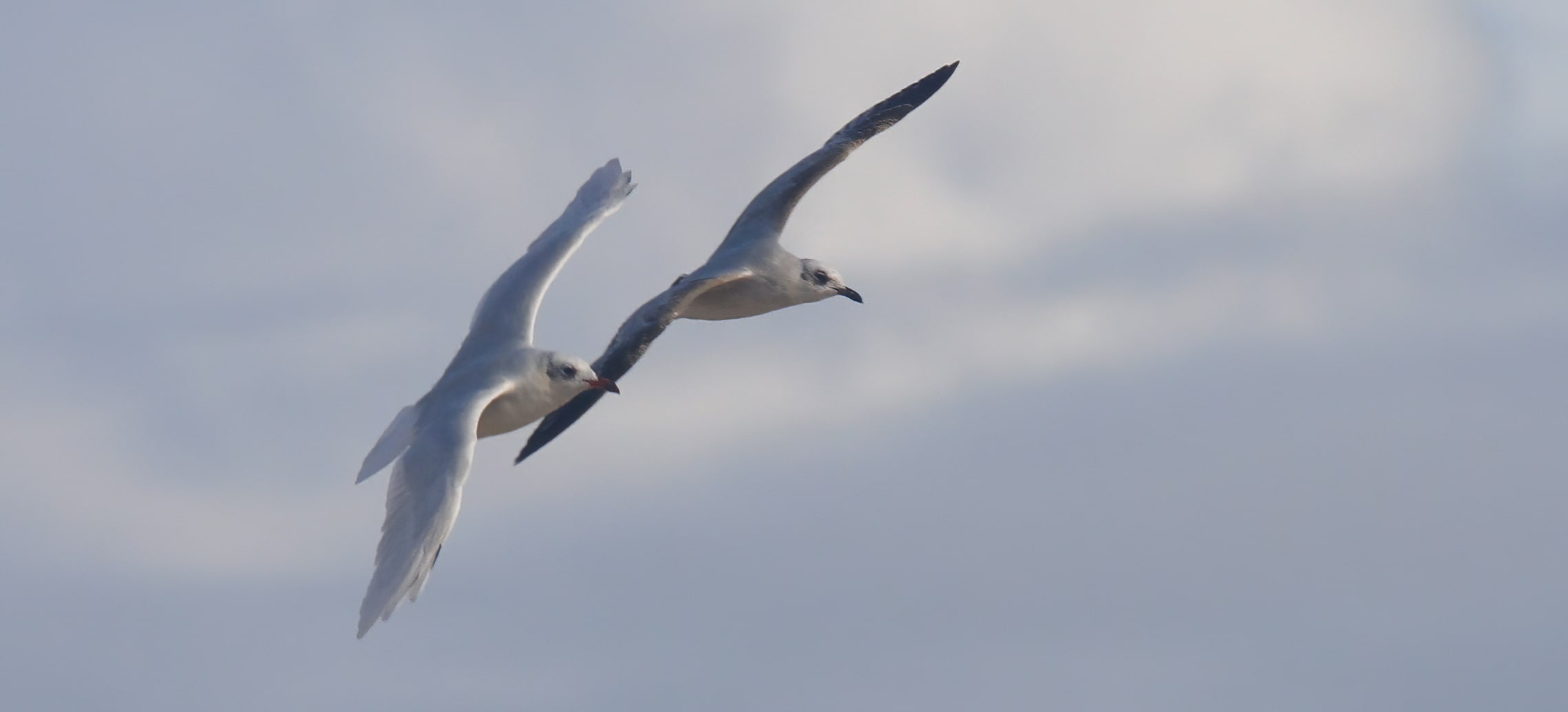
Ichthyaetus melanocephalus -  Mediterranean Gull
Mediterranean Gull 
![]() gaivota-de-cabeça-preta
gaivota-de-cabeça-preta  szerecsensirály
szerecsensirály
(Faro, Praia de Faro)
● a pair is on patrol around the crowded beach of Faro (adult and 1st CY birds in winter plumage)
● can be found only in autumn and winter in the Algarve
● originally had a limited distribution range at the Black Sea and Eastern Mediterraneum
● according to the Helm Identification Guide (Gulls of Eu, As and N Am), European territories of the Mediterranean Gull had a dramatic expansion boom to W and NW European regions since the 40's, nowadays widespread in Western and Central Europe
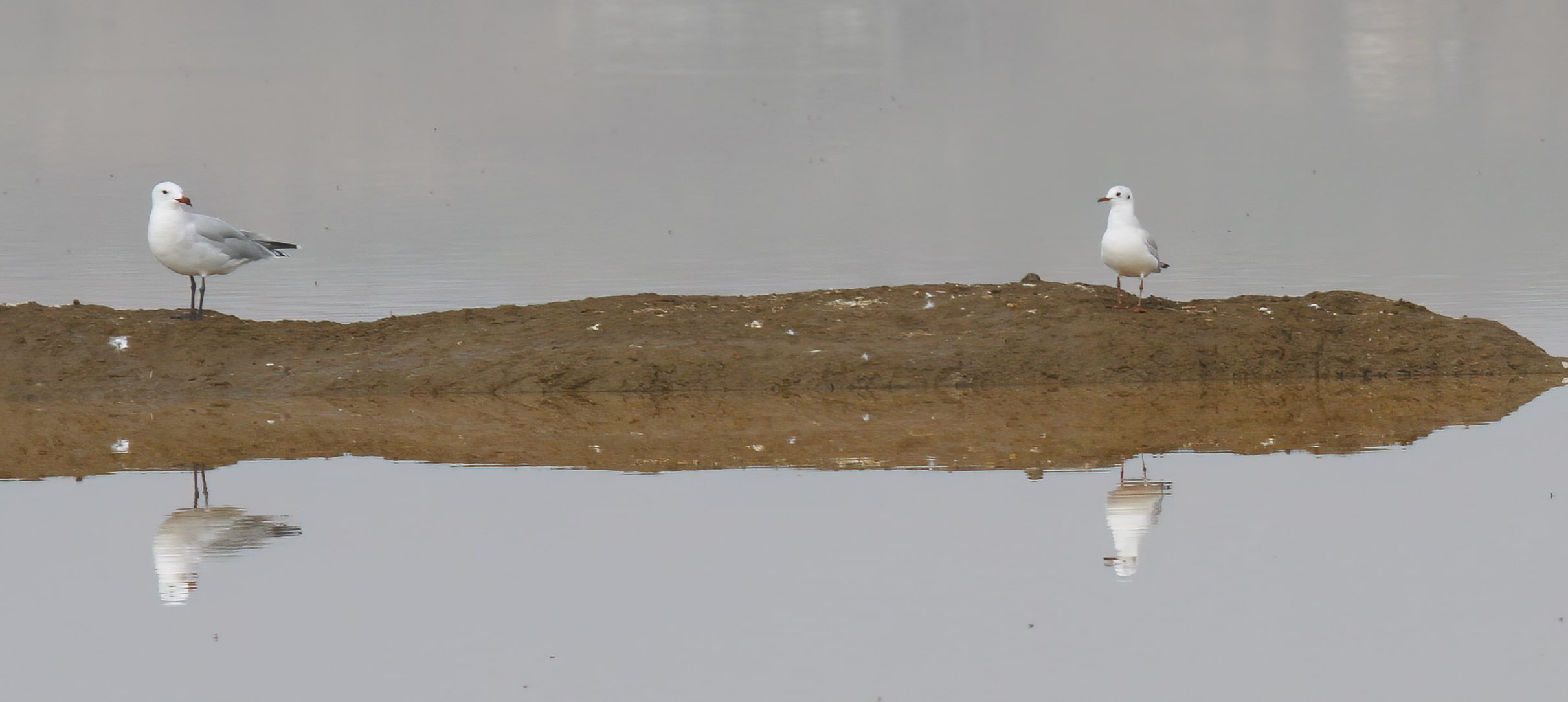
Ichthyaetus audouinii -  Audouin's Gull
Audouin's Gull 
![]() gaivota-de-audouin
gaivota-de-audouin  korallsirály
korallsirály
(Castro Marim, salt pans)
● with a Black-headed gull (C. ridibundus ridibundus) (dankasirály) on the right for comparison to Audouin's Gull (both are in adult winter plumage):
- larger (general body size is somewhere between the 'large gulls' and the 'small ones')
- dark legs and eyes
- no spots on ear and head in winter plumage
- larger and stronger red bill with a ringed tip
- no white on leading edge of wings in flight and much more black on wingtips
● a well recovering population of the formerly critically endangered gull species can be found in the Southern coastline of Iberia
● about a thousand pairs left in the 60's, today their estimated number is about ten thousand pairs
● because of its strict fish eating diet found strictly near pelagic or coastal regions
● I saw a larger mixed group in the salt pans of Tavira (mixed with L. fuscus graellsii, L. michahellis and C. ridibundus), a single bird in Ludo (amongst a small group of C. ridibundus) and two birds in Castro Marim (also in a mixed group)
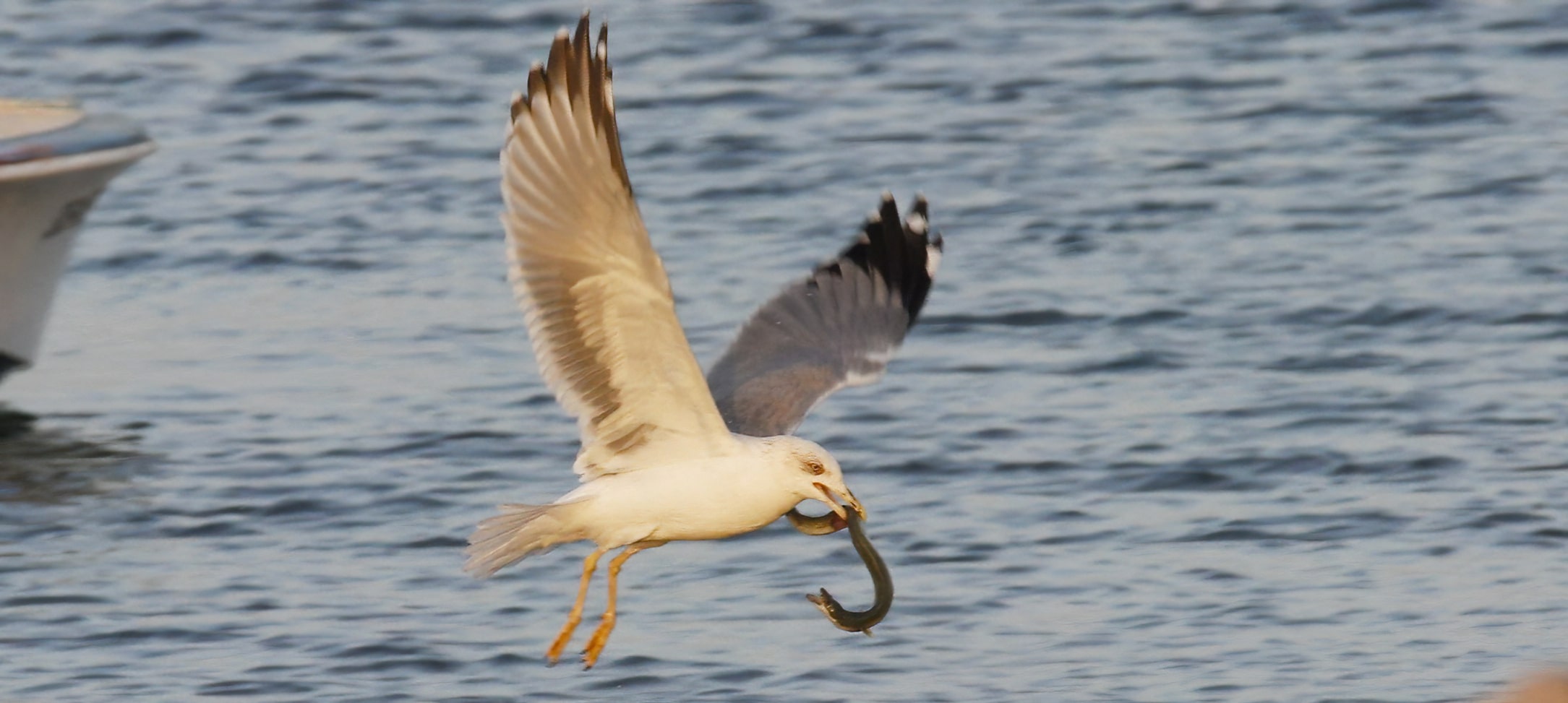
Larus michahellis michahellis -  Yellow-legged Gull
Yellow-legged Gull 
![]() gaivota-de-patas-amarelas
gaivota-de-patas-amarelas  sárgalábú sirály
sárgalábú sirály
(Faro, Doca de Faro at low tide)
● a 3rd CY bird in winter plumage with a very angry and desperate eel
● the dominant 'large gull' species in the region, seen everywhere in abundant numbers
● some better markers to field identification:
- yellow legs, light yellow iris, red orbital ring
- square-shaped head, strong neck, strong breast, more powerful appearence
- more pronounced gonys (than on L. agrentatus and L. cachinnans), bill is curved from gonys, and the red spot reaches the upper mandible
- narrow striped mask in wintering plumages, fine stripes on neck
- even more black and less white on wingtips than on L. argentatus (agrenteus)
● a recently split subspecies of the Iberian region is mostly debated: L. michahellis lusitanius (Cantabrian Yellow-legged Gull)
● L. m. lusitanius from Bay of Biscay to central Portugal, L. m. michahellis in Mediterranean basin
● L. m. lusitanius: somewhat smaller body sizes, rounder head shape, little bit stronger stripes on head and neck, orange orbital ring (not red), legs can be more pinkish sometimes, no white mirror on P9
● another subspecies, L. michahellis atlantis (Azorean Yellow-legged Gull) is restricted to Macaronesian islands (Madeira, Azores)
● shorter legs, stronger striping around the eyes (except adult summer plumage), broader dark band on tail (here is an authentic and very detailed description of the subspecies by Nelson Fonseca: ref)
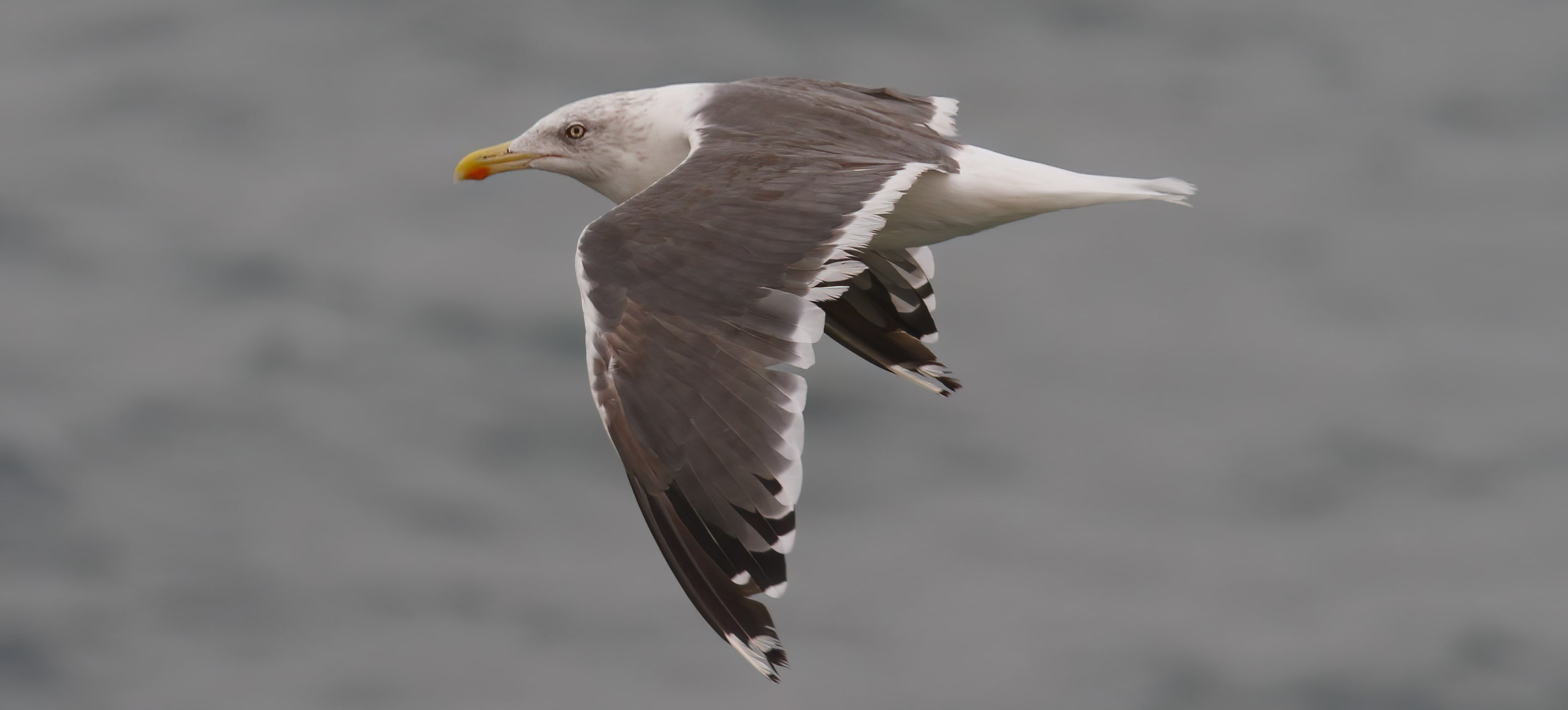
Larus fuscus graellsii -  Lesser Black-backed Gull
Lesser Black-backed Gull 
![]() gaivota-de-asa-escura
gaivota-de-asa-escura  világoshátú heringsirály
világoshátú heringsirály
(Sagres, coastline)
● ssp graellsii: dark slate-grey mantle, the palest race of all in fuscus, restricted in Atlantic regions
● I saw this species mostly in Sagres region, they seemed migrating along the coastline in loose groups
● breeds in N Atlantic coasts, winters in SW Europe and W Africa
● differs from L. argentatus (Herring Gull) by smaller size, longer and narrower wings, weaker bill, yellow legs (a very good picture for comparison by Tim Melling)
● differs from L. michahellis (Yellow-legged Gull) by larger size, wider wingspan, darker mantle, less black on wingtips
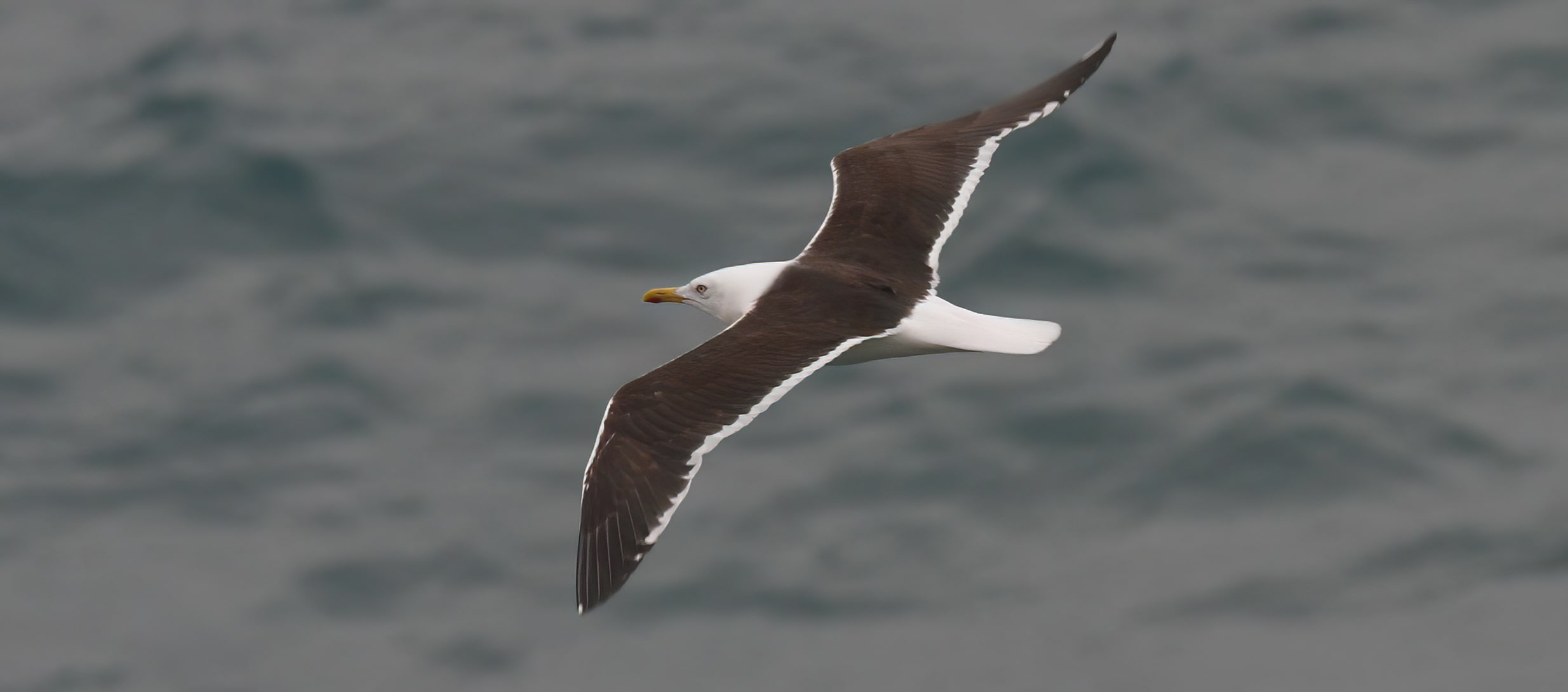
Larus fuscus intermedius -  Lesser Black-backed Gull
Lesser Black-backed Gull 
![]() gaivota-de-asa-escura
gaivota-de-asa-escura  heringsirály
heringsirály
(Sagres, coastline)
● seen just a couple of them among the migrating groups of L. f. graellsii
● because of the 'not-really-pitch-black' color of mantle and because of the rarity of L. fuscus fuscus in SW Europe, I vote on L. fuscus intermedius as a final identification (originally I thought L. f. f.)
● however, on Kodak scale this bird looks like 16-17 or similar... so I still really don't know...
● please, let me know your opinion if you have experience in this topic
● according to this very good source, beyond colors and shapes and all of these stuff, there is a simple main difference between graellsii/intermedius and fuscus fuscus: graellsii/intermedius migrates SW, fuscus fuscus migrates S and SE. I saw 4 in Sagres and 3 in Faro, so according to their frequency in the region all of them were L. f. intermedius.
● nominate ssp fuscus (Baltic Gull): black mantle, no contrast between the same color of mantle and of wingtips, more pointed wings and longer hands, more elegant general shape, more rounded head
● L. f. intermedius: many characteristics as in L. f. graellsii but mantle can be much darker and shows a gradual transition into the 'real-pitch-black' of L. f. fuscus
● a very detailed article on this topic by Andreas Noeske (in German)
● another very good comparison and discussion by Nelson Fonseca
● according to this publication, 90% graellsii, 9% intermedius and 1% fuscus represents the L. fuscus population in Portugal during migration
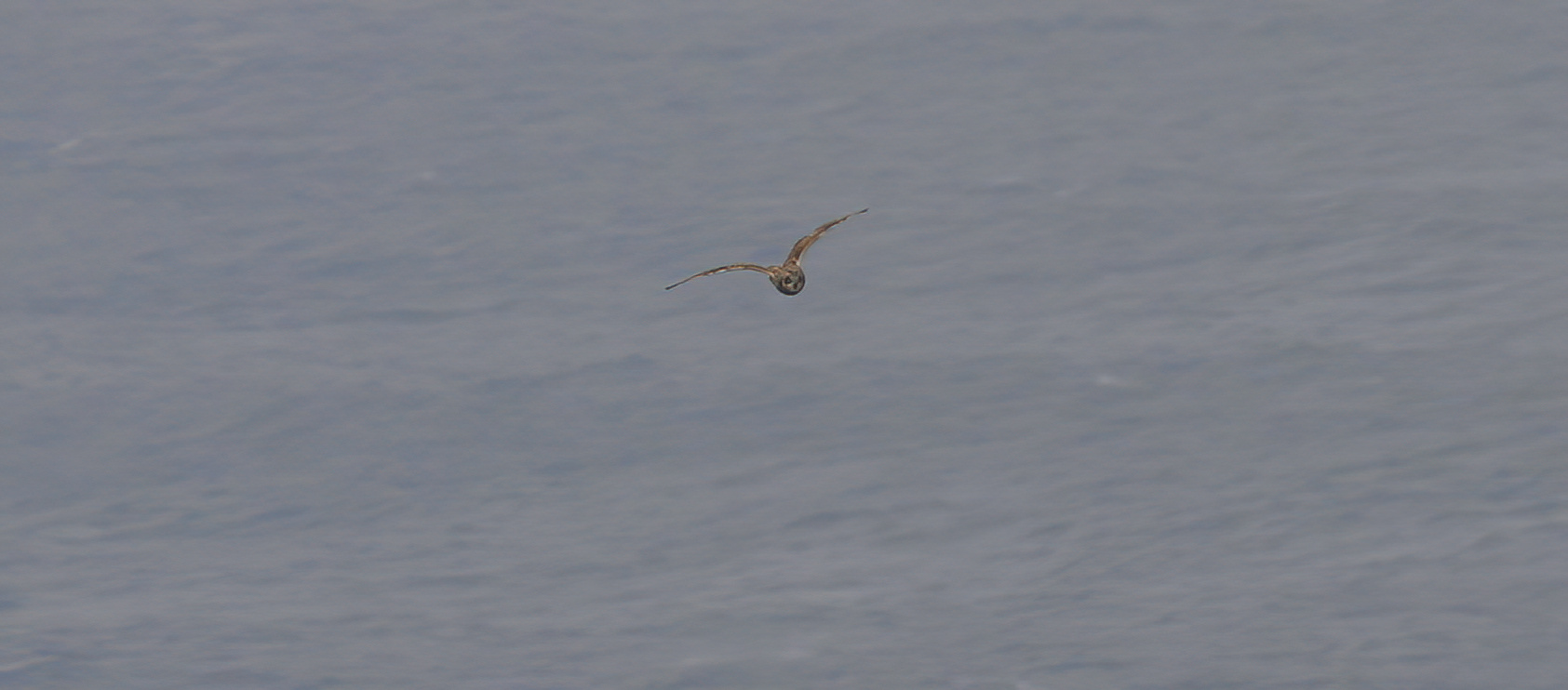
Asio flammeus -  Short-eared Owl
Short-eared Owl 
![]() coruja-do-nabal
coruja-do-nabal  réti fülesbagoly
réti fülesbagoly
(Cabo de São Vicente, at the lighthouse)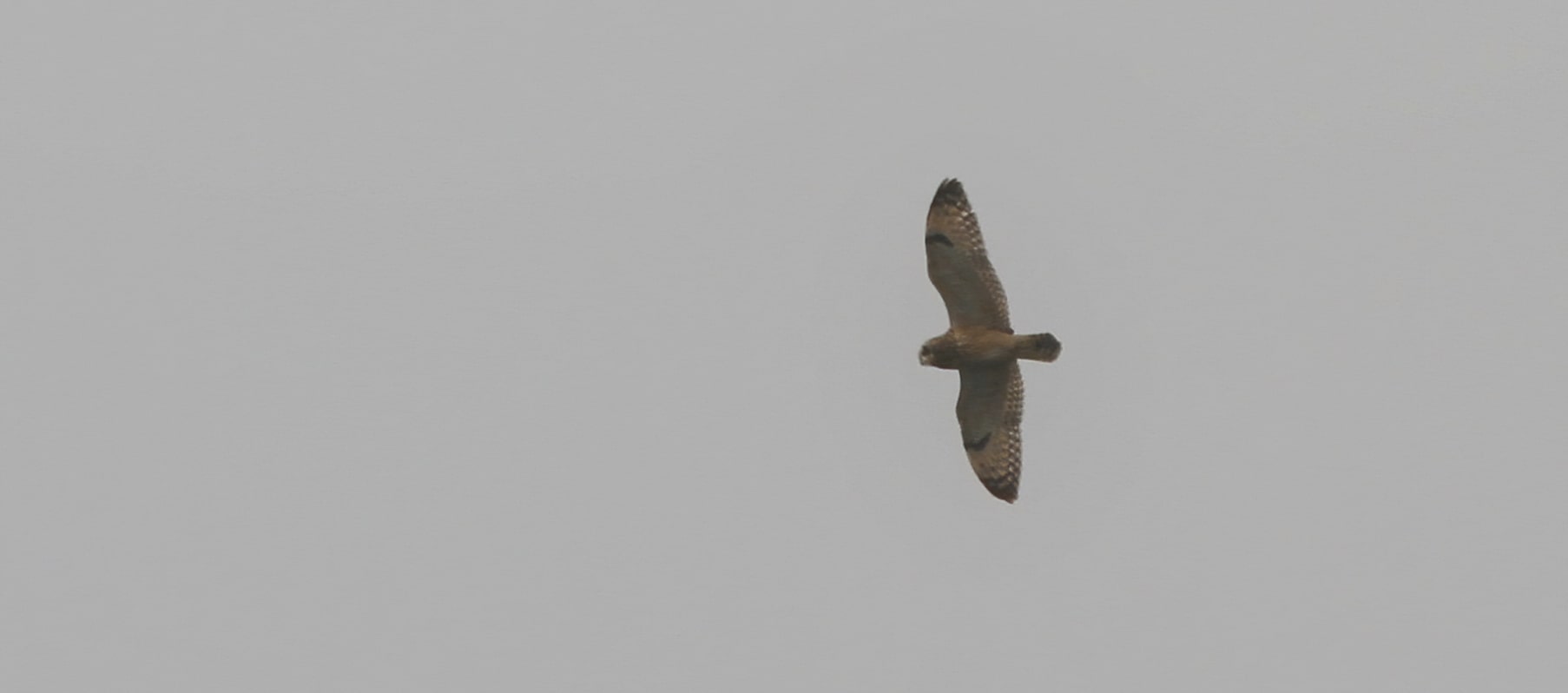
● a single bird flown over the crowded lighthosue building and outermost cliffs of Cabo de São Vicente
● it was a surreal sight to see an owl over the sea
● only migrates here, not a resident bird in Portugal
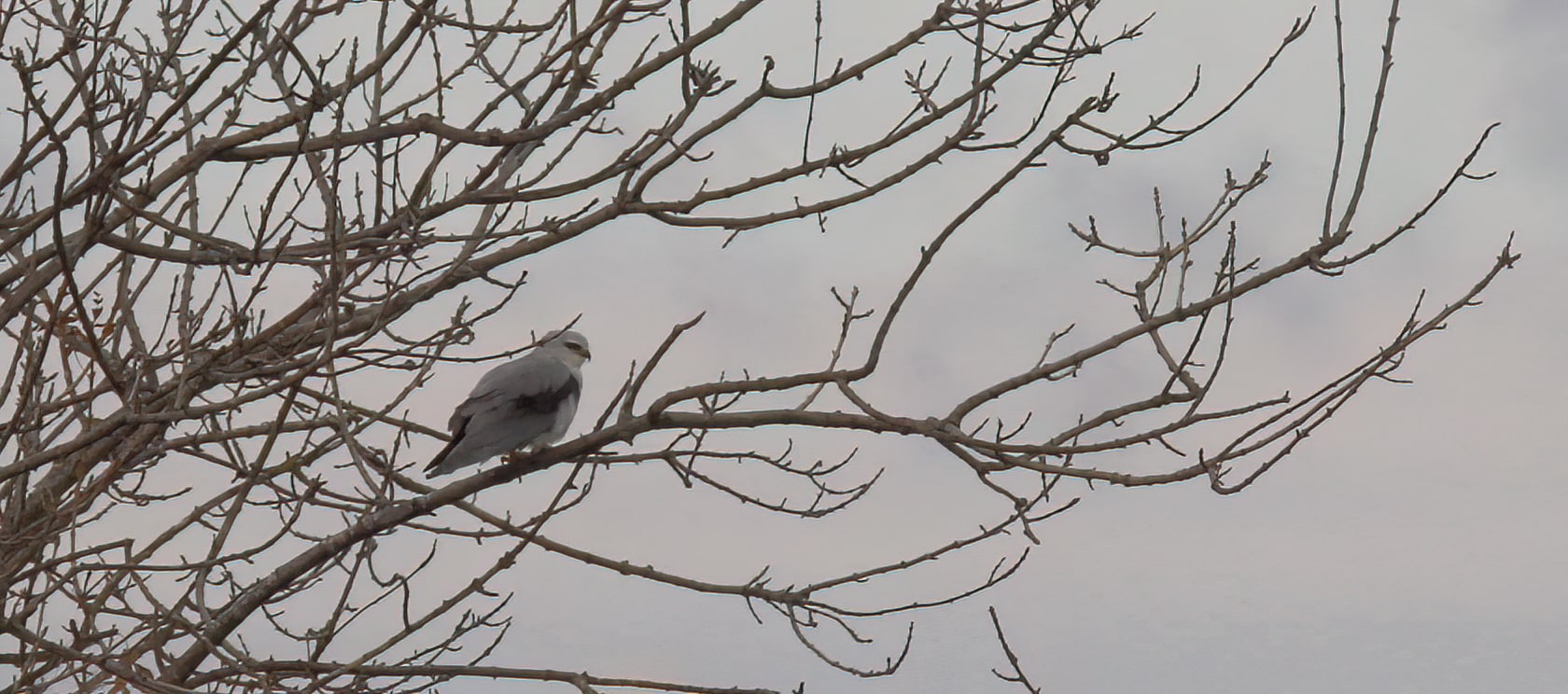
Elanus caeruleus -  Black-shouldered Kite
Black-shouldered Kite 
![]() peneireiro-cinzento
peneireiro-cinzento  kuhi
kuhi
(Vilamoura, Canal de Vilamoura)
➤ hunting in the evening in Vilamoura ➤
● also seen and heard in this and the next video: greenfinches, linnets, stonechats, thrushes
● seen the same bird twice in the same spot (morning and afternoon) (marked on map), stayed in its hunting territory all day long
● Falco species were scarce during the whole tour, only seen a couple of F. tinnunculus - Common Kestrel (vörös vércse) here and there
● Circus species were represented only by C. aeruginosa - Marsh Harrier (barna rétihéja), seen 4 in Vilamoura wetlands and 1 in Castro Marim wet marshes
● Buteo species were rare, too (B. buteo - Common Buzzard (egerészölyv)), found most of them in Castro Marim
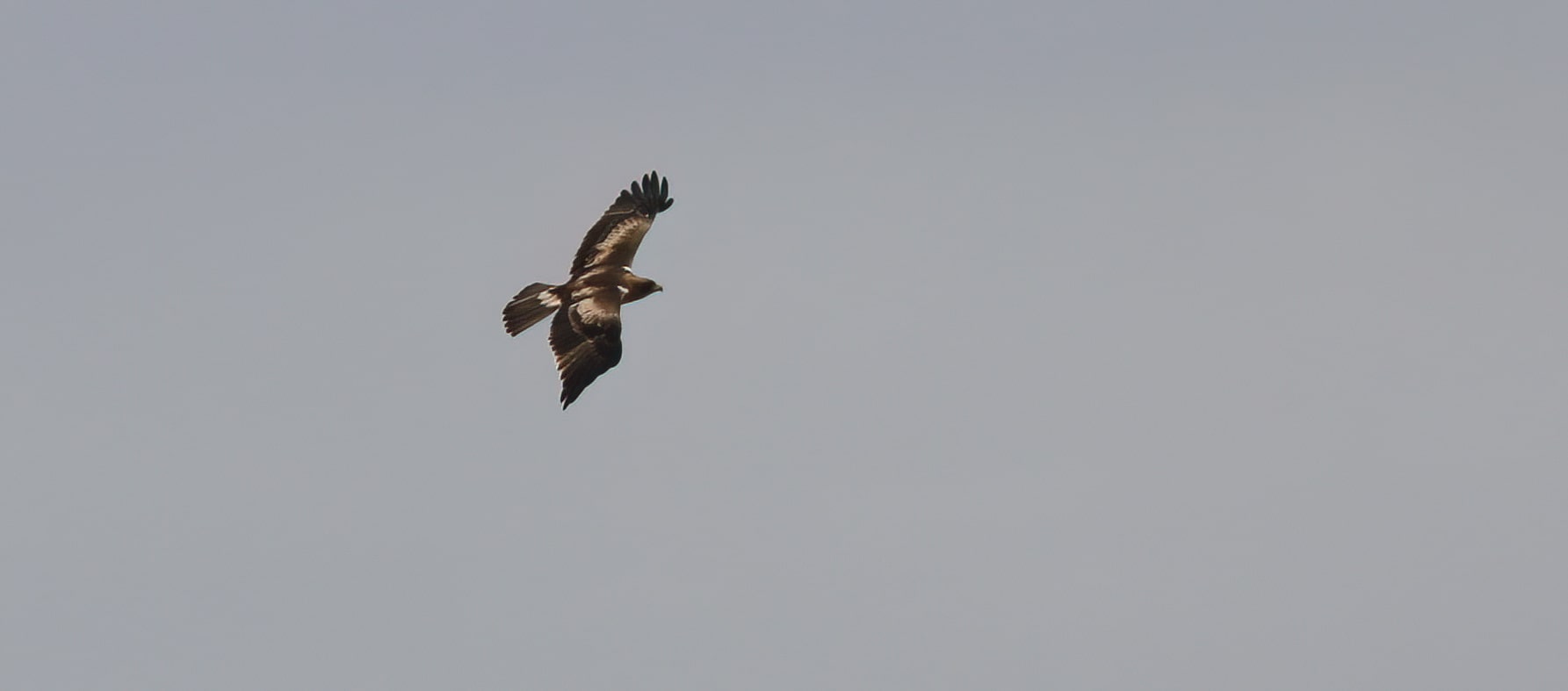
Hieraaetus pennatus -  Booted Eagle
Booted Eagle 
![]() águia-calçada
águia-calçada  törpesas
törpesas
(Vilamoura, Canal de Vilamoura)
● the only eagle species of my week in Portugal
● found two circling above the arid grasslands of Vilamoura in an early afternoon, one of them flew a little bit lower and closer ➤

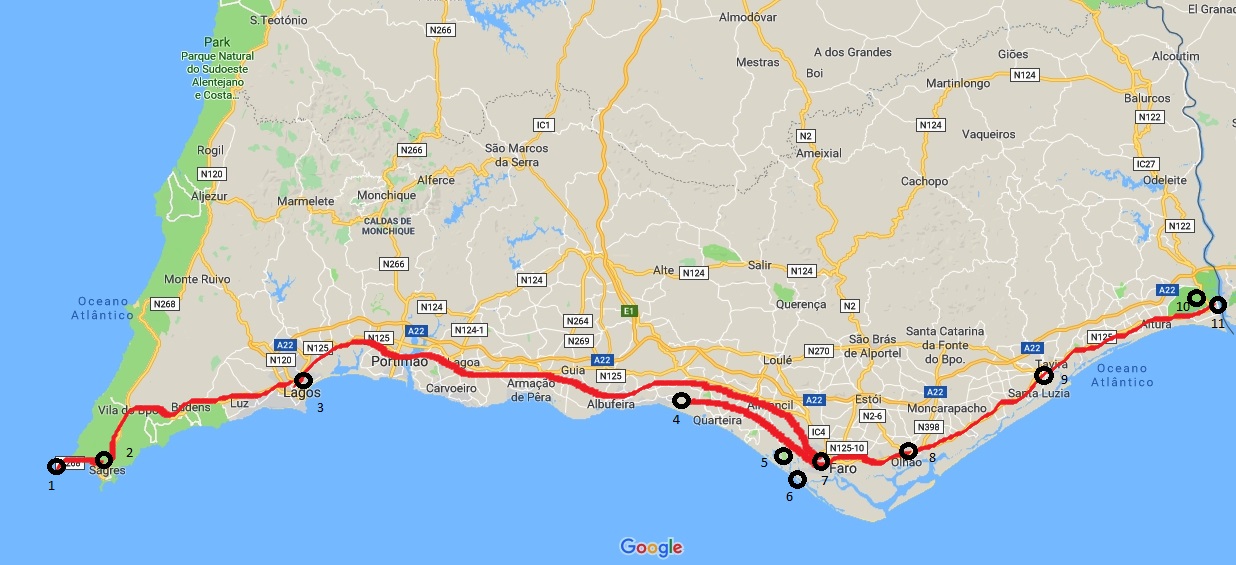
1. Cabo de São Vicente: lighthouse, end of the world, coastline and shrubs
2. Sagres: city with a huge coastal fortress, coastline and shrubs
3. Lagos: port and Meia Praia
4. Vilamoura/Quarteira (one of the most diverse sites I've found): reedbeds, golf courses, plantations, grasslands and Praia Falésia
5. Ludo and Quinta do Lago: salt pans, marshes, golf courses
6. Praia de Faro: beach
7. Faro: city parks, grassfields, lakes, marshes, tidal marshes
8. Olhão (one of the most diverse sites I've found): Quinta de Marim, Ria Formosa N.P.
9. Tavira: salt pans
10. Sapal de Castro Marim, Esteiro da Carrasqueira: marshes, arid grassfields and salt pans
11. river Guadiana: port of Vila Real de Santo António
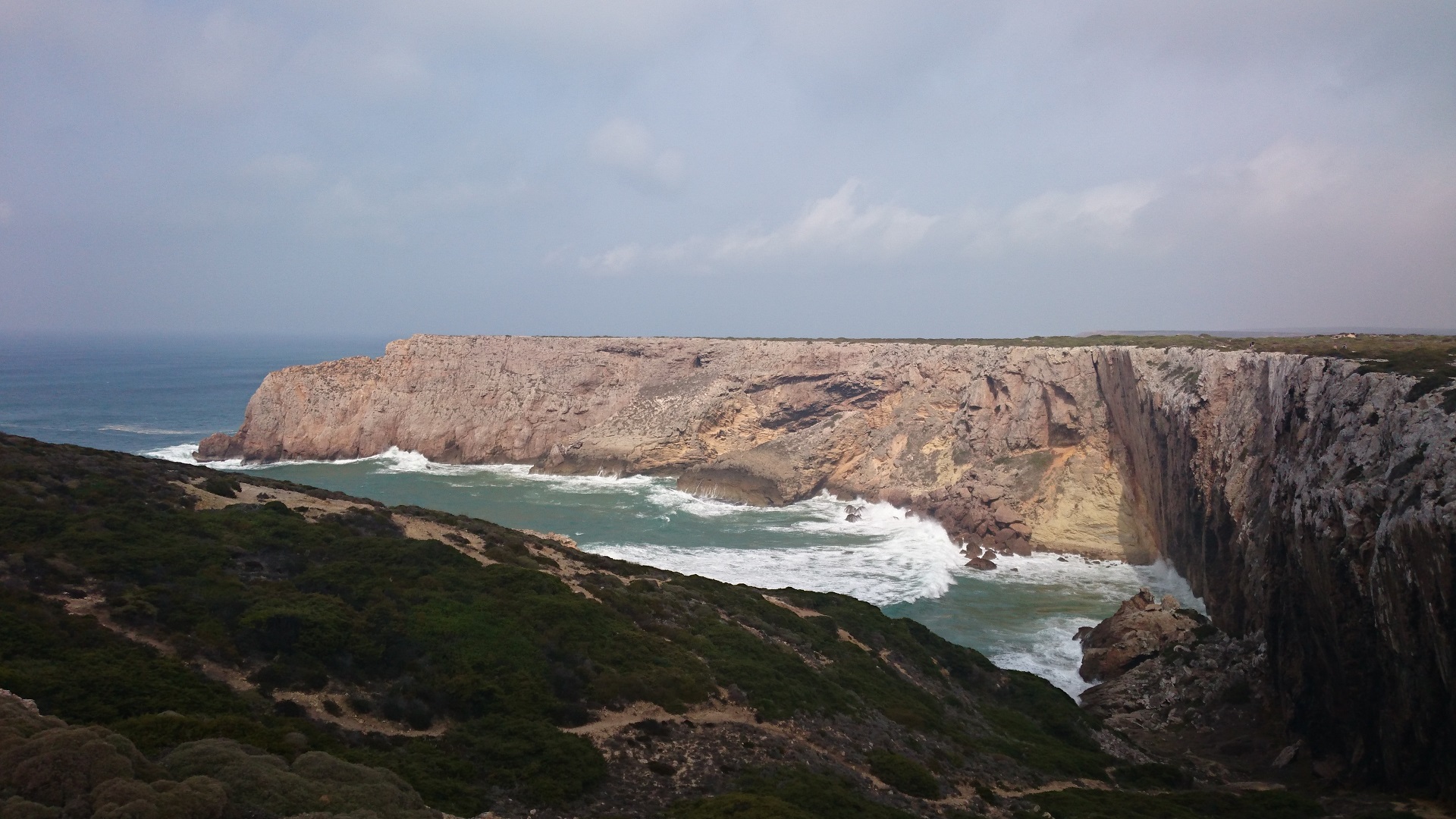
1. Cabo de São Vicente |

2. Sagres |

3. Lagos |
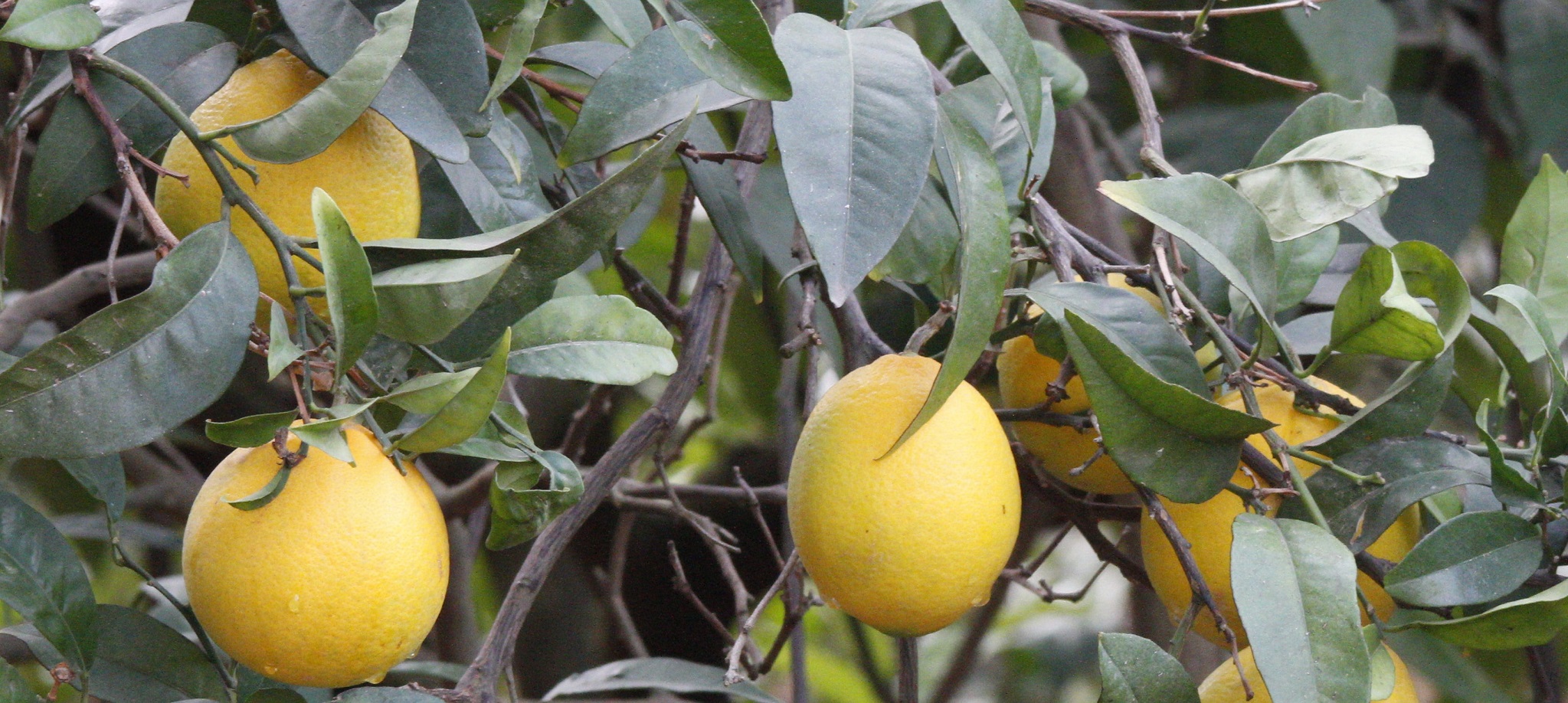
4. Vilamoura |
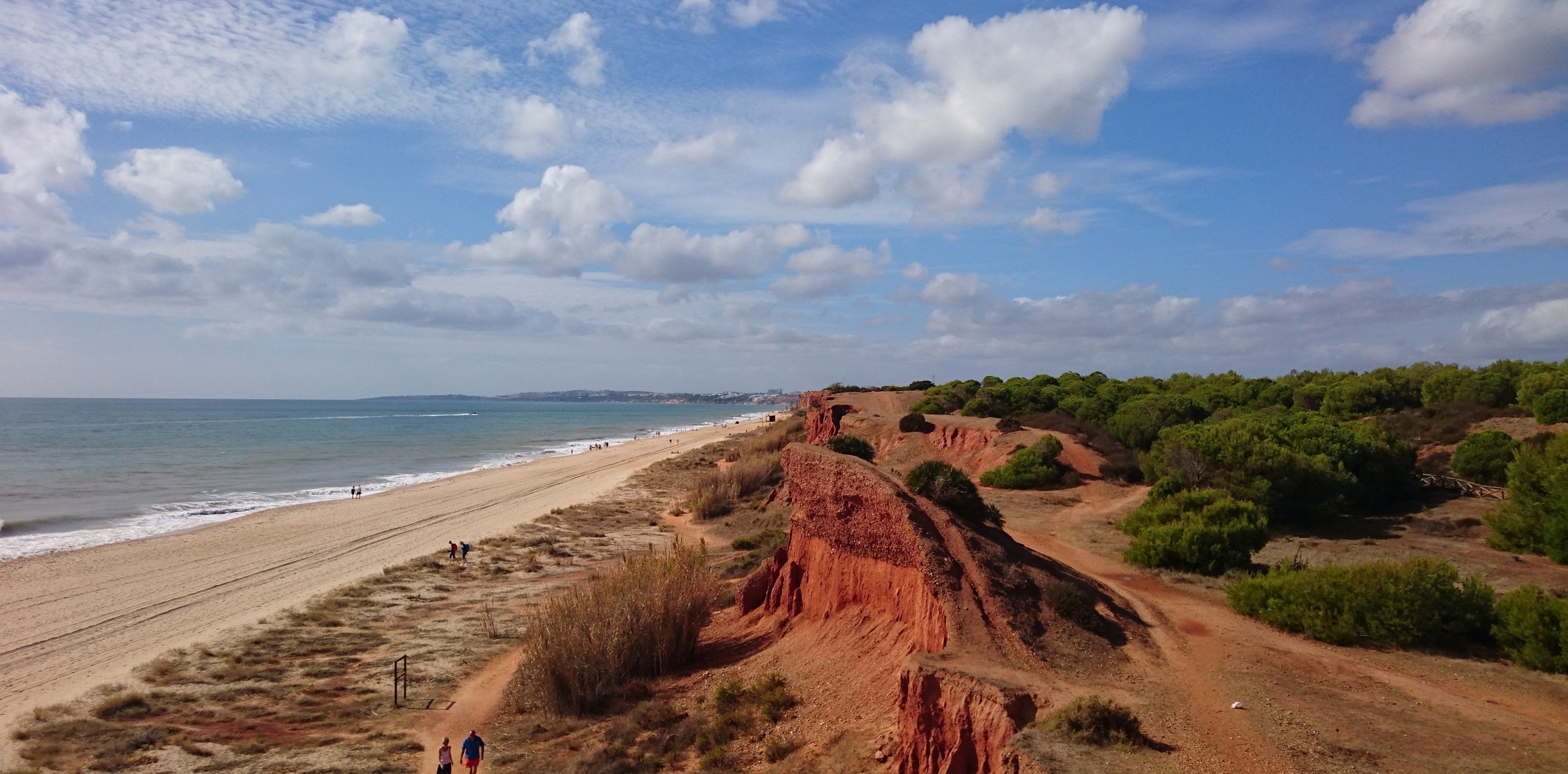
4. Praia Falésia |
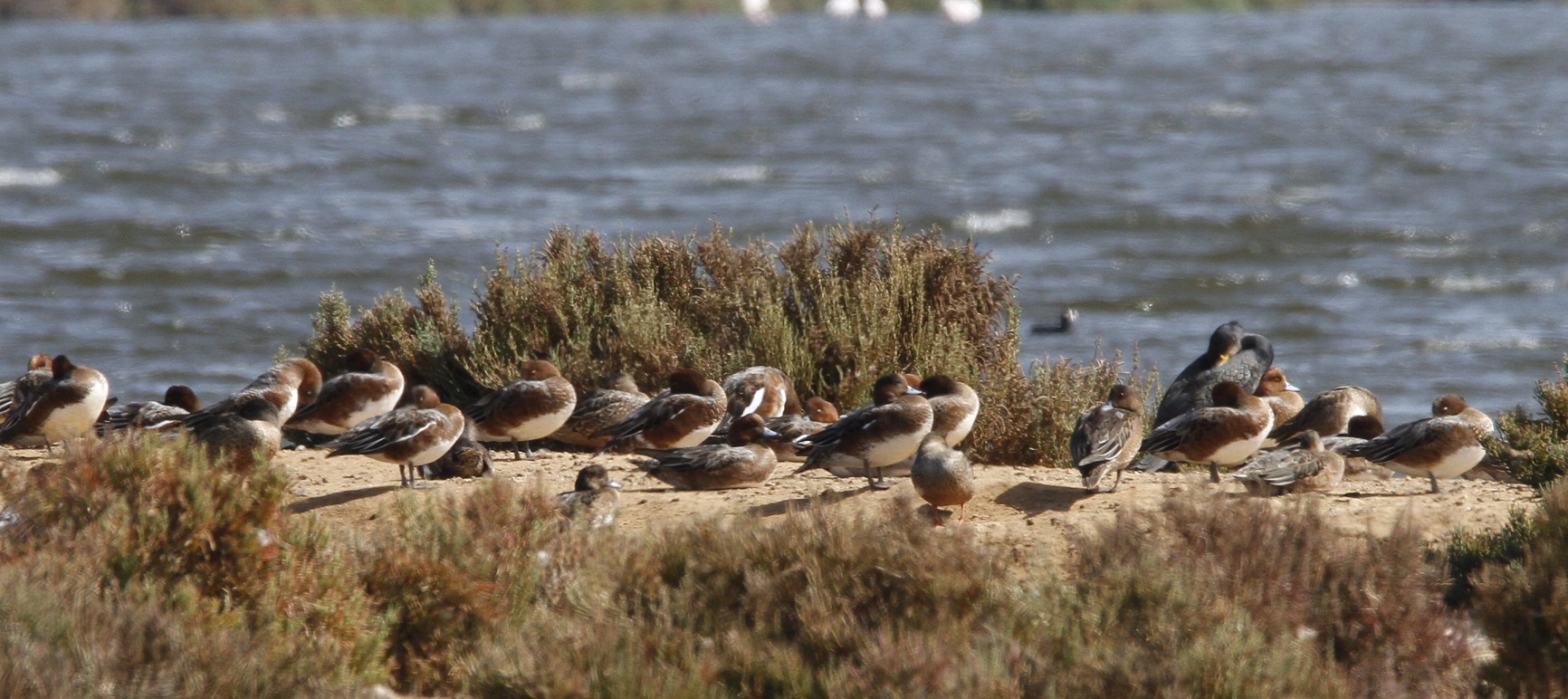
5. Ludo |
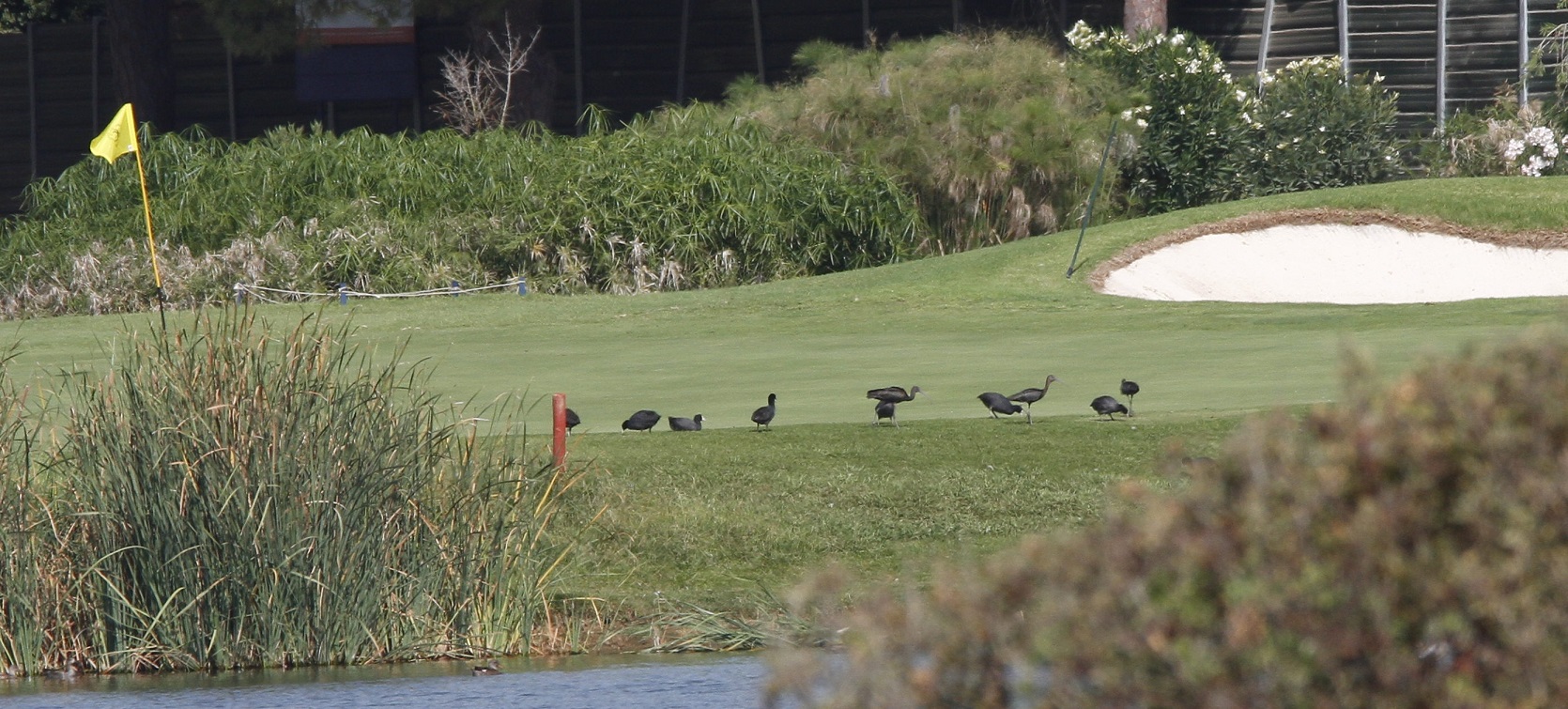
5. Quinta do Lago |
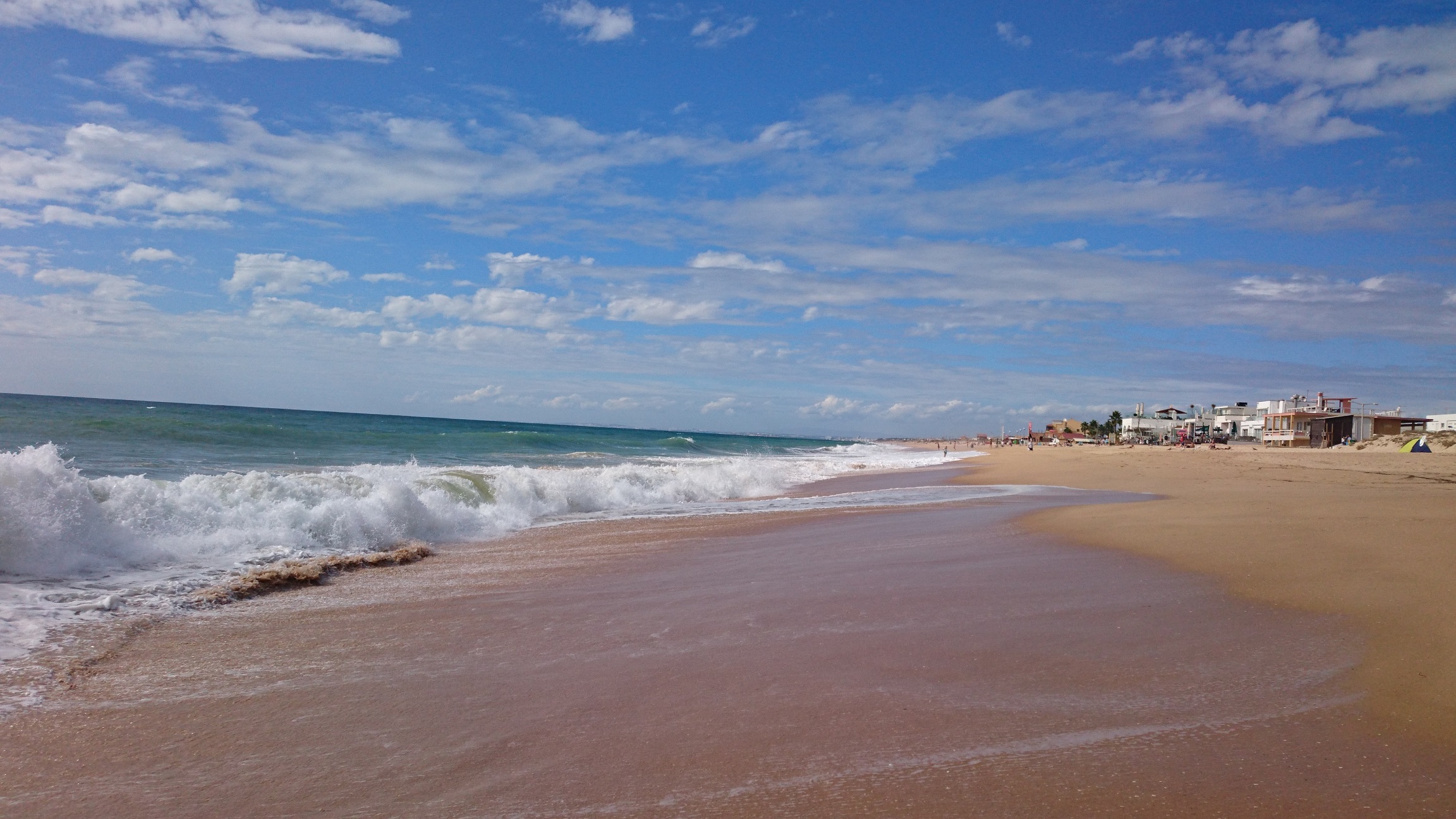
6. Praia de Faro |
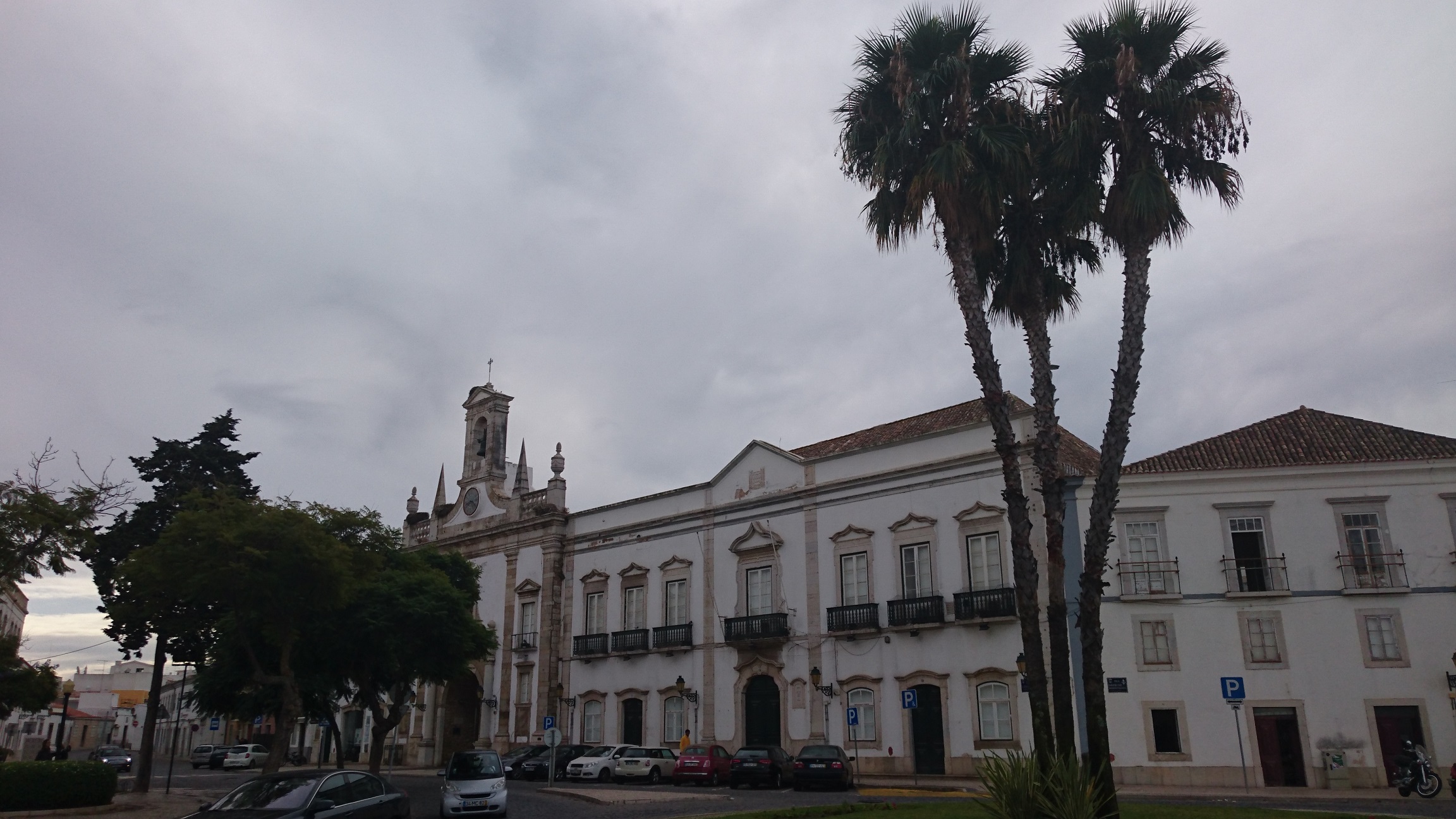
7. Faro |
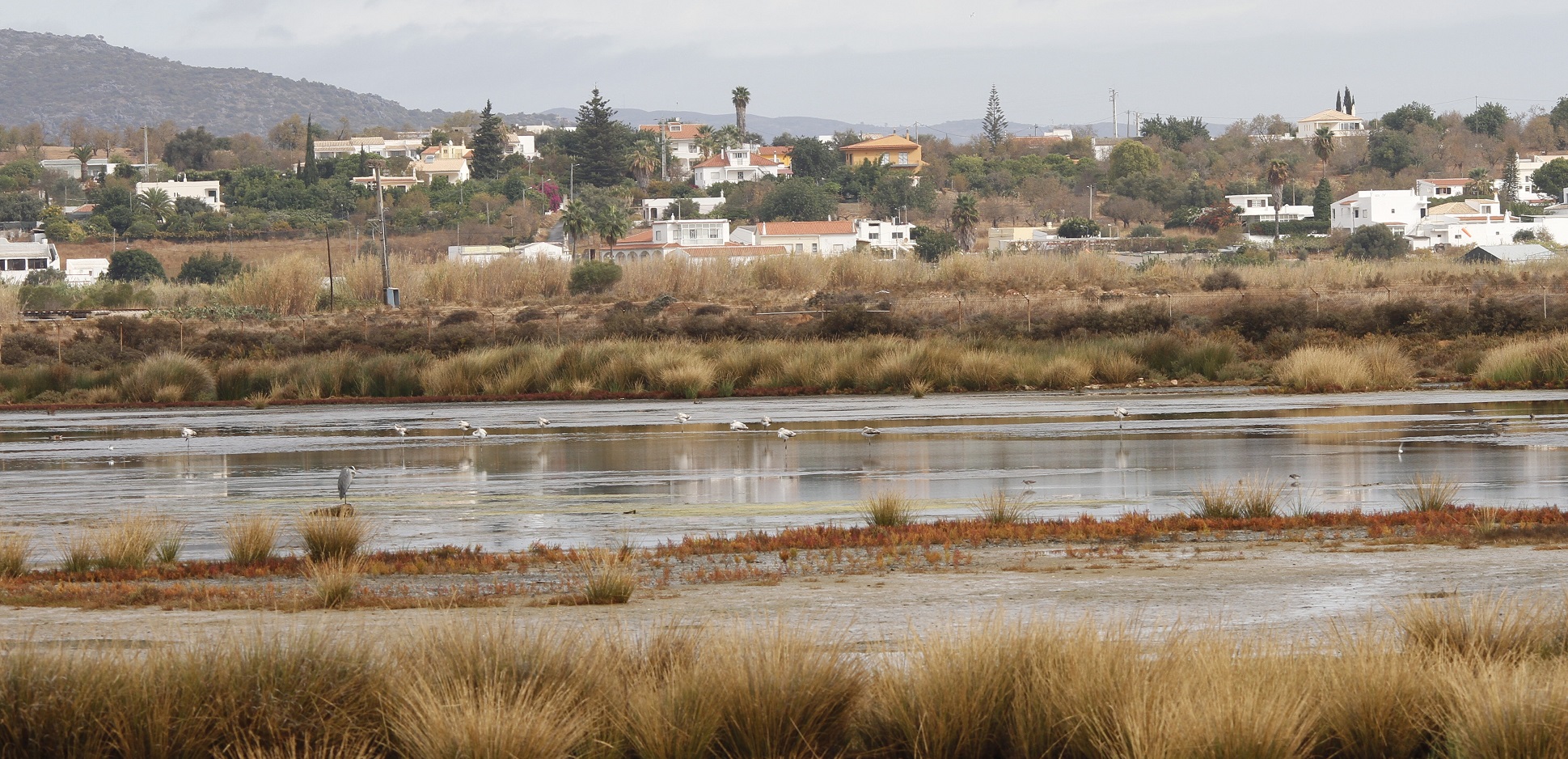
8. Quinta de Marim |
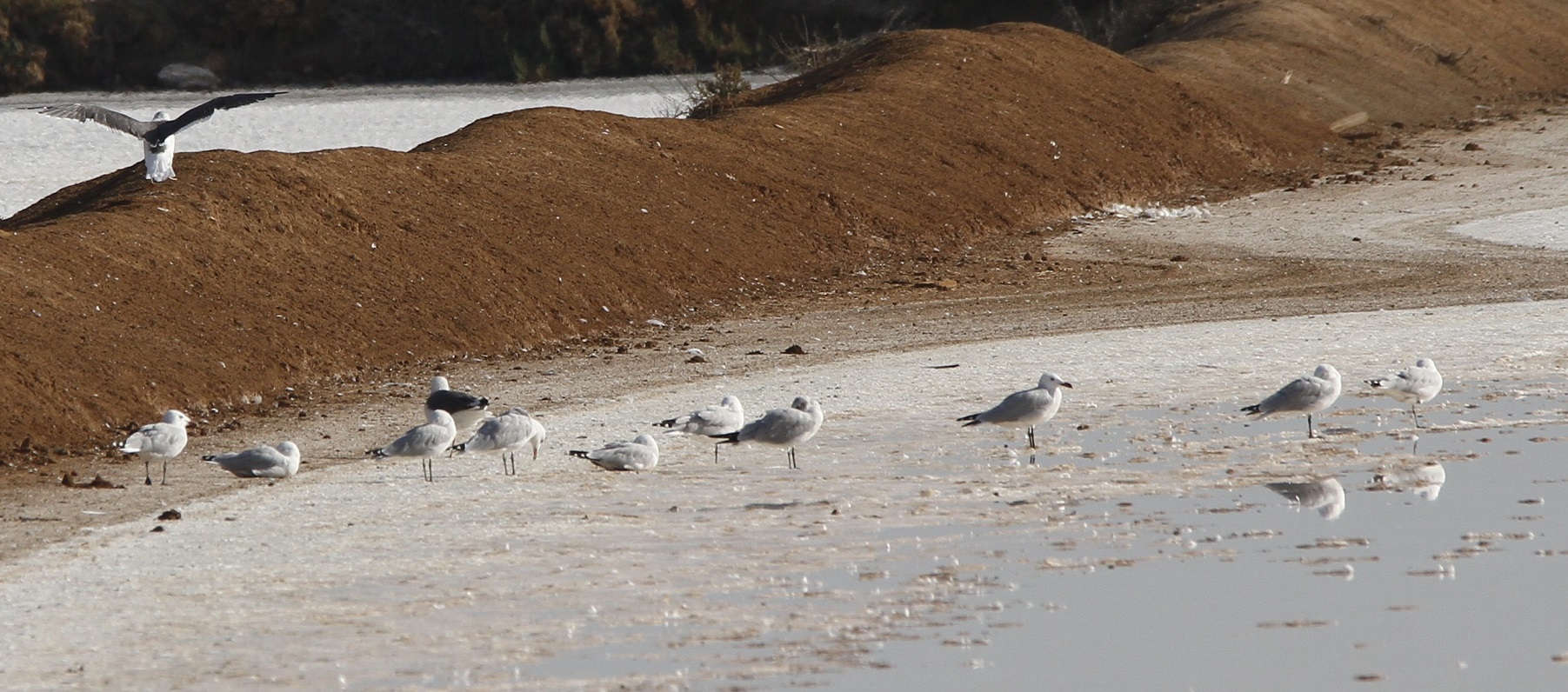
9. Tavira |
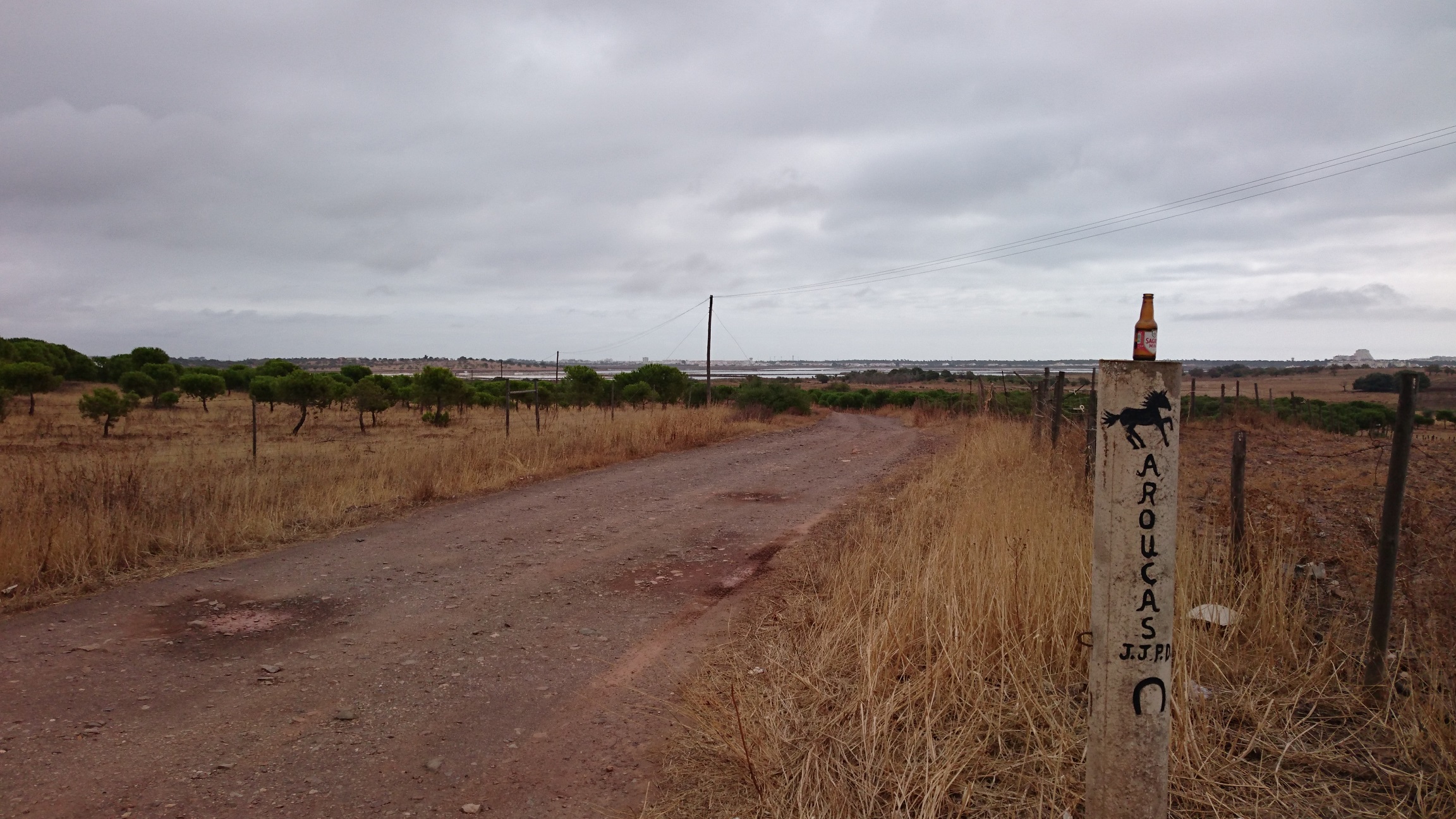
10. Castro Marim |
Overall bird stats and infos:
● 113 bird species of category A were observed in the week, among them it meant for me 24 new species and 15 new subspecies in the WP. There were 2 species Category C (Black-headed Weaver, Waxbill), too.
● Algarve species list (2017, Oct 15-20)
● In case of monotypic bird species, a third Latin name was not signed, otherwise always included.
● Monotypic species in the pdf list are signed with a point after the binomial Latin name.
● None of the birds were baited, set up or called in.
● Map pointer of the observations are accurate.
● I used Portuguese names based on Wikipedia.
Technical info:
● Bird photos were taken with Canon EOS 7D and Sigma 120-400 mm f4.5-5.6 DG OS APO HSM.
● Many pictures were brightened afterwards by GIMP, a complete renovation of pictures was made in Jan of 2024.
● Many pictures were also somewhat denoised or sharpened afterwards (Topaz Labs AI), cropping images and minor additional optimizations were made by IrfanvView and GIMP, and finally file sizes were reduced by the free online COMPRESS JPEG.
![]() Phoca.cz free flag icon bundle (16-12px) has been used at translation of names (source). Here, slightly adapted 13-10px dimensions and somewhat darkened versions were applied.
Phoca.cz free flag icon bundle (16-12px) has been used at translation of names (source). Here, slightly adapted 13-10px dimensions and somewhat darkened versions were applied.
![]() Portuguese language audio content is based on the online Textmagic, Free text to speech tool (source), voice: "Hanna".
Portuguese language audio content is based on the online Textmagic, Free text to speech tool (source), voice: "Hanna".
Any comments or suggestions for corrections would be greatly appreciated.

